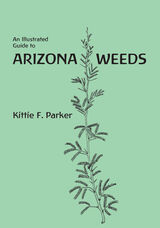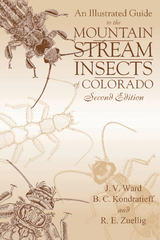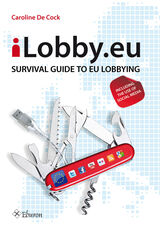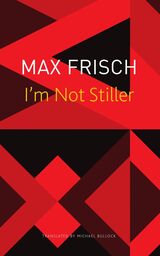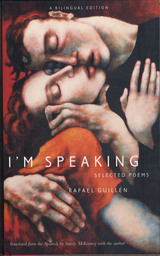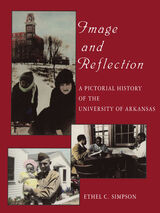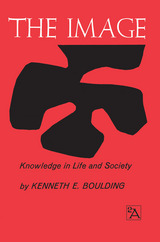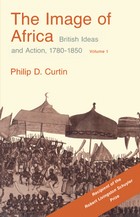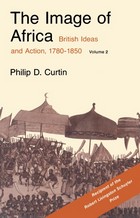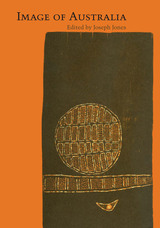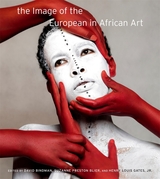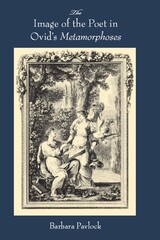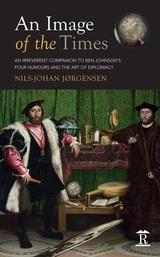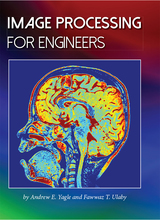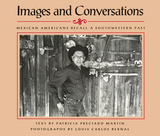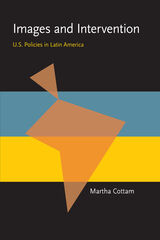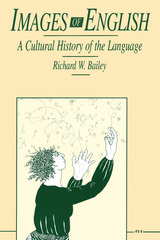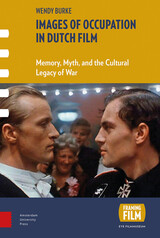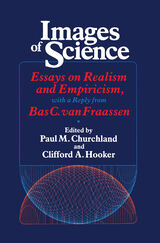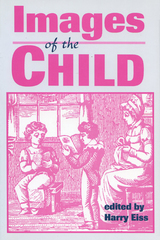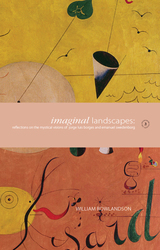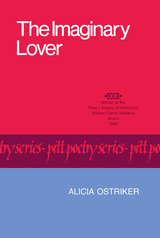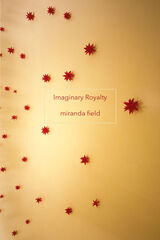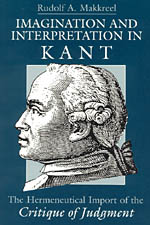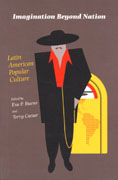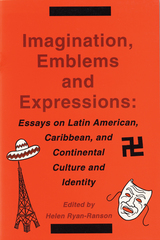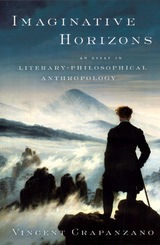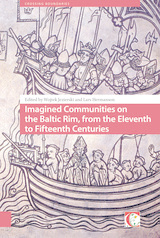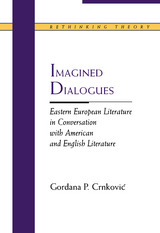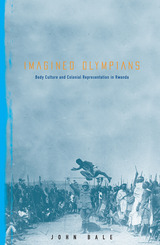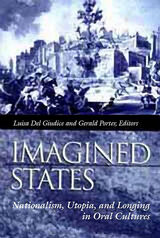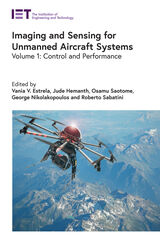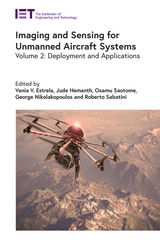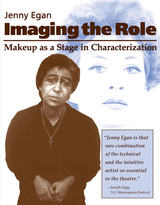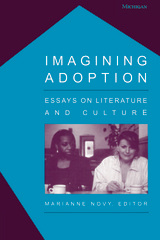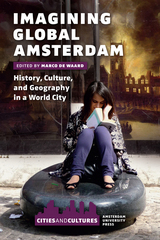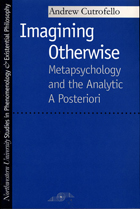An Illustrated Guide to Arizona Weeds
Kittie F. Parker
University of Arizona Press, 1972 Everything needed to recognize, effectively combat--and defeat--weeds. Comprehensive manual covers identification, new species and problems, land-use factors, and control methods. Illustrations by Lucretia B Hamilton.
An Illustrated Guide to Arizona Weeds
Kittie F. Parker
University of Arizona Press Everything needed to recognize, effectively combat--and defeat--weeds. Comprehensive manual covers identification, new species and problems, land-use factors, and control methods. Illustrations by Lucretia B Hamilton.
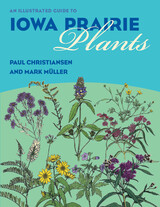 An Illustrated Guide to Iowa Prairie Plants
Paul Christiansen
University of Iowa Press, 1999 Iowa is the only state completely within the tallgrass prairie formation. Thanks to rich soil, adequate rainfall, and warm summer temperatures, hundreds of species combine to produce a diverse and colorful and ever-changing landscape. Using text and maps by Paul Christiansen and newly created drawings by Mark Müller, this first comprehensive guide to the prairie plants native to Iowa provides all the information necessary for identifying and distinguishing even the most similar species. Species are described from the ground up: stem, leaf, bud, flower, fruit, and habitat. The time of flowering and fruiting is given for the central part of Iowa. Where several species are closely related, a common member of the group is fully described, and the other species are compared with the first. Each species is paired with a distribution map. The superbly detailed illustrations, all of which were drawn specifically for this handbook, capture the general shape of each plant as well as its characteristic features. A guide to family identification, information about extant and restored prairies in Iowa, and a glossary are also included. Farmers who settled Iowa in the 1800s viewed the great green sea of grasses and wildflowers as a challenge to be replaced with cropfields and pastures. Today we realize that the prairie is an addictive, restorative, aesthetically satisfying place for study and recreation. An Illustrated Guide to Iowa Prairie Plants is designed to enable those who want to go beyond the most common plants to identify all native species and to learn more about their distribution, structure, and natural history.
An Illustrated Guide to the Mountain Stream Insects of Colorado, Second Edition
J. V. Ward
University Press of Colorado, 2002 Now available in a revised and updated edition, An Illustrated Guide to the Mountain Stream Insects of Colorado is a comprehensive resource on the biology, ecology, and systematics of aquatic insects found in Rocky Mountain streams. This richly illustrated volume includes descriptions of mountain stream ecosystems and habitats, simplified identification keys, and an extensive bibliography. This second edition is ideal for the naturalist, trout stream anglers interested in entomology, specialists in stream ecology, and students of aquatic entomology and freshwater biology.
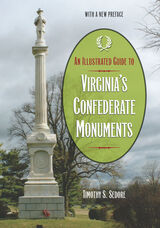 An Illustrated Guide to Virginia's Confederate Monuments
Timothy S. Sedore
Southern Illinois University Press, 2011
From well-known battlefields, such as Manassas, Fredericksburg, and Appomattox, to lesser-known sites, such as Sinking Spring Cemetery and Rude’s Hill, Sedore leads readers on a vivid journey through Virginia’s Confederate history. Tablets, monoliths, courthouses, cemeteries, town squares, battlefields, and more are cataloged in detail and accompanied by photographs and meticulous commentary. Each entry contains descriptions, fascinating historical information, and location, providing a complete portrait of each site.
Much more than a visual tapestry or a tourist’s handbook, An Illustrated Guide to Virginia’s Confederate Monuments draws on scholarly and field research to reveal these sites as public efforts to reconcile mourning with Southern postwar ideologies. Sedore analyzes in depth the nature of these attempts to publicly explain Virginia’s sense of grief after the war, delving deep into the psychology of a traumatized area. From commemorations of famous generals to memories of unknown soldiers, the dead speak from the pages of this sweeping companion to history.
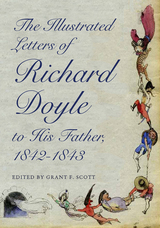 The Illustrated Letters of Richard Doyle to His Father, 1842–1843
Richard Doyle
Ohio University Press, 2015 Before he joined the staff of Punch and designed its iconic front cover, illustrator Richard “Dicky” Doyle was a young man whose father (political caricaturist John Doyle) charged him with sending a weekly letter, even though they lived under the same roof. This volume collects the fifty-three illustrated missives in their entirety for the first time and provides an uncommon peek into the intimate but expansive observations of a precocious social commentator and artist.
In a series of vivid manuscript canvases, Doyle observes Victorian customs and society. He visits operas, plays, and parades. He watches the queen visiting the House of Commons and witnesses the state funeral of the Duke of Sussex. He is caught up in the Chartist riots of August 1842 and is robbed during one of the melees. And he provides countless illustrations of ordinary people strolling in the streets and swarming the parks and picture galleries of the metropolis. The sketches offer a fresh perspective on major social and cultural events of London during the early 1840s by a keen observer not yet twenty years old.
Doyle’s epistles anticipate the modern comic strip and the graphic novel, especially in their experimentation with sequential narrative and their ingenious use of space. The letters are accompanied by a full biographical and critical introduction with new material about Doyle’s life.
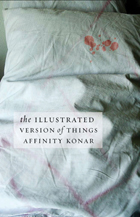 The Illustrated Version of Things
Affinity Konar
University of Alabama Press, 2009 The Illustrated Version of Things is the tale of a young woman, raised in foster homes, juvenile halls, and a mental hospital, on a quest to reunite her disparate family and track down her missing mother. There are her grandparents, Holocaust survivors who reckon with history by staying in bed with their cowboy boots on; her father, a nurse who makes vitamins as a hobby; and her half-brother, an overachiever who doesn’t know whether his name is Moses or Miguel, but is certain that his sister isn’t capable of leading a steady life. More than these, she longs for her mother, and she embarks on a search that leads her into the company of pedophiles, vagrant gamblers, fortune tellers, and musical ghosts. Enchantment and conjured memories become her only hope for finding her mother, until she undertakes a last-chance gambit—voluntary incarceration in the jail that might hold her mother—that will either set her free or follow her for life. Konar’s characters, incredible, tragic, and sympathetic, keep us in a state of deranged rapture, making The Illustrated Version of Things an original and irresistible fiction debut.
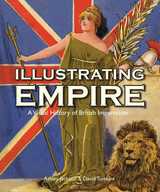 Illustrating Empire: A Visual History of British Imperialism
Edited by Ashley Jackson and David Tomkins
Bodleian Library Publishing, 2011 Through more than 150 striking and original images from the John Johnson Collection of Printed Ephemera at the Bodleian Library, Illustrating Empire tells the history of the British Empire from the age of discovery through World War II. This wealth of visual material was used to promote, record, and celebrate the development of the Empire, which by 1922 included more than thirteen million square miles—or almost a quarter of the Earth. The captions that accompany the illustrations reveal the narrative of the Empire and unlock the history and meaning behind the images.
Following a general introduction that provides an overarching discussion of the many facets of the Empire’s long history, the book is structured around eight major themes: emigration and settlement; imperial authority; exploration and knowledge; trade and commerce; travel and communications; popular culture; exhibitions and jubilees; and politics. Along the way, Illustrating Empire examines the significance of media in conveying and creating ideas about empire and the non-European world. It also provides a clear summary of debates regarding the significance of empire in British culture.
This informative and accessible visual history represents a significant contribution to the literature on culture and empire and will be an engaging and useful source of historical information for general readers and scholars alike.
 Illustrating the Victorian Supernatural
Simon Cooke
Ohio University Press A detailed study of Victorian supernaturalism in book and magazine illustrations and cartoons Illustrating the Victorian Supernatural explores written and visual texts through which the original Victorian readership encountered and navigated their experience of supernaturalism. Looking across the nineteenth century, Simon Cooke investigates illustrative responses to well-known texts by writers such as Charles Dickens and Henry James while also examining responses to less familiar ghost stories by female authors such as M. E. Braddon and Amelia Edwards. The mix of familiar and unfamiliar carries forward into the selection of artists, both those in the mainstream—John Leech, George Cruikshank, Dante Gabriel Rossetti, John Everett Millais—and others whose names are lost to modern readers and whose work deserves to be better known. The study addresses two main questions: how illustration responded to key literary texts and how graphic designs related to contemporary contexts of race, gender, and class and to the workings of the supernatural itself. The first chapter focuses on satirical writings about ghosts and ghostliness and the various ways illustrators depicted that mockery. Chapter 2 traces artistic responses to Dickens’s writing of the supernatural as a mode of psychological investigation. Chapter 3 looks at class and gender and the problematic practice of male artists illustrating female-authored ghost stories. The fourth chapter examines satirical cartoons’ deployment of supernatural imagery to anatomize issues of imperialism and race. Finally, chapter 5 examines how neo-Victorian artists have revisited the classic texts and taken up the themes established by their forebears.
Illustration
J. Hillis Miller
Harvard University Press, 1992
 Illustrations on the Moral Sense
Francis Hutcheson
Harvard University Press, 1971 The writings of Francis Hutcheson played a central role in the development of British moral philosophy in the eighteenth century. His Illustrations on the Moral Sense is significant not only historically but also for its exploration of problems of concern in contemporary ethics. Yet except for brief selections it has not appeared in print since the eighteenth century.
Independent moral philosophy began in England with Hobbes and the reactions to his views, in which two divergent strains were implicit: one a rationalistic appeal to eternal and immutable essences and the other an empirical appeal to human affections and desires. Hutcheson countered Hobbes' theory, which was based on self interest, with a theory based on the moral sense and made explicit the opposition between the school of reason and the school of sentiment. His treatment of these and other issues set British moral philosophy on a line of development that has continued to the present.
This edition of Illustrations on the Moral Sense again makes available Hutcheson's contributions to normative ethics and metaethics, thus making possible a more accurate evaluation of his significance in the history of ethics. His epistemology of morals and his theory of justification are critically examined in a substantial introduction by the editor, Bernard Peach. In addition, Hutcheson's correspondence with Gilbert Burnet, the Younger, which is central to an understanding of the controversies in British moral philosophy in the eighteenth century, is made accessible here for the first time since 1735 in an extensive appendix.
 Illustrative Learning Experiences: University High School in Action
Emma Birkmaier
University of Minnesota Press, 1952
Illustrative Learning Experiences was first published in 1952. Minnesota Archive Editions uses digital technology to make long-unavailable books once again accessible, and are published unaltered from the original University of Minnesota Press editions.This volume is number 2 in the Modern School Practices series; established in 1950 by the College of Education at the University of Minnesota, and the Bureau of Educational Research. The series is designed as a replacement to two earlier series: the Series on Individualization of Instruction and the Modern School Curriculum series.The University High School was established at the University of Minnesota in 1908 as a laboratory center for the College of Education. This volume presents the activities of the High School as an environment of observation, study, and experimentation. Topics discussed include units in social studies, chemistry, business, mathematics, foreign languages, and language arts.
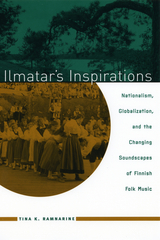 Ilmatar's Inspirations: Nationalism, Globalization, and the Changing Soundscapes of Finnish Folk Music
Tina K. Ramnarine
University of Chicago Press, 2003 Ilmatar gave birth to the bard who sang the Finnish landscape into being in the
Kalevala (the Finnish national epic). In Ilmatar's Inspirations, Tina K. Ramnarine explores creative processes and the critical role that music has played in Finnish nationalism by focusing on Finnish "new folk music" in the shifting spaces between the national imagination and the global marketplace.
Through extensive interviews and observations of performances, Ramnarine reveals how new folk musicians think and talk about past and present folk music practices, the role of folk music in the representation of national identity, and the interactions of Finnish folk musicians with performers from around the globe. She focuses especially on two internationally successful groups—JPP, a group that plays fiddle dance music, and Värttinä, an ensemble that highlights women's vocal traditions. Analyzing the multilayered processes—musical, institutional, political, and commercial—that have shaped and are shaped by new folk music in Finland, Ramnarine gives us an entirely new understanding of the connections between music, place, and identity.
iLobby.eu: Survival Guide to EU Lobbying, Including the Use of Social Media
Caroline de Cock
Eburon Academic Publishers, 2010
With iLobby.eu, Caroline De Cock draws on extensive firsthand experience to present a thorough guide to lobbying the European Union using both traditional methods and social media tools. This practical handbook includes an introduction to lobbying, with tips and anecdotes, recommendations for the use of social media, comprehensive indices, and detailed examples of best and worst practices.
 Ilse Koch on Trial: Making the “Bitch of Buchenwald”
Tomaz Jardim
Harvard University Press, 2023 An authoritative reassessment of one of the Third Reich’s most notorious war criminals, whose alleged sexual barbarism made her a convenient scapegoat and obscured the true nature of Nazi terror.
On September 1, 1967, one of the Third Reich’s most infamous figures hanged herself in her cell after nearly twenty-four years in prison. Known as the “Bitch of Buchenwald,” Ilse Koch was singularly notorious, having been accused of owning lampshades fabricated from skins of murdered camp inmates and engaging in “bestial” sexual behavior. These allegations fueled a public fascination that turned Koch into a household name and the foremost symbol of Nazi savagery. Her subsequent prosecution resulted in a scandal that prompted US Senate hearings and even the intervention of President Truman.
Yet the most sensational atrocities attributed to Koch were apocryphal or unproven. In this authoritative reappraisal, Tomaz Jardim shows that, while Koch was guilty of heinous crimes, she also became a scapegoat for postwar Germans eager to distance themselves from the Nazi past. The popular condemnation of Koch—and the particularly perverse crimes attributed to her by prosecutors, the media, and the public at large—diverted attention from the far more consequential but less sensational complicity of millions of ordinary Germans in the Third Reich’s crimes.
Ilse Koch on Trial reveals how gendered perceptions of violence and culpability drove Koch’s zealous prosecution at a time when male Nazi perpetrators responsible for greater crimes often escaped punishment or received lighter sentences. Both in the international press and during her three criminal trials, Koch was condemned for her violation of accepted gender norms and “good womanly behavior.” Koch’s “sexual barbarism,” though treated as an emblem of the Third Reich’s depravity, ultimately obscured the bureaucratized terror of the Nazi state and hampered understanding of the Holocaust.
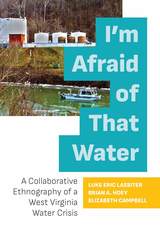 I'm Afraid of That Water: A Collaborative Ethnography of a West Virginia Water Crisis
Luke Eric Lassiter
West Virginia University Press, 2020 Weatherford Award Winner, Nonfiction
On January 9, 2014, residents across Charleston, West Virginia, awoke to an unusual licorice smell in the air and a similar taste in the public drinking water. That evening residents were informed the tap water in tens of thousands of homes, hundreds of businesses, and dozens of schools and hospitals—the water made available to as many as 300,000 citizens in a nine-county region—had been contaminated with a chemical used for cleaning crushed coal.
This book tells a particular set of stories about that chemical spill and its aftermath, an unfolding water crisis that would lead to months, even years, of fear and distrust. It is both oral history and collaborative ethnography, jointly conceptualized, researched, and written by people—more than fifty in all—across various positions in academia and local communities. I’m Afraid of That Water foregrounds the ongoing concerns of West Virginians (and people in comparable situations in places like Flint, Michigan) confronted by the problem of contamination, where thresholds for official safety may be crossed, but a genuine return to normality is elusive.
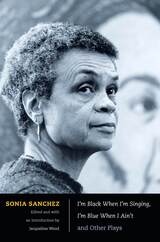 I'm Black When I'm Singing, I'm Blue When I Ain't and Other Plays
Sonia Sanchez
Duke University Press, 2010 Sonia Sanchez is a prolific, award-winning poet and one of the most prominent writers in the Black Arts movement. This collection brings her plays together in one volume for the first time. Like her poetry, Sanchez’s plays voice her critique of the racism and sexism that she encountered as a young female writer in the black militant community in the late 1960s and early 1970s, her ongoing concern with the well-being of the black community, and her commitment to social justice. In addition to The Bronx Is Next (1968), Sister Son/ji (1969), Dirty Hearts (1971), Malcolm/Man Don’t Live Here No Mo (1972), and Uh, Uh; But How Do It Free Us? (1974), this collection includes the never-before-published dramas I’m Black When I’m Singing, I’m Blue When I Ain’t (1982) and 2 X 2 (2009), as well as three essays in which Sanchez reflects on her art and activism. Jacqueline Wood’s introduction illuminates Sanchez’s stagecraft in relation to her poetry and advocacy for social change, and the feminist dramatic voice in black revolutionary art.
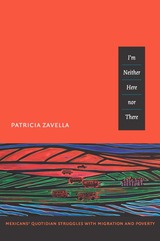 I'm Neither Here nor There: Mexicans' Quotidian Struggles with Migration and Poverty
Patricia Zavella
Duke University Press, 2011 I’m Neither Here nor There explores how immigration influences the construction of family, identity, and community among Mexican Americans and migrants from Mexico. Based on long-term ethnographic research, Patricia Zavella describes how poor and working-class Mexican Americans and migrants to California’s central coast struggle for agency amid the region’s deteriorating economic conditions and the rise of racial nativism in the United States. Zavella also examines tensions within the Mexican diaspora based on differences in legal status, generation, gender, sexuality, and language. She proposes “peripheral vision” to describe the sense of displacement and instability felt by Mexican Americans and Mexicans who migrate to the United States as well as by their family members in Mexico. Drawing on close interactions with Mexicans on both sides of the border, Zavella examines migrant journeys to and within the United States, gendered racialization, and exploitation at workplaces, and the challenges that migrants face in forming and maintaining families. As she demonstrates, the desires of migrants to express their identities publicly and to establish a sense of cultural memory are realized partly through Latin American and Chicano protest music, and Mexican and indigenous folks songs played by musicians and cultural activists.
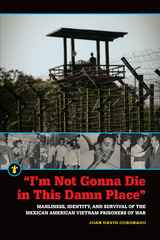 "I'm Not Gonna Die in This Damn Place": Manliness, Identity, and Survival of the Mexican American Vietnam Prisoners of War
Juan David Coronado
Michigan State University Press, 2018 By the time of the Vietnam War era, the “Mexican American Generation” had made tremendous progress both socially and politically. However, the number of Mexican Americans in comparison to the number of white prisoners of war (POWs) illustrated the significant discrimination and inequality the Chicano population faced in both military and civilian landscapes. Chicanos were disproportionately “grunts” (infantry), who were more likely to be killed when captured, while pilots and officers were more likely to be both white and held as POWs for negotiating purposes. A fascinating look at the Vietnam War era from a Chicano perspective, “I’m Not Gonna Die in this Damn Place”: Manliness, Identity, and Survival of the Mexican American Vietnam Prisoners of War gives voice to the Mexican American POWs. The stories of these men and their families provide insights to the Chicano Vietnam War experience, while also adding tremendously to the American POW story. This book is an important read for academics and military enthusiasts alike.
I’m Not Stiller
Max Frisch
Seagull Books, 1958 A renowned novel of self-deceit and self-acceptance.
Arrested and imprisoned in a small Swiss town, a prisoner begins this book with an exclamation: “I'm not Stiller!” He claims that his name is Jim White, and that he has been jailed under false charges and under the wrong identity. To prove he is who he claims to be, he confesses to three unsolved murders and recalls in great detail an adventuresome life in America and Mexico among cowboys and peasants, in back alleys and docks. He is consumed by “the morbid impulse to convince,” but no one believes him.
This is a harrowing account—part Kafka, part Camus—of the power of self-deception and the freedom that ultimately lies in self-acceptance. Simultaneously haunting and humorous, I'm Not Stiller has come to be recognized as one of the major post-war works of fiction and a masterpiece of German literature.
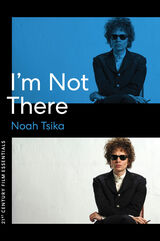 I'm Not There
Noah Tsika
University of Texas Press, 2023 An examination of director Todd Haynes and his Bob Dylan biopic.
As the first and only Bob Dylan “biopic,” I’m Not There caused a stir when released in 2007. Offering a surreal retelling of moments from Dylan’s life and career, the film is perhaps best known for its distinctive approach to casting, including Cate Blanchett and Marcus Carl Franklin, a Black child actor, as versions of Dylan though none of the characters bear his name. Greenlit by Bob Dylan himself, the film uses Dylan’s music as a score, a triumph for famed queer filmmaker Todd Haynes after encountering issues with copyright in previous projects. Noah Tsika eloquently characterizes all the ways that Dylan and Haynes harmonize in their methods and sensibilities, interpreting the rule-breaking film as a biography that refuses chronology, disdains factual accuracy, flirts with libel, and cannibalizes Western cinema. Fitting the film’s inspiration, creation, and reception alongside its continuing afterlife, Tsika examines Dylan’s music in the film through the context of intellectual property, raising questions about who owns artistic material and artistic identities and how such material can be reused and repurposed. Tsika’s adventurous analysis touches on gender, race, queerness, celebrity, popular culture, and the law, while offering much to Haynes and Dylan fans alike.
I'm Speaking: Selected Poems
Rafael Guillen
Northwestern University Press, 2001 Rafael Guillén's poems paint vivid portraits of the land and people of his native Andalusia. In sharp-edged words tinged with a certain tender grief, Guillén presents the harshness and beauty of his country-the calm seashore and the violent revolutions, the wheat fields and the famine, the children and the laborers toiling under the oppressive Spanish sun. Behind the imagery and language a quiet force builds as Guillén reflects on coming of age during the Spanish Civil War and on love, life, death, and faith in modern-day Granada, Paris, and the United States.
 Imacoqwa’s Arrow: On the Biunity of the Sun and Moon in a Papuan Lifeworld
Jadran Mimica
HAU, 2025 A pathbreaking study of Yagwoia cosmological concepts.
In Imacoqwa’s Arrow, Jadran Mimica draws on decades of field research to bring us a rich ethnographic account of myth and meaning in the lifeworlds of the Yagwoia of Papua New Guinea. He focuses especially on the relations of the sun and the moon in Yagwoia understandings of the universe and their own place within it. This is classic terrain in Melanesian ethnography, but Mimica does much more than add to the archive of anthropological accounts of the significance of the sun and the moon for peoples of this part of the world. With extraordinary rigor and reflexivity, he grounds his understanding of Yagwoia concepts in psychoanalytic and phenomenological methods that afford a radically new and revealing translation of these seminal themes in Melanesian mythology and its poetics. This is a major contribution to the hermeneutics of ethnographic translation and theorization.
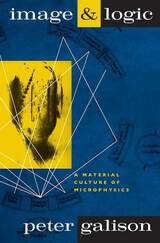 Image and Logic: A Material Culture of Microphysics
Peter Galison
University of Chicago Press, 1997 "I want to get at the blown glass of the early cloud chambers and the oozing noodles of wet nuclear emulsion; to the resounding crack of a high-voltage spark arcing across a high-tension chamber and leaving the lab stinking of ozone; to the silent, darkened room, with row after row of scanners sliding trackballs across projected bubble-chamber images. Pictures and pulses—I want to know where they came from, how pictures and counts got to be the bottom-line data of physics." (from the preface)
Image and Logic is the most detailed engagement to date with the impact of modern technology on what it means to "do" physics and to be a physicist. At the beginning of this century, physics was usually done by a lone researcher who put together experimental apparatus on a benchtop. Now experiments frequently are larger than a city block, and experimental physicists live very different lives: programming computers, working with industry, coordinating vast teams of scientists and engineers, and playing politics.
Peter L. Galison probes the material culture of experimental microphysics to reveal how the ever-increasing scale and complexity of apparatus have distanced physicists from the very science that drew them into experimenting, and have fragmented microphysics into different technical traditions much as apparatus have fragmented atoms to get at the fundamental building blocks of matter. At the same time, the necessity for teamwork in operating multimillion-dollar machines has created dynamic "trading zones," where instrument makers, theorists, and experimentalists meet, share knowledge, and coordinate the extraordinarily diverse pieces of the culture of modern microphysics: work, machines, evidence, and argument.
 Image and Mind
Stephen M. Kosslyn
Harvard University Press, 1980 Are images an important means of recalling information from memory and solving problems? Or are images just display lights on the mind’s computer? In Image and Mind, Stephen Kosslyn makes an impressive case for the view that images are critically involved in the life of the mind. In a series of ingenious experiments, he provides hard evidence that people can construct elaborate mental images, search them for specific information, and perform such other internal operations as mental rotation. Kosslyn demonstrates that these results are best explained by a two-tiered model in which images are stored in abstract form in long-term memory and then assembled for internal display in much the way that images on a TV screen can be created from files in a computer memory.
Kosslyn shows how this model can be used to solve many of the persistent questions which have traditionally plagued theories of imagery that attempted to install imagery as the exclusive medium of mental representation.
Unlike any other work on imagery, Image and Mind provides an integrated account of most of the modern empirical results from imagery research within the framework of a coherent theory. The book also introduces a host of new experimental techniques and major hypotheses to guide future research. The result is a landmark book and a major event in the study of the mind.
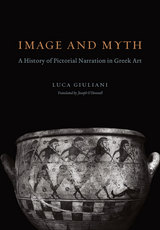 Image and Myth: A History of Pictorial Narration in Greek Art
Luca Giuliani
University of Chicago Press, 2013 On museum visits, we pass by beautiful, well-preserved vases from ancient Greece—but how often do we understand what the images on them depict? In Image and Myth, Luca Giuliani tells the stories behind the pictures, exploring how artists of antiquity had to determine which motifs or historical and mythic events to use to tell an underlying story while also keeping in mind the tastes and expectations of paying clients. Covering the range of Greek style and its growth between the early Archaic and Hellenistic periods, Giuliani describes the intellectual, social, and artistic contexts in which the images were created. He reveals that developments in Greek vase painting were driven as much by the times as they were by tradition—the better-known the story, the less leeway the artists had in interpreting it. As literary culture transformed from an oral tradition, in which stories were always in flux, to the stability of written texts, the images produced by artists eventually became nothing more than illustrations of canonical works. At once a work of cultural and art history, Image and Myth builds a new way of understanding the visual culture of ancient Greece.
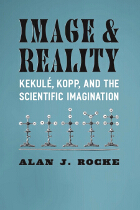 Image and Reality: Kekulé, Kopp, and the Scientific Imagination
Alan J. Rocke
University of Chicago Press, 2010 Nineteenth-century chemists were faced with a particular problem: how to depict the atoms and molecules that are beyond the direct reach of our bodily senses. In visualizing this microworld, these scientists were the first to move beyond high-level philosophical speculations regarding the unseen. In Image and Reality, Alan Rocke focuses on the community of organic chemists in Germany to provide the basis for a fuller understanding of the nature of scientific creativity. Arguing that visual mental images regularly assisted many of these scientists in thinking through old problems and new possibilities, Rocke uses a variety of sources, including private correspondence, diagrams and illustrations, scientific papers, and public statements, to investigate their ability to not only imagine the invisibly tiny atoms and molecules upon which they operated daily, but to build detailed and empirically based pictures of how all of the atoms in complicated molecules were interconnected. These portrayals of “chemical structures,” both as mental images and as paper tools, gradually became an accepted part of science during these years and are now regarded as one of the central defining features of chemistry. In telling this fascinating story in a manner accessible to the lay reader, Rocke also suggests that imagistic thinking is often at the heart of creative thinking in all fields.
Image and Reality is the first book in the Synthesis series, a series in the history of chemistry, broadly construed, edited by Angela N. H. Creager, John E. Lesch, Stuart W. Leslie, Lawrence M. Principe, Alan Rocke, E.C. Spary, and Audra J. Wolfe, in partnership with the Chemical Heritage Foundation.
Image and Reflection: A Pictorial History of the University of Arkansas
Ethel Simpson
University of Arkansas Press, 1990 A yearbook of yearbooks celebrating the connection between the old and new, the 522 photographs in Image and Reflection stir the memories of every past and present member of the University community, from its beginning at William McIlroy's farm to today's bustling campus.
Image and Structure in Chamber Music
Donald N. Ferguson
University of Minnesota Press, 1964 Image and Structure in Chamber Music was first published in 1964. Minnesota Archive Editions uses digital technology to make long-unavailable books once again accessible, and are published unaltered from the original University of Minnesota Press editions. The major portion of this book is devoted to descriptions of the most important chamber music works, taken up in separate chapters by composer in broadly chronological order—Haydn, Mozart, Beethoven, Schubert, Mendelssohn, Schumann, and Brahms. There are also chapters on the intimacy of chamber music, on the antecedents of the above-named composers, on nationalistic chamber music, on twentieth-century chamber music, and on chamber music in the United States.
 The Image and the Fire: The Subversive Anthology in the Twentieth Century
Whit Frazier Peterson
University of Massachusetts Press, 2026 Racial identity and literary form in the modernist anthology
The Image and the Fire examines the coterie anthology—a small, outsider literary collection—as a key, yet understudied, instrument of literary intervention within American modernism. Whit Frazier Peterson argues that these anthologies, produced outside of institutional or canonical frameworks, served as deliberate challenges to dominant literary paradigms. Distinct from academic anthologies that helped codify the American literary canon, coterie anthologies were used by both white and Black avant-garde movements to disrupt prevailing cultural narratives and assert alternative literary visions.
Through close analysis of three seminal case studies—Des Imagistes, edited by Ezra Pound; Fire!!, a short-lived but groundbreaking magazine from the Harlem Renaissance, co-edited by Wallace Thurman; and Black Fire, compiled by Amiri Baraka and Larry Neal during the Black Arts Movement—Peterson traces a genealogy of the coterie anthology as a politically charged genre. He reveals how Black American writers and editors, particularly during the Harlem Renaissance and the Black Arts Movement, reappropriated and reconfigured this type of anthology format from white modernists.
Ultimately, The Image and the Fire positions the coterie anthology as a site of aesthetic and ideological contestation, one through which marginalized literary communities engaged in acts of cultural self-definition, canon revision, and formal innovation. By foregrounding the coterie anthology’s role in shaping a hybrid American modernism, Peterson contributes to ongoing conversations in literary studies around race, authorship, and the politics of literary form.
 The Image and the Fire: The Subversive Anthology in the Twentieth Century
Whit Frazier Peterson
University of Massachusetts Press, 2026 Racial identity and literary form in the modernist anthology
The Image and the Fire examines the coterie anthology—a small, outsider literary collection—as a key, yet understudied, instrument of literary intervention within American modernism. Whit Frazier Peterson argues that these anthologies, produced outside of institutional or canonical frameworks, served as deliberate challenges to dominant literary paradigms. Distinct from academic anthologies that helped codify the American literary canon, coterie anthologies were used by both white and Black avant-garde movements to disrupt prevailing cultural narratives and assert alternative literary visions.
Through close analysis of three seminal case studies—Des Imagistes, edited by Ezra Pound; Fire!!, a short-lived but groundbreaking magazine from the Harlem Renaissance, co-edited by Wallace Thurman; and Black Fire, compiled by Amiri Baraka and Larry Neal during the Black Arts Movement—Peterson traces a genealogy of the coterie anthology as a politically charged genre. He reveals how Black American writers and editors, particularly during the Harlem Renaissance and the Black Arts Movement, reappropriated and reconfigured this type of anthology format from white modernists.
Ultimately, The Image and the Fire positions the coterie anthology as a site of aesthetic and ideological contestation, one through which marginalized literary communities engaged in acts of cultural self-definition, canon revision, and formal innovation. By foregrounding the coterie anthology’s role in shaping a hybrid American modernism, Peterson contributes to ongoing conversations in literary studies around race, authorship, and the politics of literary form.
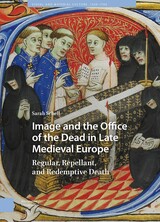 Image and the Office of the Dead in Late Medieval Europe: Regular, Repellant, and Redemptive Death
Sarah Schell
Amsterdam University Press, 2023 Image and the Office of the Dead in Late Medieval Europe explores the Office of the Dead as a site of interaction between text, image, and experience in the culture of commemoration that thrived in the fourteenth and fifteenth centuries. The Office of the Dead was a familiar liturgical ritual, and its perceived importance and utility are evident in its regular inclusion in devotional compilations, which crossed the boundaries between lay and religious readers. The Office was present in all medieval deaths: as a focus for private contemplation, a site of public performance, a reassuring ritual, and a voice for the bereaved. Examining the images at the Office of the Dead and related written, visual, and material evidence, this book explores the relationship of these images to the text in which they are embedded and to the broader experiences of and aspirations for death.
Image and Theme: Studies in Modern French Fiction: Bernanos, Malraux, Sarraute, Gide, Martin Du Gard
W. M. Frohock
Harvard University Press, 1969 These five monographs utilize recent advances in image-study and thematics to explore previously uninvestigated aspects of the works of five important French novelists. Viewed together, the individual monographs present variations on a systematic approach to the close study of French fiction. W.M. Frohock's introduction provides an explication of the relationships among the monographs, describes the basic research method employed, and enlarges upon underlying theoretical assumptions.
 Image Critique and the Fall of the Berlin Wall
Sunil Manghani
Intellect Books, 2008 Although we are now accustomed to watching history unfold live on the air, the fall of the Berlin Wall was one of the first instances when history was produced on television. Inspired by the Wall and its powerful resonances, Sunil Manghani’s breakthrough study presents the new critical concept of “image critique,” a method of critiquing images while simultaneously using them as a means to engage with contemporary culture. Manghani examines current debates surrounding visual culture, ranging from such topics as Francis Fukuyama’s end of history thesis to metapictures and East German film. The resulting volume is an exhilarating interweaving of history, politics, and visual culture. “Sunil Manghani’s Image Critique & the Fall of the Berlin Wall is the best sort of scholarly book—an intellectually grounded and theoretically adventurous critical performance. Through his concept of image critique, Manghani makes a virtue out of the many attributes of images that bedevil visual cultural studies, rightly insisting that rather than domesticating images for the tyranny of the word, scholars must do visual studies from the ground of images, in the process reconceptualizing theory and criticism. Manghani adeptly anchors his insights in close engagements with images, most notably images from the event of the fall of the Berlin Wall. If heeded, Manghani’s book will change the trajectory of visual cultural studies by making critique a performance with force in the world.”—Kevin DeLuca, University of Georgia
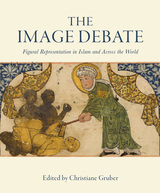 The Image Debate: Figural Representation in Islam and Across the World
Edited by Christiane Gruber
Gingko, 2019 The images released by the Islamic State of militants smashing statues at ancient sites were a horrifying aspect of their advance across Northern Iraq and Syria during 2015-16. Their leaders justified this iconoclasm by arguing that such actions were divinely decreed in Islam, a notion that has remained fixed in the public consciousness.
The Image Debate is a collection of thirteen essays which examine the controversy surrounding the use of images in Islamic and other religious cultures and seek to redress some of the misunderstandings that have arisen. Written by leading academics from the United States, Australia, Turkey, Israel and the United Kingdom, the book has a foreword by Stefano Carboni, Director of the Art Gallery of Western Australia, followed by an introduction by the editor Christiane Gruber, who sets the subject in context with a detailed examination of the debates over idols and the production of figural images in Islamic traditions.
Twelve further articles are divided into three sections: the first deals with pre-modern Islam: Mika Natif looks at tensions between the Hadith prohibition on images and the praxis of image-making under the Umayyad dynasty and argues that the Umayyad rulers used imagery to establish their political and religious authority; Finbarr Barry Flood examines the practice of epigraphic erasure, i.e., the removal of names of rulers and patrons from historical inscriptions from the medieval Islamic world; and Oya Pancaroğlu focuses on the figural conventions of an illustrated manuscript of Varqa and Gulshah, a medieval Persian romance composed in the masnavi (rhyming couplet) form by the 11th-century poet ‘Ayyuqi.
The second section addresses the situation outside Islam: Alicia Walker surveys attitudes toward the production and veneration of religious images in Byzantium from the earliest years of the Christian Roman Empire (early 4th century) to the aftermath of the Iconoclast controversy (late 9th century); Steven Fine explores the history of Jewish engagement with ‘art’ from Roman antiquity through the high middle ages through a detailed exploration of the 3rd-century Dura Europos synagogue and its wall paintings; Michael Shenkar examines evidence for the employment of figural images in the cultic practices of some of the major ancient Iranian cultural and political entities, offering a broad perspective on perceptions of images in ancient Iranian worship; and Robert DeCaroli delves into the question of why no image of the Buddha was made during the first five hundred years of Buddhism.
The third section brings the reader back to Islamic lands with five articles examining aspects of the issue in the modern and contemporary periods: Yousuf Saaed investigates South Asian mass-produced images, especially posters that include illustrations of local Sufi shrines, portraits of saints and Shi‘i iconography; James Bennett explores the visual depiction of Javanese shadow puppets (wayang kulit), including the sage Begawan Abiyasa, whose narratives convey key elements of Sufi mystical philosophy; Allen and Mary Roberts consider images of Cheikh Amadu Bamba, the founding Sufi saint of the Senegalese Mouride order; Rose Issa addresses how the term ‘Islamic’ relates to contemporary art, how artists manage to create work in countries in constant turmoil and to what extent such works reflect their conceptual, aesthetic, and socio-political concerns; and finally Shiva Balaghi traces the use of the figure, along its symbolic shadows and silhouettes, in works by notable Iranian artists living in Iran and in diaspora.
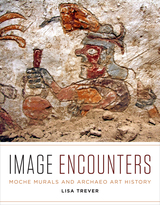 Image Encounters: Moche Murals and Archaeo Art History
Lisa Trever
University of Texas Press, 2022 2022 Mr. and Mrs. Raymond J. Horowitz Book Prize, Bard Graduate Center
A landmark study of ancient Peruvian Moche mural art.
Moche murals of northern Peru represent one of the great, yet still largely unknown, artistic traditions of the ancient Americas. Created in an era without written scripts, these murals are key to understandings of Moche history, society, and culture. In this first comprehensive study on the subject, Lisa Trever develops an interdisciplinary methodology of “archaeo art history” to examine how ancient histories of art can be written without texts, boldly inverting the typical relationship of art to archaeology. Trever argues that early coastal artistic traditions cannot be reduced uncritically to interpretations based in much later Inca histories of the Andean highlands. Instead, the author seeks the origins of Moche mural art, and its emphasis on figuration, in the deep past of the Pacific coast of South America. Image Encounters shows how formal transformations in Moche mural art, before and after the seventh century, were part of broader changes to the work that images were made to perform at Huacas de Moche, El Brujo, Pañamarca, and elsewhere in an increasingly complex social and political world. In doing so, this book reveals alternative evidentiary foundations for histories of art and visual experience.
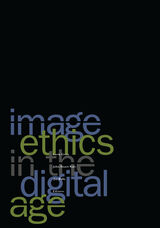 Image Ethics In The Digital Age
Larry Gross
University of Minnesota Press, 2003 Over the past quarter century, dramatic technological advances in the production, manipulation, and dissemination of images have transformed the practices of journalism, entertainment, and advertising as well as the visual environment itself. From digital retouching to wholesale deception, the media world is now beset by an unprecedented range of moral, ethical, legal, and professional challenges. Image Ethics in the Digital Age brings together leading experts in the fields of journalism, media studies, and law to address these challenges and assess their implications for personal and societal values and behavior. Among the issues raised are the threat to journalistic integrity posed by visual editing software; the monopolization of image archives by a handful of corporations and its impact on copyright and fair use laws; the instantaneous electronic distribution of images of dubious provenance around the world; the erosion of privacy and civility under the onslaught of sensationalistic twenty-four-hour television news coverage and entertainment programming; and the increasingly widespread use of surveillance cameras in public spaces. This volume of original essays is vital reading for anyone concerned with the influence of the mass media in the digital age. Contributors: Howard S. Becker; Derek Bousé, Eastern Mediterranean U, Cyprus; Hart Cohen, U of Western Sydney; Jessica M. Fishman; Paul Frosh, Hebrew U of Jerusalem; Faye Ginsburg, New York U; Laura Grindstaff, U of California, Davis; Dianne Hagaman; Sheldon W. Halpern, Ohio State U; Darrell Y. Hamamoto, U of California, Davis; Marguerite Moritz, U of Colorado, Boulder; David D. Perlmutter, Louisiana State U; Dona Schwartz, U of Minnesota; Matthew Soar, Concordia University; Stephen E. Weil, Smithsonian Institution’s Center for Education and Museum Studies.
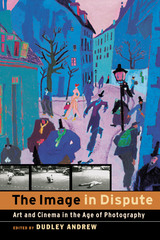 The Image in Dispute: Art and Cinema in the Age of Photography
Edited by Dudley Andrew
University of Texas Press, 1997 Photography, cinema, and video have irrevocably changed the ways in which we view and interpret images. Indeed, the mechanical reproduction of images was a central preoccupation of twentieth-century philosopher Walter Benjamin, who recognized that film would become a vehicle not only for the entertainment of the masses but also for consumerism and even communism and fascism. In this volume, experts in film studies and art history take up the debate, begun by Benjamin, about the power and scope of the image in a secular age. Part I aims to bring Benjamin's concerns to life in essays that evoke specific aspects and moments of the visual culture he would have known. Part II focuses on precise instances of friction within the traditional arts brought on by this century's changes in the value and mission of images. Part III goes straight to the image technologies themselves—photography, cinema, and video—to isolate distinctive features of the visual cultures they help constitute. As we advance into the postmodern era, in which images play an ever more central role in conveying perceptions and information, this anthology provides a crucial context for understanding the apparently irreversible shift from words to images that characterized the modernist period. It will be important reading for everyone in cultural studies, film and media studies, and art history.
Image: Knowledge in Life and Society
Kenneth E. Boulding
University of Michigan Press, 1956 Behavior depends on the image—the sum of what we think we know and what makes us act the way we do. The image lies behind the actions of every individual. It accounts for the growth of every cause. To recognize the image is to begin to understand the scientist, the believer, the crusader, the soldier. To know its shape is the key to psychoanalysis, public opinion polling, and social psychology. Professor Kenneth Boulding, eminent economist and author of Organizational Revolution, illuminates with the image of all modern knowledge: biology, psychology, sociology, political science, economics, and history. And he proposes a new science, "eiconics," to restructure all that is presently known about man.
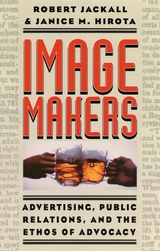 Image Makers: Advertising, Public Relations, and the Ethos of Advocacy
Robert Jackall and Janice M. Hirota
University of Chicago Press, 2000 Talking dogs pitching ethnic food. Heart-tugging appeals for contributions. Recruitment calls for enlistment in the military. Tub-thumpers excoriating American society with over-the-top rhetoric. At every turn, Americans are exhorted to spend money, join organizations, rally to causes, or express outrage. Image Makers is a comprehensive analysis of modern advocacy-from commercials to public service ads to government propaganda-and its roots in advertising and public relations.
Robert Jackall and Janice M. Hirota explore the fashioning of the apparatus of advocacy through the stories of two organizations, the Committee on Public Information, which sold the Great War to the American public, and the Advertising Council, which since the Second World War has been the main coordinator of public service advertising. They then turn to the career of William Bernbach, the adman's adman, who reinvented advertising and grappled creatively with the profound skepticism of a propaganda-weary midcentury public. Jackall and Hirota argue that the tools-in-trade and habits of mind of "image makers" have now migrated into every corner of modern society. Advocacy is now a vocation for many, and American society abounds as well with "technicians in moral outrage," including street-smart impresarios, feminist preachers, and bombastic talk-radio hosts.
The apparatus and ethos of advocacy give rise to endlessly shifting patterns of conflicting representations and claims, and in their midst Image Makers offers a clear and spirited understanding of advocacy in contemporary society and the quandaries it generates.
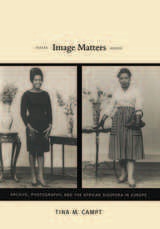 Image Matters: Archive, Photography, and the African Diaspora in Europe
Tina M. Campt
Duke University Press, 2012 In Image Matters, Tina M. Campt traces the emergence of a black European subject by examining how specific black European communities used family photography to create forms of identification and community. At the heart of Campt's study are two photographic archives, one composed primarily of snapshots of black German families taken between 1900 and 1945, and the other assembled from studio portraits of West Indian migrants to Birmingham, England, taken between 1948 and 1960. Campt shows how these photographs conveyed profound aspirations to forms of national and cultural belonging. In the process, she engages a host of contemporary issues, including the recoverability of non-stereotypical life stories of black people, especially in Europe, and their impact on our understanding of difference within diaspora; the relevance and theoretical approachability of domestic, vernacular photography; and the relationship between affect and photography. Campt places special emphasis on the tactile and sonic registers of family photographs, and she uses them to read the complexity of "race" in visual signs and to highlight the inseparability of gender and sexuality from any analysis of race and class. Image Matters is an extraordinary reflection on what vernacular photography enabled black Europeans to say about themselves and their communities.
Image of Australia
Edited by Joseph Jones
University of Texas Press, 1962 This volume, originally published as a special issue of The Texas Quarterly in 1962, contains a collection of Australian literature and essays on Australian culture.
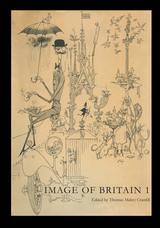 Image of Britain 1
Edited by Thomas Mabry Cranfill
University of Texas Press, 1961 Image of Britain 1, originally published in 1961, was the first of two special issues of The Texas Quarterly devoted to Britain. This volume contains three dozen selections, including essays, fiction, poetry, and illustrations, most of them specially commissioned. The editorial aim has been to achieve scope and variety. Surveyed in the articles are a dozen or more facets of British culture, among them politics, education, Anglo-American relations, religion, law, food, changes in class structure, pediatrics, the intellectual climate, scientific progress, and international relations. Those who labor under the delusion that the British lack humor are advised to read Siriol Hugh-Jones's remarks on the subject, Henry Green's "Firefighting," William Sansom's "Dear Sir," and Willis W. Pratt's article on the great cartoonists Emett and Searle—whose cartoons should then be inspected carefully. Their cartoons are only a part of the book’s handsome illustrations. In addition, the photographer Hans Beacham visited England at the Quarterly's invitation to depict for American readers distinguished figures in British arts and letters. His gallery of forty-one portraits of writers and other notables has historical as well as artistic importance. Beacham has also contributed twenty-one hauntingly beautiful photographs of the studio of the late great sculptor Sir Jacob Epstein. Thirty-three of the contributors to this collection are British. There is much to be said for inviting members of this forthright, brilliantly self-critical race to comment extensively on themselves. Among the authors are the young and already noteworthy—Dom Moraes, Ted Hughes, and Alan Sillitoe, for example—as well as the firmly established and celebrated, such as John Wain, William Sansom, and Henry Green. .
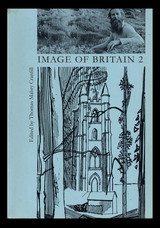 Image of Britain 2
Edited by Thomas Mabry Cranfill
University of Texas Press, 1961 Image of Britain 2, originally published in 1961, was the second of two special numbers of The Texas Quarterly devoted to Britain. This volume comprises some three dozen selections—essays, fiction, poetry, and illustrations, most of them specially commissioned. The editorial aim has been to achieve scope and variety. The articles, essays in criticism on British themes, for the most part survey literature and the fine arts: poetry, theater, intellectual review, then-recent translations into English, the flood of military memoirs, British humor, architecture, painting and sculpture, and music. Other essays treat individual authors, among them Shakespeare, Trollope, Galsworthy, Forster, Wells, Yeats, Pound, Shaw, Muir, Green, Snow, Waugh, Amis, and Pinter. All except a handful of the essayists are British. There is much to be said for inviting the forthright and brilliantly self-critical to comment extensively on their own literature and art. Stephen Spender and John Lehmann, two of Britain’s most distinguished editors, deal with British literary matters, both international and domestic; the novelist David Garnett discusses George Moore, Galsworthy, Forster, and H. G. Wells—the men and their works; and the poet Kathleen Raine appraises the verse of Edwin Muir. Like the essayists, the contributors of fiction and poetry include the emerging and already noteworthy—Ted Hughes, Peter Redgrove, and Andrew Sinclair, for example—as well as the firmly established and celebrated, such as Angus Wilson, Stephen Spender, and Joyce Cary. Cary’s short story “The Ball” appeared here in print for the first time. The photographer Hans Beacham, who visited England at the Quarterly’s invitation, contributed a gallery of portraits of important British painters and sculptors. The photographs complement David Sylvester’s article on contemporary British art. In addition, Edward Bawden’s drawings of the British scene run like a charming frieze throughout this number.
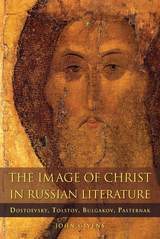 The Image of Christ in Russian Literature: Dostoevsky, Tolstoy, Bulgakov, Pasternak
JOHN GIVENS
Northern Illinois University Press, 2018 Vladimir Nabokov complained about the number of Dostoevsky’s characters “sinning their way to Jesus.” In truth, Christ is an elusive figure not only in Dostoevsky’s novels, but in Russian literature as a whole. The rise of the historical critical method of biblical criticism in the nineteenth century and the growth of secularism it stimulated made an earnest affirmation of Jesus in literature highly problematic. If they affirmed Jesus too directly, writers paradoxically risked diminishing him, either by deploying faith explanations that no longer persuade in an age of skepticism or by reducing Christ to a mere argument in an ideological dispute.
The writers at the heart of this study understood that to reimage Christ for their age, they had to make him known through indirect, even negative ways, lest what they say about him be mistaken for cliché, doctrine, or naïve apologetics. The Christology of Dostoevsky, Leo Tolstoy, Mikhail Bulgakov, and Boris Pasternak is thus apophatic because they deploy negative formulations (saying what God is not) in their writings about Jesus. Professions of atheism in Dostoevsky and Tolstoy’s non-divine Jesus are but separate negative paths toward truer discernment of Christ.
This first study in English of the image of Christ in Russian literature highlights the importance of apophaticism as a theological practice and a literary method in understanding the Russian Christ. It also emphasizes the importance of skepticism in Russian literary attitudes toward Jesus on the part of writers whose private crucibles of doubt produced some of the most provocative and enduring images of Christ in world literature. This important study will appeal to scholars and students of Orthodox Christianity and Russian literature, as well as educated general readers interested in religion and nineteenth-century Russian novels.
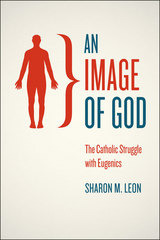 An Image of God: The Catholic Struggle with Eugenics
Sharon M. Leon
University of Chicago Press, 2013 During the first half of the twentieth century, supporters of the eugenics movement offered an image of a racially transformed America by curtailing the reproduction of “unfit” members of society. Through institutionalization, compulsory sterilization, the restriction of immigration and marriages, and other methods, eugenicists promised to improve the population—a policy agenda that was embraced by many leading intellectuals and public figures. But Catholic activists and thinkers across the United States opposed many of these measures, asserting that “every man, even a lunatic, is an image of God, not a mere animal." In An Image of God, Sharon Leon examines the efforts of American Catholics to thwart eugenic policies, illuminating the ways in which Catholic thought transformed the public conversation about individual rights, the role of the state, and the intersections of race, community, and family. Through an examination of the broader questions raised in this debate, Leon casts new light on major issues that remain central in American political life today: the institution of marriage, the role of government, and the separation of church and state. This is essential reading in the history of religion, science, politics, and human rights.
 The Image of the Black in African and Asian Art
David Bindman
Harvard University Press, 2017 The Image of the Black in African and Asian Art asks how the black figure was depicted by artists from the non-Western world. Beginning with ancient Egypt—positioned properly as part of African history—this volume focuses on the figure of the black as rendered by artists from Africa, East Asia, and the Indian subcontinent. The aesthetic traditions illustrated here are as diverse as the political and social histories of these regions. From Igbo Mbari sculptures to modern photography from Mali, from Indian miniatures to Japanese prints, African and Asian artists portrayed the black body in ways distinct from the European tradition, even as they engaged with Western art through the colonial encounter and the forces of globalization.
This volume complements the vision of art patrons Dominique and Jean de Menil who, during the 1960s, founded an image archive to collect the ways that people of African descent have been represented in Western art from the ancient world to modern times. A half‐century later, Harvard University Press and the Hutchins Center for African and African American Research completed the historic publication of The Image of the Black in Western Art—ten books in total—beginning with Egyptian antiquities and concluding with images that span the twentieth century. The Image of the Black in African and Asian Art reinvigorates the de Menil family’s original mission and reorients the study of the black body with a new focus on Africa and Asia.
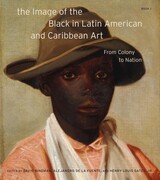 The Image of the Black in Latin American and Caribbean Art
David Bindman
Harvard University Press The Image of the Black in Latin American and Caribbean Art is the first comprehensive survey of the visual representation of people of African descent in Latin America and the Caribbean, some twelve million of whom were forcibly imported into the Americas during the transatlantic slave trade. This first volume spans four centuries, from the first Spanish occupation of Latin America and the Caribbean in the fifteenth century; through the establishment of slave colonies on the mainland and islands by the British, French, and Danish; to the revolutionary emergence of independence, first in Haiti in 1804, and then across Latin America. Essays by leading scholars and superb illustrations bring to light a remarkable range of imagery that provides vivid insights into the complex racial history of the period.
The two volumes complement the vision of Dominique and Jean de Menil, art patrons who, during the 1960s, founded an archive to collect images depicting the myriad ways that people of African descent have been represented in Western art from the ancient world to modern times. The Image of the Black in Latin American and Caribbean Art continues the de Menil family’s original mission and brings to the fore a renewed focus on a rich and understudied area.
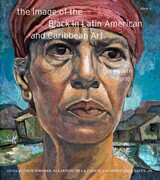 The Image of the Black in Latin American and Caribbean Art
David Bindman
Harvard University Press The Image of the Black in Latin American and Caribbean Art is the first comprehensive survey of the visual representation of people of African descent in Latin America and the Caribbean, some twelve million of whom were forcibly imported into the Americas during the transatlantic slave trade. This second volume explores the period from the final abolition of slavery in Brazil and Cuba in the nineteenth century through the independence of the Caribbean islands to the present day. The images and essays here reveal the damaging legacy of colonialism and slavery and the vigorous efforts of Afrodescendant artists to assert their identity in the face of prejudice and denial.
These volumes complement the vision of Dominique and Jean de Menil, art patrons who, during the 1960s, founded an archive to collect images depicting the myriad ways that people of African descent have been represented in Western art from the ancient world to modern times. The Image of the Black in Latin American and Caribbean Art continues the de Menil family’s original mission and brings to the fore a renewed focus on a rich and understudied area.
 The Image of the Black in Western Art, Volume I: From the Pharaohs to the Fall of the Roman Empire
Edited by David Bindman and Henry Louis Gates, Jr.
Harvard University Press, 2010 In the 1960s, art patron Dominique de Menil founded an image archive showing the ways that people of African descent have been represented in Western art. Highlights from her collection appeared in three large-format volumes that quickly became collector’s items. A half-century later, Harvard University Press and the Du Bois Institute are proud to publish a complete set of ten sumptuous books, including new editions of the original volumes and two additional ones.
The new edition of From the Pharaohs to the Fall of the Roman Empire offers a comprehensive look at the fascinating and controversial subject of the representation of black people in the ancient world. Classic essays by distinguished scholars are aptly contextualized by Jeremy Tanner’s new introduction, which guides the reader through enormous changes in the field in the wake of the “Black Athena” story.
 The Image of the Black in Western Art, Volume II: From the Early Christian Era to the "Age of Discovery", Part 1: From the Demonic Threat to the Incarnation of Sainthood
Edited by David Bindman and Henry Louis Gates, Jr.
Harvard University Press, 2010 In the 1960s, art patron Dominique de Menil founded an image archive showing the ways that people of African descent have been represented in Western art. Highlights from her collection appeared in three large-format volumes that quickly became collector’s items. A half-century later, Harvard University Press and the Du Bois Institute are proud to publish a complete set of ten sumptuous books, including new editions of the original volumes and two additional ones.
From the Demonic Threat to the Incarnation of Sainthood, written largely by noted French scholar Jean Devisse, has established itself as a classic in the field of medieval art. It surveys as never before the presence of black people, mainly mythical, in art from the early Christian era to the fourteenth century. The extraordinary transformation of Saint Maurice into a black African saint, the subject of many noble and deeply touching images, is a highlight of this volume. The new introduction by Paul Kaplan provides a fresh perspective on the image of the black in medieval European art and contextualizes the classic essays on the subject.
 The Image of the Black in Western Art, Volume II: From the Early Christian Era to the "Age of Discovery", Part 2: Africans in the Christian Ordinance of the World
Edited by David Bindman and Henry Louis Gates, Jr.
Harvard University Press, 2010 In the 1960s, art patron Dominique de Menil founded an image archive showing the ways that people of African descent have been represented in Western art. Highlights from her collection appeared in three large-format volumes that quickly became collector’s items. A half-century later, Harvard University Press and the Du Bois Institute are proud to publish a complete set of ten sumptuous books, including new editions of the original volumes and two additional ones.
Africans in the Christian Ordinance of the World, written by a small team of French scholars, has established itself as a classic in the field of medieval art. The most striking development in this period was the gradual emergence of the black Magus, invariably a figure of great dignity, in the many representations of the Adoration of the Magi by the greatest masters of the time. The new introduction by Paul Kaplan provides a fresh perspective on the image of the black in medieval European art and contextualizes the classic essays on the subject.
 The Image of the Black in Western Art, Volume III: From the "Age of Discovery" to the Age of Abolition, Part 1: Artists of the Renaissance and Baroque
David Bindman
Harvard University Press, 2010 In the 1960s, art patron Dominique de Menil founded an image archive showing the ways that people of African descent have been represented in Western art. Highlights from her collection appeared in three large-format volumes that quickly became collector’s items. A half-century later, Harvard University Press and the Du Bois Institute are proud to publish a complete set of ten sumptuous books, including new editions of the original volumes and two additional ones.
The much-awaited Artists of the Renaissance and Baroque has been written by an international team of distinguished scholars, and covers the sixteenth and seventeenth centuries. The rise of slavery and the presence of black people in Europe irrevocably affected the works of the best artists of the time. Essays on the black Magus and the image of the black in Italy, Spain, and Britain, with detailed studies of Rembrandt and Heliodorus’s Aethiopica, all presented with superb color plates, make this new volume a worthy addition to this classic series.
 The Image of the Black in Western Art, Volume III: From the "Age of Discovery" to the Age of Abolition, Part 2: Europe and the World Beyond
David Bindman
Harvard University Press, 2010 In the 1960s, art patron Dominique de Menil founded an image archive showing the ways that people of African descent have been represented in Western art. Highlights from her collection appeared in three large-format volumes that quickly became collector’s items. A half-century later, Harvard University Press and the Du Bois Institute are proud to publish a complete set of ten sumptuous books, including new editions of the original volumes and two additional ones.
Europe and the World Beyond focuses geographically on peoples of South America and the Mediterranean as well as Africa—but conceptually it emphasizes the many ways that visual constructions of blacks mediated between Europe and a faraway African continent that was impinging ever more closely on daily life, especially in cities and ports engaged in slave trade.
 The Image of the Black in Western Art, Volume III: From the "Age of Discovery" to the Age of Abolition, Part 3: The Eighteenth Century
David Bindman
Harvard University Press, 2010 In the 1960s, art patron Dominique de Menil founded an image archive showing the ways that people of African descent have been represented in Western art. Highlights from her collection appeared in three large-format volumes that quickly became collector’s items. A half-century later, Harvard University Press and the Du Bois Institute are proud to publish a complete set of ten sumptuous books, including new editions of the original volumes and two additional ones.
Europe and the World Beyond focuses geographically on peoples of South America and the Mediterranean as well as Africa—but conceptually it emphasizes the many ways that visual constructions of blacks mediated between Europe and a faraway African continent that was impinging ever more closely on daily life, especially in cities and ports engaged in slave trade.
The Eighteenth Century features a particularly rich collection of images of Africans representing slavery’s apogee and the beginnings of abolition. Old visual tropes of a master with adoring black slave gave way to depictions of Africans as victims and individuals, while at the same time the intellectual foundations of scientific racism were established.
 The Image of the Black in Western Art, Volume IV: From the American Revolution to World War I, Part 1: Slaves and Liberators
David Bindman
Harvard University Press, 2010 In the 1960s, art patron Dominique de Menil founded an image archive showing the ways that people of African descent have been represented in Western art. Highlights from her collection appeared in three large-format volumes that quickly became collector’s items. A half-century later, Harvard University Press and the Du Bois Institute are proud to publish a complete set of ten sumptuous books, including new editions of the original volumes and two additional ones.
Slaves and Liberators looks at the political implications of the representation of Africans, from the earliest discussions of the morality of slavery, through the rise of abolitionism, to the imposition of European imperialism on Africa. Popular imagery and great works, like Gericault’s Raft of the Medusa and Turner’s Slave Ship, are considered in depth, casting light on widely differing European responses to Africans and their descendants.
 The Image of the Black in Western Art, Volume IV: From the American Revolution to World War I, Part 2: Black Models and White Myths
David Bindman
Harvard University Press, 2010 In the 1960s, art patron Dominique de Menil founded an image archive showing the ways that people of African descent have been represented in Western art. Highlights from her collection appeared in three large-format volumes that quickly became collector’s items. A half-century later, Harvard University Press and the Du Bois Institute are proud to publish a complete set of ten sumptuous books, including new editions of the original volumes and two additional ones.
Black Models and White Myths examines the tendentious racial assumptions behind representations of Africans that emphasized the contrast between “civilization” and “savagery” and the development of so-called scientific and ethnographic racism. These works often depicted Africans within a context of sexuality and exoticism, representing their allegedly natural behavior as a counterpoint to inhibited European conduct.
 The Image of the Black in Western Art, Volume V: The Twentieth Century, Part 1: The Impact of Africa
David Bindman
Harvard University Press, 2010 In the 1960s, art patrons Dominique and Jean de Menil founded an image archive showing the ways that people of African descent have been represented in Western art from the ancient world to modern times. Highlights from the image archive, accompanied by essays written by major scholars, appeared in three large-format volumes, consisting of one or more books, that quickly became collector's items. A half-century later, Harvard University Press and the Du Bois Institute are proud to have republished five of the original books and to present five completely new ones, extending the series into the twentieth century.
The Impact of Africa, the first of two books on the twentieth century, looks at changes in the Western perspective on African art and the representation of Africans, and the paradox of their interpretation as simultaneously "primitive" and "modern." The essays include topics such as the new medium of photography, African influences on Picasso and on Josephine Baker's impression of 1920s Paris, and the influential contribution of artists from the Caribbean and Latin American diasporas.
 The Image of the Black in Western Art, Volume V: The Twentieth Century, Part 2: The Rise of Black Artists
David Bindman
Harvard University Press, 2010 In the 1960s, art patrons Dominique and Jean de Menil founded an image archive showing the ways that people of African descent have been represented in Western art from the ancient world to modern times. Highlights from the image archive, accompanied by essays written by major scholars, appeared in three large‐format volumes, consisting of one or more books, that quickly became collector’s items. A half‐century later, Harvard University Press and the Du Bois Institute are proud to have republished five of the original books and five completely new ones, extending the series into the twentieth century.
The Rise of Black Artists, the second of two books on the twentieth century and the final volume in The Image of the Black in Western Art, marks an essential shift in the series and focuses on representation of blacks by black artists in the West. This volume takes on important topics ranging from urban migration within the United States to globalization, to Négritude and cultural hybridity, to the modern black artist’s relationship with European aesthetic traditions and experimentation with new technologies and media. Concentrating on the United States, Europe, and the Caribbean, essays in this volume shed light on topics such as photography, jazz, the importance of political activism to the shaping of black identities, as well as the post-black art world.
 The Image of the Enemy: Intelligence Analysis of Adversaries since 1945
Paul Maddrell, Editor
Georgetown University Press, 2015 Intelligence agencies spend huge sums of money to collect and analyze vast quantities of national security data for their political leaders. How well is this intelligence analyzed, how often is it acted on by policymakers, and does it have a positive or negative effect on decision making?
Drawing on declassified documents, interviews with intelligence veterans and policymakers, and other sources, The Image of the Enemy breaks new ground as it examines how seven countries analyzed and used intelligence to shape their understanding of their main adversary. The cases in the book include the Soviet Union's analysis of the United States (and vice versa), East Germany's analysis of West Germany (and vice versa), British intelligence in the early years of the Troubles in Northern Ireland, Israeli intelligence about the Palestinians, Pakistani intelligence on India, and US intelligence about Islamist terrorists. These rivalries provide rich case studies for scholars and offer today’s analysts and policymakers the opportunity to closely evaluate past successes and failures in intelligence analysis and the best ways to give information support to policymakers. Using these lessons from the past, they can move forward to improve analysis of current adversaries and future threats.
The Image of the European in African Art
David Bindman
Harvard University Press The Image of the European in African Art—a companion to The Image of the Black in Western Art series—is profusely illustrated, including many little-known works, ranging from the sixteenth century to the present day. This is the richest and most comprehensive treatment of the subject to have yet appeared, following on the work of Julius Lips and Nii O. Quarcoopone. The essays presented here reveal the complexity of the relationships between various works and the social circumstances in which they were created. Although African art depicting Europeans has often been seen only as satirical representations of colonial oppressors, the artists’ intentions were more nuanced, and in some cases were made in collaboration with their subjects.
The Image of the Poet in Ovid’s Metamorphoses
Barbara Pavlock
University of Wisconsin Press, 2009 Barbara Pavlock unmasks major figures in Ovid’s Metamorphoses as surrogates for his narrative persona, highlighting the conflicted revisionist nature of the Metamorphoses. Although Ovid ostensibly validates traditional customs and institutions, instability is in fact a defining feature of both the core epic values and his own poetics.
The Image of the Poet explores issues central to Ovid’s poetics—the status of the image, the generation of plots, repetition, opposition between refined and inflated epic style, the reliability of the narrative voice, and the interrelation of rhetoric and poetry. The work explores the constructed author and complements recent criticism focusing on the reader in the text. 2009 Outstanding Academic Title, Choice Magazine
An Image of the Times: An Irreverent Companion to Ben Jonson’s Four Humours and the Art of Diplomacy
Nils-Johan Jørgensen
Amsterdam University Press, 2015 Here is a witty and learned literary excursion into the world of humour and comic literature as revealed inter alia by the works of Shakespeare, Ben Jonson, Oliver Goldsmith and Henry Fielding – leading in the second half to some glorious insights and observations provided by author’s life experience in the world of diplomacy. It is a rich and fascinating mix of literary idiom, the theatre of the absurd and the comic element of the human condition.
Image on the Edge: The Margins of Medieval Art
Michael Camille
Harvard University Press, 1992 Camille considers marginalia--in the cathedral, the court, the monastery--in direct and complex relation to the whole work. Ranging through the culture of the Middle Ages, he finds in the margins a distorted yet apt reflection of medieval conventions. It is here that medieval artists found room for experimentation, for parodying, modernizing, and questioning cultural authority without ever undermining it.
Image Processing for Engineers
Andrew E. Yagle and Fawwaz T. Ulaby
Michigan Publishing, 2018 [from the Preface] Designed for a course on image processing (IP) aimed at both graduate students as well as undergraduates in their senior year, in any field of engineering, this book starts with an overview in Chapter 1 of how imaging sensors—from cameras to radars to MRIs and CAT—form images, and then proceeds to cover a wide array of image processing topics. The IP topics include: image interpolation, magnification, thumbnails, and sharpening, edge detection, noise filtering, de-blurring of blurred images, supervised and unsupervised learning, and image segmentation, among many others. As a prelude to the chapters focused on image processing (Chapters 3–12), the book offers in Chapter 2 a review of 1-D signals and systems, borrowed from our 2018 book Signals and Systems: Theory and Applications, by Ulaby and Yagle.
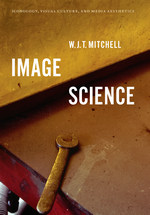 Image Science: Iconology, Visual Culture, and Media Aesthetics
W. J. T. Mitchell
University of Chicago Press, 2015 Almost thirty years ago, W. J. T. Mitchell’s Iconology helped launch the interdisciplinary study of visual media, now a central feature of the humanities. Along with his subsequent Picture Theory and What Do Pictures Want?, Mitchell’s now-classic work introduced such ideas as the pictorial turn, the image/picture distinction, the metapicture, and the biopicture. These key concepts imply an approach to images as true objects of investigation—an “image science.”
Continuing with this influential line of thought, Image Science gathers Mitchell’s most recent essays on media aesthetics, visual culture, and artistic symbolism. The chapters delve into such topics as the physics and biology of images, digital photography and realism, architecture and new media, and the occupation of space in contemporary popular uprisings. The book looks both backward at the emergence of iconology as a field and forward toward what might be possible if image science can indeed approach pictures the same way that empirical sciences approach natural phenomena.
Essential for those involved with any aspect of visual media, Image Science is a brilliant call for a method of studying images that overcomes the “two-culture split” between the natural and human sciences.
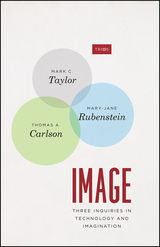 Image: Three Inquiries in Technology and Imagination
Mark C. Taylor, Mary-Jane Rubenstein, and Thomas A. Carlson
University of Chicago Press, 2021 The three essays in Image, written by leading philosophers of religion, explore the modern power of the visual at the intersection of the human and the technological.
Modern life is steeped in images, image-making, and attempts to control the world through vision. Mastery of images has been advanced by technologies that expand and reshape vision and enable us to create, store, transmit, and display images. The three essays in Image, written by leading philosophers of religion Mark C. Taylor, Mary-Jane Rubenstein, and Thomas A. Carlson, explore the power of the visual at the intersection of the human and the technological. Building on Heidegger’s notion that modern humanity aims to master the world by picturing or representing the real, they investigate the contemporary culture of the image in its philosophical, religious, economic, political, imperial, and military dimensions, challenging the abstraction, anonymity, and dangerous disconnection of contemporary images.
Taylor traces a history of capitalism, focusing on its lack of humility, particularly in the face of mortality, and he considers art as a possible way to reconnect us to the earth. Through a genealogy of iconic views from space, Rubenstein exposes the delusions of conquest associated with extraterrestrial travel. Starting with the pressing issues of surveillance capitalism and facial recognition technology, Carlson extends Heidegger’s analysis through a meditation on the telematic elimination of the individual brought about by totalizing technologies. Together, these essays call for a consideration of how we can act responsibly toward the past in a way that preserves the earth for future generations. Attending to the fragility of material things and to our own mortality, they propose new practices of imagination grounded in love and humility.
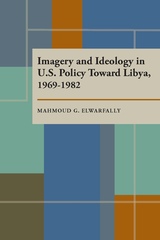 Imagery and Ideology in U.S. Policy Toward Libya 1969–1982
Mahmoud Gebril
University of Pittsburgh Press, 1988
How close to reality was the official U.S. image of Libya through the Nixon-Ford, Carter, and Reagan administrations? After recounting the actions of Libya and the United States in the Middle East since 1969, ElWahrfally concludes that it was very far from accurate.
Using personal interviews as well as scholarly research, ElWarfally demonstrates that recent U.S. relations with Libya, regardless of rhetoric, have been primarily determined by whether or not Libya serves U.S. interests in the region: maintaining access to Middle Eastern oil, protecting Israel, and limiting Soviet expansionism. Just as the official image of Libya has veered from one extreme to another, U.S. policy responses have also often conflicted with the publicly stated view.
The Nixon administration was at first friendly toward Libya, even though Qaddafi ejected the U.S. military and nationalized the oil industry, because of Libya's avowed anticommunism and U.S. dependence on Libyan oil. After 1976, the official U.S. image was more hostile, and Libya was attacked as a destabilizing influence in the Middle East. Outrage reached new heights during the Reagan administration, which made several unsuccessful covert attempts to unseat Qaddafi, mounted an embargo and military provocations, and in 1986 bombed Libya on a pretext later revealed to be false.
Combining theory with current history, this book demonstrates that fixed ideas and misinterpretation of events may have more to do with foreign policy behavior than facts do. Suggesting a new direction for research into relations between the superpowers and the Third World, it will interest scholars, students, and policymakers concerned with the Middle East.
Images and Conversations: Mexican Americans Recall a Southwestern Past
Text by Patricia Preciado Martin; Photographs by Louis Carlos Bernal
University of Arizona Press, 1983 Some Hispanic Americans living today can recall a time when barrio or ranch life was marked by a simplicity and neighborliness that has vanished with progress. These thirteen first-person accounts of southern Arizona residents capture a spirit evocative of the Hispanic presence in the Southwest—whether in San Antonio, Santa Fe, Pueblo, or Los Angeles—while striking photographs reflect the grace and dignity of these indomitable individuals.
Images and Identity: Educating Citizenship through Visual Arts
Edited by Rachel Mason and Carl-Peter Buschkuehle
Intellect Books, 2013 Highlighting the ways that digital media can be used in interdisciplinary curriculum, Images and Identity brings together ideas from art and citizenship teachers in the Czech Republic, Germany, Ireland, Malta, Portugal, and the United Kingdom on producing online curriculum materials. This book offers a practical strategy for ways these different, but related, subjects can be taught. The first part of the book explores issues of art and citizenship education within a European context while the second contains case studies of curriculum experiments that can be applied to global classrooms. It will be of great interest to students and teachers of art and citizenship education.
Images and Intervention: U.S. Policies in Latin America
Martha L. Cottam
University of Pittsburgh Press, 1994 Cottam explains the patterns of U.S. intervention in Latin America by focusing on the cognitive images that have dominated policy makers' world views, influenced the procession of information, and informed strategies and tactics. She employs a number of case studies of intervention and analyzes decision-making patterns from the early years of the cold war in Guatemala and Cuba to the post-cold-war policies in Panama and the war on drugs in Peru. Using two particular images-the enemy and the dependent-Cottam explores why U.S. policy makers have been predisposed to intervene in Latin America when they have perceived an enemy (the Soviet Union) interacting with a dependent (a Latin American country), and why these images led to perceptions that continued to dominate policy into the post-cold-war era.
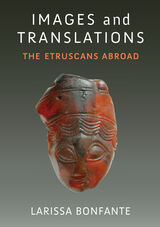 Images and Translations: The Etruscans Abroad
Larissa Bonfante
University of Michigan Press, 2023 Professor Larissa Bonfante’s great gift was the ability to evoke, in a fresh, immediate, and convincing way, the experiences, beliefs, and thoughts of people living more than two thousand years ago. Her final publication, Images and Translations: The Etruscans Abroad, communicates the sensations of other times and places, from the day-to-day to the solemnly ritualistic. The world of the Etruscans, sophisticated and pleasure-loving, radiated throughout a vast area of the ancient world – a world very different from our own. Relying on a wealth of creative works, Images and Translations examines the expertise and productions of the artists who made them, the tastes of those who used them, and the sometimes surprising results of the exchanges between creators and buyers. Just as the French demand for Chinese ceramics in the seventeenth century gave birth to the unprecedented famille colors, so the production of Greek ceramics for the Etruscan market produced singularly expressive depictions. Humorous, pious, or erotic to the buyers, they could be shocking to the culture that made them. Images and Translations explores areas in much closer economic and cultural contact than is usually recognized. The volume finds threads of connection not only between Italy and Greece, but between Italy and northern Europe—today’s France and Germany—as well as between Italy and the Near East. Etruscan influence runs through Western history, into the Renaissance, and emerges in imagery still evocative today.
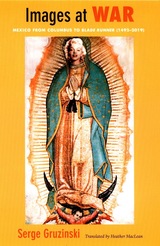 Images at War: Mexico From Columbus to Blade Runner (1492-2019)
Serge Gruzinski
Duke University Press, 2001 “If colonial America was the melting pot of modernity, it was because it was also a fabulous laboratory of images. . . . Just as much as speech and writing, the image can be a vehicle for all sorts of power and resistance.” So writes Serge Gruzinski in the introduction to Images at War, his striking reinterpretation of the Spanish colonization of Mexico. Concentrating on the political meaning of the baroque image and its function within a multicultural society, Gruzinski compares its ubiquity in Mexico to our modern fascination with images and their meaning.
Although the baroque image played a decisive role in many arenas, especially that of conquest and New World colonization, its powerful resonance in the sphere of religion is a focal point of Gruzinski’s study. In his analysis of how images conveyed meaning across linguistic barriers, he uncovers recurring themes of false images, less-than-perfect replicas, the uprooting of peoples and cultural memories, and the violence of iconoclastic destruction. He shows how various ethnic groups—Indians, blacks, Europeans—left their distinct marks on images of colonialism and religion, coopting them into expressions of identity or instruments of rebellion. As Gruzinski’s story unfolds, he tells of Aztec idols, the cult of the Virgin of Guadalupe, conquistadors, Franciscans, and neoclassical attempts to repress the baroque. In the final chapter he discusses the political and religious implications of contemporary imagery—such as that in Mexican soap operas—and speculates about the future of images in Latin America.
Originally written in French, this work makes available to an English audience a seminal study of Mexico and the role of the image in the New World.
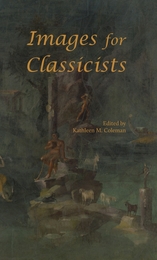 Images for Classicists
Kathleen M. Coleman
Harvard University Press How did the Greeks translate tales into images? Why do artistic depictions of ancient myths sometimes “contradict” the textual versions that we think of as canonical? What caused the Romans to be anxious about decorated ceilings? Can numismatic images solve problems in Augustan politics or explain the provenance of the Warren Cup? How are the curators of ancient artifacts to supply the high-quality digital images that scholars need in order to answer these questions? And how are text-based scholars to make productive use of them? Images have their own semantic language, and their survival, usually divorced from their original context, makes it hard to interpret them with nuance and sophistication. Images for Classicists starts from the premise that the visual and textual records from antiquity are indispensable complements to one another and demonstrates some of the ways in which text and image, taken together, can complicate and enrich our understanding of ancient culture. While attempting to dissolve the distinctions between text- and artifact-based scholars, it also tries to bridge the gap between academy and museum by exploring the challenges that the digital revolution poses to curators and sketching some of the ways in which image-based collections may be deployed in the future.
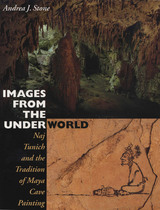 Images from the Underworld: Naj Tunich and the Tradition of Maya Cave Painting
By Andrea J. Stone
University of Texas Press, 1995 In 1979, a Kekchi Maya Indian accidentally discovered the entrance to Naj Tunich, a deep cave in the Maya Mountains of El Peten, Guatemala. One of the world's few deep caves that contain rock art, Naj Tunich features figural images and hieroglyphic inscriptions that have helped to revolutionize our understanding of ancient Maya art and ritual. In this book, Andrea Stone takes a comprehensive look at Maya cave painting from Preconquest times to the Colonial period. After surveying Mesoamerican cave and rock painting sites and discussing all twenty-five known painted caves in the Maya area, she focuses extensively on Naj Tunich. Her text analyzes the images and inscriptions, while photographs and line drawings provide a complete visual catalog of the cave art, some of which has been subsequently destroyed by vandals. This important new body of images and texts enlarges our understanding of the Maya view of sacred landscape and the role of caves in ritual. It will be important reading for all students of the Maya, as well as for others interested in cave art and in human relationships with the natural environment.
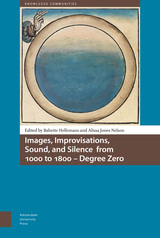 Images, Improvisations, Sound, and Silence from 1000 to 1800 - Degree Zero
Edited by Babette Hellemans and Alissa Jones Nelson
Amsterdam University Press, 2018 The act of drawing a line or uttering a word is often seen as integral to the process of making art. This is especially obvious in music and the visual arts, but applies to literature, performance, and other arts as well. These collected essays, written by scholars from diverse fields, take a historical view of the richness of creation out of nothing (creatio ex nihilo) in order to draw out debates, sometimes implicit and sometimes formally stated, about the production and reproduction of cultural meaning in a period of great change and novelty, between the beginnings of the medieval intellectual tradition and the imprint of the Enlightenment. The authors pose the following questions: Do tradition and creativity conflict with one another, or are they complementary? What are the tensions between composition and live performance? What is the role of the audience in perceiving the object of art? Are such objects fixed or flexible? What about the status of the event? Is the event part of creation, in the sense that it disturbs the still waters of historical continuity? These and other questions build on the foundation of Roland Barthes' concept of Degree Zero, offering new insights into what it means to create.
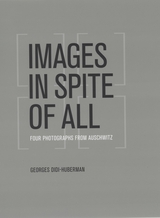 Images in Spite of All: Four Photographs from Auschwitz
Georges Didi-Huberman
University of Chicago Press, 2008 Of one and a half million surviving photographs related to Nazi concentration camps, only four depict the actual process of mass killing perpetrated at the gas chambers. Images in Spite of All reveals that these rare photos of Auschwitz, taken clandestinely by one of the Jewish prisoners forced to help carry out the atrocities there, were made as a potent act of resistance.
Available today because they were smuggled out of the camp and into the hands of Polish resistance fighters, the photographs show a group of naked women being herded into the gas chambers and the cremation of corpses that have just been pulled out. Georges Didi-Huberman’s relentless consideration of these harrowing scenes demonstrates how Holocaust testimony can shift from texts and imaginations to irrefutable images that attempt to speak the unspeakable. Including a powerful response to those who have criticized his interest in these images as voyeuristic, Didi-Huberman’s eloquent reflections constitute an invaluable contribution to debates over the representability of the Holocaust and the status of archival photographs in an image-saturated world.
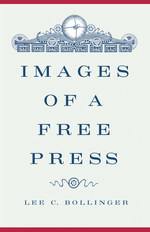 Images of a Free Press
Lee C. Bollinger
University of Chicago Press, 1991 Rich in historical detail, Images of a Free Press is an elegant, powerful guide to the evolution of our modern conception of freedom of the press, which finds expression in laws that protect print journalism and regulate broadcast media. Bollinger argues that this distinction remains meaningful but he advocates a more sophisticated approach to issues of privacy, access, and technology. Providing concrete guidelines for improving media laws, Images of a Free Press is a vital First Amendment primer for lawyers, media professionals, and critics, and all concerned citizens.
"Images of a Free Press is the natural sequel to Lee Bollinger's first book, The Tolerant Society, and is destined to become a standard in first amendment scholarship."—Rodney A. Smolla, Constitutional Commentary
"Revisiting themes he first explored some fifteen years ago, Bollinger now adds further to our understanding of the complex relationship among the First Amendment, the Supreme Court, the public, the press and the democratic process. This is a work of insight, sensitivity, and power. Bollinger has a profound knowledge of and a deep affection for his subject, and it shows."—Geoffrey R. Stone, Michigan Law Review
"This thoughtful, understated book remains a call to come join the town meeting and hammer out some new rules of order. Scholars and citizens alike could do well to read Bollinger's book and accept his challenge."—Yale Law Review
"For a number of years, Lee Bollinger has argued that the First Amendment has been applied differently to the print media than it has been to the broadcast media. In his new book, Images of a Free Press, Bollinger provides a concise, persuasive account of why this is so—and why it ought to be so."—Columbia Law Review
Images of America in Revolutionary France
Michèle R. Morris, Editor
Georgetown University Press, 1990 This bilingual collection of essays, the fruits of a conference held in 1989 to commemorate the join Bicentennials of Georgetown University and the French Revolution, illuminates the various ways in which the American Revolution and its aftermath directly and indirectly influenced France before and after the French Revolution. The essays cluster around several basic themes: the condition of Native Americans and African-Americans, French perceptions of political, religious, and economic issues in the new republic, and the ways in which French images of America were affected by travel literature and the performing and plastic arts. The intercultural and interdisciplinary approaches taken by the fifteen authors are equally various and include social and political history, literary history and criticism, and linguistics.
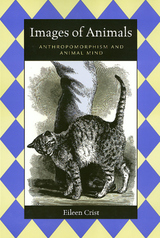 Images Of Animals
Eileen Crist
Temple University Press, 2000 Seeing a cat rubbing against a person, Charles Darwin described her as "in an affectionate frame of mind"; for Samuel Barnett, a behavioralist, the mental realm is beyond the grasp of scientists andbehavior must be described technically, as a physical action only. What difference does this difference make? In Eileen Crist's analysis of the language used to portray animal behavior, the difference "is that in the reader's mind the very image of the cat's 'body' is transfigured...from an experiencing subject...into a vacant object."
Images of Animals examines the literature of behavioral science, revealing how works with the common aim of documenting animal lives, habits, and instincts describe "realities that are worlds apart." Whether the writer affirms the Cartesian verdict of an unbridgeable chasm between animals and humans or the Darwinian panorama of evolutionary continuity, the question of animal mind is ever present and problematic in behavioral thought. Comparing the naturalist writings of Charles Darwin, Jean Henri Fabre, and George and Elizabeth Peckham to works of classical ethology by Konrad Lorenz and Nikolaas Tinbergen and of contemporary sociobiology, Crist demonstrates how words matter. She does not attempt to defend any of these constructions as a faithful representation of animal existence, but to show how each internally coherent view molds the reader's understanding of animals. Rejecting the notion that "a neutral language exists, or can be constructed, which yields incontestably objective accounts of animal behavior," Crist argues that "language is not instrumental in the depiction of animals and, in particular, it is never impartial with respect to the question of animal mind."
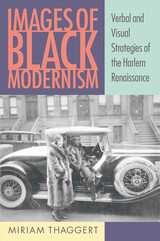 Images of Black Modernism: Verbal and Visual Strategies of the Harlem Renaissance
Miriam Thaggert
University of Massachusetts Press, 2010 Focusing on the years from 1922 to 1938, this book revisits an important moment in black cultural history to explore how visual elements were used in poems, novels, and photography to undermine existing stereotypes. Miriam Thaggert identifies and analyzes an early form of black American modernism characterized by a heightened level of experimentation with visual and verbal techniques for narrating and representing blackness. The work of the writers and artists under discussion reflects the creative tension between the intangibility of some forms of black expression, such as spirituals, and the materiality of the body evoked by other representations of blackness, such as "Negro" dialect.
By paying special attention to the contributions of photographers and other visual artists who have not been discussed in previous accounts of black modernism, Thaggert expands the scope of our understanding of the Harlem Renaissance and contributes to a growing recognition of the importance of visual culture as a distinct element within, and not separate from, black literary studies.
Thaggert trains her critical eye on the work of James Weldon Johnson, Nella Larsen, George Schuyler, Carl Van Vechten, James Van Der Zee, and Aaron Siskind—artists who experimented with narrative and photographic techniques in order to alter the perception of black images and to question and reshape how one reads and sees the black body. Examining some of the more problematic authors and artists of black modernism, she challenges entrenched assumptions about black literary and visual representations of the early to mid twentieth century.
Thaggert concludes her study with a close look at the ways in which Harlem and the Harlem Renaissance were reimagined and memorialized in two notable texts—Wallace Thurman's 1932 satire Infants of the Spring and the Metropolitan Museum of Art's controversial 1969 exhibition "Harlem on My Mind: The Cultural Capital of Black America, 1900–1968."
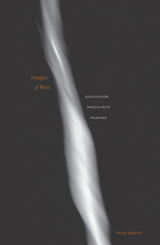 Images of Bliss: Ejaculation, Masculinity, Meaning
Murat Aydemir
University of Minnesota Press, 2007 Aristotle believed semen to be the purest of all bodily secretions, a vehicle for the spirit or psyche that gives form to substance. For Proust’s narrator in Swann’s Way, waking to find he has experienced a nocturnal emission, it is the product of “some misplacing of my thigh.” The heavy metal band Metallica used it to adorn an album cover. Beyond its biological function, semen has been applied with surprising frequency to metaphorical and narratological purposes. In Images of Bliss, Murat Aydemir undertakes an original and extensive analysis of images of male orgasm and semen. In a series of detailed case studies—Aristotle’s On the Generation of Animals; Andres Serrano’s use of bodily fluids in his art; paintings by Holbein and Leonardo; Proust’s In Search of Lost Time; hard-core pornography (both straight and gay); and key texts from the poststructuralist canon, including Lacan on the phallus, Bataille on expenditure, Barthes on bliss, and Derrida on dissemination—Aydemir traces the complex and often contradictory possibilities for imagination, description, and cognition that both the idea and the reality of semen make available. In particular, he foregrounds the significance of male ejaculation for masculine subjectivity. More often than not, Aydemir argues, the event or object of ejaculation emerges as the instance through which identity, meaning, and gender are not so much affirmed as they are relentlessly and productively questioned, complicated, and displaced. Combining close readings of diverse works with subtle theoretical elaboration and a keen eye for the cultural ideals and anxieties attached to sexuality, Images of Bliss offers a convincing and long overdue critical exploration of ejaculation in Western culture. Murat Aydemir is assistant professor of comparative literature at the University of Amsterdam.
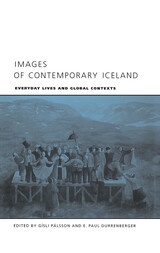 Images of Contemporary Iceland: Everyday Lives and Global Contexts
Gisli Palsson
University of Iowa Press, 1996 The Anthropology of Iceland presents the first perspectives on Icelandic anthropology from both Icelandic and foreign anthropologists. The thirteen essays in this volume are divided into four themes: ideology and action; kinship and gender; culture, class, and ethnicity; and the Commonwealth period of circa 930 to 1220, which saw the flowering of sagas. Insider and outsider viewpoints on such topics as the Icelandic women's movement, the transformation of the fishing industry, the idea of mystical power in modern Iceland, and archaeological research in Iceland merge to form an international, comparative discourse. Individually and collectively, by bringing the insights of anthropology to bear on Iceland, the native and foreign authors of this volume carry Iceland into the realm of modern anthropology, advancing our understanding of the island's people and the practice of anthropology.
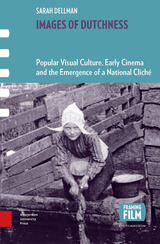 Images of Dutchness: Popular Visual Culture, Early Cinema and the Emergence of a National Cliché, 1800-1914
Sarah Dellmann
Amsterdam University Press, 2018 Why do early films present the Netherlands as a country full of canals and windmills, where people wear traditional costumes and wooden shoes, while industries and modern urban life are all but absent? Images of Dutchness investigates the roots of this visual repertoire from diverse sources, ranging from magazines to tourist brochures, from anthropological treatises to advertising trade cards, stereoscopic photographs, picture postcards, magic lantern slide sets and films of early cinema. This richly illustrated book provides an in-depth study of the fascinating corpus of popular visual media and their written comments that are studied for the first time. Through the combined analysis of words and images, the author identifies not only what has been considered Ÿtypically DutchŒ in the long nineteenth century, but also provides new insights into the logic and emergence of national clichés in the Western world.
Images of English: A Cultural History of the Language
Richard W. Bailey
University of Michigan Press, 1993 Images of English demonstrates how people's opinions about the English language often reflect prejudice and hope, bigotry and pride, scorn and celebration. The book offers a fascinating perspective on attitudes toward the English language--the rise and fall of ideas that English is nearly perfect or tumbling into decline.
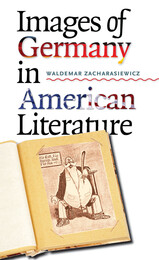 Images of Germany in American Literature
Waldemar Zacharasiewicz
University of Iowa Press, 2007 Although German Americans number almost 43 million and are the largest ethnic group in the United States, scholars of American literature have paid little attention to this influential and ethnically diverse cultural group. In a work of unparalleled depth and range, Waldemar Zacharasiewicz explores the cultural and historical background of the varied images of Germany and Germans throughout the past two centuries. Using an interdisciplinary approach known as comparative imagology, which borrows from social psychology and cultural anthropology, Zacharasiewicz samples a broad spectrum of original sources, including literary works, letters, diaries, autobiographical accounts, travelogues, newspaper reports, films, and even cartoons and political caricatures.
Starting with the notion of Germany as the ideal site for academic study and travel in the nineteenth century and concluding with the twentieth-century image of Germany as an aggressive country, this innovative work examines the ever-changing image of Germans and Germany in the writings of Louisa May Alcott, Samuel Clemens, Henry James, William James, George Santayana, W. E. B. Du Bois, John Dewey, H. L. Mencken, Katherine Anne Porter, Kay Boyle, Thomas Wolfe, Upton Sinclair, Gertrude Stein, Kurt Vonnegut, Thomas Pynchon, William Styron, Walker Percy, and John Hawkes, among others.
 Images of History: 19th and Early 20th Century Latin American Photographs as Documents
Robert M. Levine
Duke University Press, 1980 In this work Robert M. Levine undertakes two separate and important tasks: to provide the first overview of the history of photography in Latin America until the advent of the cheap cameras that permitted mass photography, and to analyze the photographic record for clues to the use of the images as historical documents.
Levine has woven together an account of the development of photographic equipment and processes, with the artists and entrepreneurs who actually took the pictures, and places the emergence of photography firmly in the historical context of Latin American societies.
Treating the photographs themselves—some 225 in all—Levine develops criteria for questions we can ask of the photographs in an attempt to extract emotional, psychological, and personal information, as well as the more obvious material evidence. This is an often subjective process, one that can lead to differing results, and observers may well come to conclusions departing radically from those of the author. But this may well be one of the most important functions of an innovative work, the creation of controversy that stimulates forward motion in a discipline.
Images of Kin: NEW AND SELECTED POEMS
Michael S. Harper
University of Illinois Press, 1977 "Harper's poetry is not limited by color or attitude. In Images of Kin, Harper amazes with his keen sense of political and personal histories, his breadth of expression. This collection fixes Harper as one of the dominant poetic voices of his generation" -- Chicago Sun-Times
"It is Mr. Harper's achievement to have projected his most difficult and complex insights and feelings through the epical manner, yet at the same time carried us along to identify with him." -- New York Times Book Review
Images of Occupation in Dutch Film: Memory, Myth and the Cultural Legacy of War
Wendy Burke
Amsterdam University Press, 2017 The German occupation of the Netherlands during World War II left a lasting mark on Dutch memory and culture. This book is the first to explore depictions of that period in films made a generation later, between 1962 and 1986. As Dutch public opinion towards the war altered over the postwar decades, the historical trajectory of Dutch recovery and reconstruction-political, economic, and, most complicated of all, psychological-came to be revealed, often unconsciously, in the films of the period.
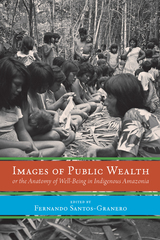 Images of Public Wealth or the Anatomy of Well-Being in Indigenous Amazonia
Edited by Fernando Santos-Granero
University of Arizona Press, 2015 What is considered a good life in contemporary societies? Can we measure well-being and happiness? Reflecting a global interest on the topics of well-being, happiness, and the good life in the face of the multiple failures of millennial capitalism, Images of Public Wealth or the Anatomy of Well-Being in Indigenous Amazonia deliberately appropriates a concept developed by classical economists to understand wealth accumulation in capitalist societies in order to denaturalize it and assess its applicability in non-capitalist kin-based societies.
Mindful of the widespread discontent generated by the ongoing economic crisis in postindustrial societies as well as the renewed attempts by social scientists to measure more effectively what we consider to be “development” and “economic success,” the contributors to this volume contend that the study of public wealth in indigenous Amazonia provides not only an exceptional opportunity to apprehend native notions of wealth, poverty, and the good life, but also to engage in a critical revision of capitalist constructions of living well.
Through ethnographic analysis and thought-provoking new approaches to contemporary and historical cases, the book’s contributors reveal how indigenous views of wealth—based on the abundance of intangibles such as vitality, good health, biopower, and convivial relations—are linked to the creation of strong, productive, and moral individuals and collectivities, differing substantially from those in capitalist societies more inclined toward the avid accumulation and consumption of material goods.
Images of Science: Essays on Realism and Empiricism
Edited by Paul M. Churchland and Clifford A. Hooker
University of Chicago Press, 1985 "Churchland and Hooker have collected ten papers by prominent philosophers of science which challenge van Fraassen's thesis from a variety of realist perspectives. Together with van Fraassen's extensive reply . . . these articles provide a comprehensive picture of the current debate in philosophy of science between realists and anti-realists."—Jeffrey Bub and David MacCallum, Foundations of Physics Letters
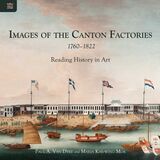 Images of the Canton Factories 1760–1822: Reading History in Art
Paul A. Van Dyke and Maria Kar-wing Mok
Hong Kong University Press, 2015 Hundreds of Chinese export paintings of Canton trading houses and shopping streets are in museums and private collections throughout the world, and scholars of art and history have often questioned the reliability of these historical paintings. In this illustrated volume, Paul Van Dyke and Maria Mok examine these Chinese export paintings by matching the changes in the images with new historical data collected from various archives. Many factory paintings are reliable historical records in their own right and can be dated to a single year. Dating images with such precision was not possible in the past owing to insufficient information on the scenes. The new findings in this volume provide unprecedented opportunities to re-date many art works and prove that images of the Canton factories painted on canvas by Chinese artists are far more trustworthy than what scholars have believed in the past.
Images of the Child
Harry Eiss
University of Wisconsin Press, 1994
This collection of articles on images of the child offers an excellent range of perspectives on an equally wide range of concerns, including advertising, girls' book series, rap music, realistic fiction, games, dolls, violence, and movies. Taken together as a book, this collection confirms the complexity of the world of childhood, and demonstrates how strongly images of the child reflect the entire culture.
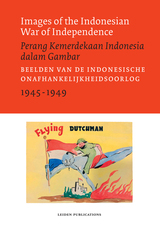 Images of the Indonesian War of Independence, 1945-1949/Perang Kemerdekaan Indonesia dalam Gambar
Sander van der Horst
Amsterdam University Press, 2022 Four years of protracted negotiations and bitter warfare passed between the declaration of Indonesian independence on 17 August, 1945, and the official transfer of sovereignty on 27 December, 1949. Whereas the newly proclaimed Republic of Indonesia rejected the colonial regime and hence any attempt at ‘recolonization’ by the Dutch after the Japanese occupation (1942-1945), the Dutch framed their return to the archipelago as a mission to restore ‘order and peace’. Images of the Indonesian War. Many of these materials, alongside photographs and oral history collections, ended up in the collections of the KITLV and eventually the Leiden University Libraries. This trilingual (English, Dutch and Indonesian) catalogue accompanies a digital exhibition of some fifty unique items. The selection made demonstrates the sharply contrasting perspectives on the legitimacy of the Republic and Dutch colonialism, and also offers first-hand testimonies of a bitter war with a huge imbalance of casualties.
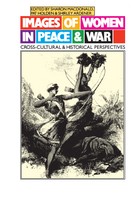 Images of Women in Peace and War: Cross-cultural and Historical Perspectives
Sharon Macdonald
University of Wisconsin Press, 1988 As warriors, freedom fighters and victims, as mothers, wives and prostitutes, and as creators and members of peace movements, women are inevitably caught up in the net of war. Yet women’s participation in warfare and peace campaigns has often been underestimated or ignored.
Images of Women in Peace and War explores women’s relationships to war, peace, and revolution, from the Amazons, Inka and Boadicea, to women soldiers in South Africa, Mau Mau freedom fighters and the protestors at Greenham Common. The contributors consider not only the reality of women’s participation but also look at how their actions have been perceived and represented across cultures and through history. They examine how sexual imagery is constructed, how it is used to delineate women’s relation to warfare and how these images have sometimes been subverted in order to challenge the status quo. The book raises important questions about whether women have a special prerogative to promote peace and considers whether the experience of motherhood leads to a distinctive women’s position on war. The authors find that their analyses lead them to deal with arguments on the basic nature of the sexes and to reevaluate our concepts of “peace,” “war,” and “gender.”
Imaginal Landscapes: Reflections on the Mystical Visions of Jorge Luis Borges and Emanuel Swedenborg
William Rowlandson
Swedenborg Foundation Publishers, 2015 In 1978, the great Argentine short story writer Jorge Luis Borges described Emanuel Swedenborg as the most extraordinary man in recorded history. In Imaginal Landscapes, William Rowlandson offers a brief but deep-reaching study of this often-unknown appreciation, showing how the Swedish visionary's influence has gone a long way to explain Borges's preoccupations with parallel existences, the infinite, and the mystery of language. Delightfully written and steeped in a wonderful sense of curiosity, Imaginal Landscapes cements Rowlandson's position as one of the UK's leading scholars on Borges, and it raises important questions about the criteria we often use to assess the lives and works of those thinkers and writers who have come to be labeled as mystics.
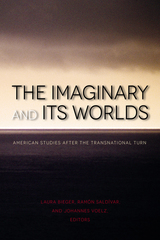 The Imaginary and Its Worlds: American Studies after the Transnational Turn
Edited by Laura Bieger, Ramón Saldívar, and Johannes Voelz
Dartmouth College Press, 2013 The Imaginary and Its Worlds collects essays that boldly rethink the imaginary as a key concept for cultural criticism. Addressing both the emergence and the reproduction of the social, the imaginary is ideally suited to chart the consequences of the transnational turn in American studies. Leading scholars in the field from the United States and Europe address the literary, social, and political dimensions of the imaginary, providing a methodological and theoretical groundwork for American studies scholarship in the transnational era and opening new arenas for conceptualizing formations of imaginary belonging and subjectivity. This important state-of-the-field collection will appeal to a broad constituency of humanists working to overcome methodological nationalism. The Imaginary and Its Worlds: An Introduction • LITERARY IMAGINARIES • Imagining Cultures: The Transnational Imaginary in Postrace America - Ramón Saldívar • The Necessary Fragmentation of the (U.S.) Literary-Cultural Imaginary - Lawrence Buell • Imaginaries of American Modernism - Heinz Ickstadt • SOCIAL IMAGINARIES • William James versus Charles Taylor: Philosophy of Religion and the Confines of the Social and Cultural Imaginaries - Herwig Friedl • The Shaping of We-Group Identities in the African American Community: A Perspective of Figurational Sociology on the Cultural Imaginary - Christa Buschendorf • Russia’s Californio Romance: The Other Shores of Whitman’s Pacific - Lene Johannessen • Form Games: Staging Life in the Systems Epoch - Mark Seltzer • POLITICAL IMAGINARIES • Real Toads - Walter Benn Michaels • Obama Unwound: The Romanticism of Victory and the Defeat of Compromise - Christopher Newfield • Barack Obama’s Orphic Mysteries - Donald E. Pease • Coda. The Imaginary and the Second Narrative: Reading as Transfer - Winfried Fluck • Contributors • Index
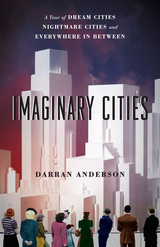 Imaginary Cities: A Tour of Dream Cities, Nightmare Cities, and Everywhere in Between
Darran Anderson
University of Chicago Press, 2017 For as long as humans have gathered in cities, those cities have had their shining—or shadowy—counterparts. Imaginary cities, potential cities, future cities, perfect cities. It is as if the city itself, its inescapable gritty reality and elbow-to-elbow nature, demands we call into being some alternative, yearned-for better place.
This book is about those cities. It’s neither a history of grand plans nor a literary exploration of the utopian impulse, but rather something different, hybrid, idiosyncratic. It’s a magpie’s book, full of characters and incidents and ideas drawn from cities real and imagined around the globe and throughout history. Thomas More’s allegorical island shares space with Soviet mega-planning; Marco Polo links up with James Joyce’s meticulously imagined Dublin; the medieval land of Cockaigne meets the hopeful future of Star Trek. With Darran Anderson as our guide, we find common themes and recurring dreams, tied to the seemingly ineluctable problems of our actual cities, of poverty and exclusion and waste and destruction. And that’s where Imaginary Cities becomes more than a mere—if ecstatically entertaining—intellectual exercise: for, as Anderson says, “If a city can be imagined into being, it can be re-imagined.” Every architect, philosopher, artist, writer, planner, or citizen who dreams up an imaginary city offers lessons for our real ones; harnessing those flights of hopeful fancy can help us improve the streets where we live.
Though it shares DNA with books as disparate as Calvino’s Invisible Cities and Jane Jacobs’s Death and Life of Great American Cities, there’s no other book quite like Imaginary Cities. After reading it, you’ll walk the streets of your city—real or imagined—with fresh eyes.
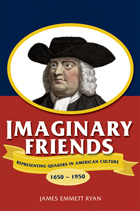 Imaginary Friends: Representing Quakers in American Culture, 1650–1950
James Emmett Ryan
University of Wisconsin Press, 2009 When Americans today think of the Religious Society of Friends, better known as Quakers, they may picture the smiling figure on boxes of oatmeal. But since their arrival in the American colonies in the 1650s, Quakers’ spiritual values and social habits have set them apart from other Americans. And their example—whether real or imagined—has served as a religious conscience for an expanding nation.
Portrayals of Quakers—from dangerous and anarchic figures in seventeenth-century theological debates to moral exemplars in twentieth-century theater and film (Grace Kelly in High Noon, for example)—reflected attempts by writers, speechmakers, and dramatists to grapple with the troubling social issues of the day. As foils to more widely held religious, political, and moral values, members of the Society of Friends became touchstones in national discussions about pacifism, abolition, gender equality, consumer culture, and modernity.
Spanning four centuries, Imaginary Friends takes readers through the shifting representations of Quaker life in a wide range of literary and visual genres, from theological debates, missionary work records, political theory, and biography to fiction, poetry, theater, and film. It illustrates the ways that, during the long history of Quakerism in the United States, these “imaginary” Friends have offered a radical model of morality, piety, and anti-modernity against which the evolving culture has measured itself.
Winner, CHOICE Outstanding Academic Book Award
 Imaginary Futures: From Thinking Machines to the Global Village
Richard Barbrook
Pluto Press, 2007 This book is a history of the future. It shows how our contemporary understanding of the Net is shaped by visions of the future that were put together in the 1950s and 1960s.
Richard Barbrook argues that at the height of the Cold War the Americans invented the only working model of communism in human history, the Internet. Yet, for all of its libertarian potential, the goal of this high-tech project was geopolitical dominance. The ownership of time was control over the destiny of humanity. The potentially subversive theory of cybernetics was transformed into the military-friendly project of "artificial intelligence." Capitalist growth became the fastest route to the "information society." The rest of the world was expected to follow America's path into the networked future.
Today, we're still being told that the Net is creating the information society---and that America today is everywhere else tomorrow. Barbrook shows how this idea serves a specific geopolitical purpose. Thankfully, at the beginning of the twenty-first century, the DIY ethic of the Net shows that people can resist these authoritarian prophecies by shaping information technologies in their own interest. Ultimately, if we don't want the future to be what it used to be, we must invent our own improved and truly revolutionary future.
The Imaginary Geography of Hollywood Cinema 1960-2000
Christian Long
Intellect Books, 2017 The Imaginary Geography of Hollywood Cinema 1960–2000 combines digital cartography with close readings of representative films from 1960 to 2000. Christian B. Long offers a unique history of twentieth century Hollywood narrative cinema, one that is focused on the intersection of the geographies of narrative location, production, consumption, and taste in the era before the rise of digital cinema. Long redraws the boundaries of film history, both literally and figuratively, by cataloging films’ narrative locations on digital maps in order to illustrate where Hollywood actually locates its narratives over time. A PDF version of this book is available for free in open access via the OAPEN Library platform, www.oapen.org It has been made available under a Creative Commons Attribution 4.0 International Public License and is part of Knowledge Unlatched.
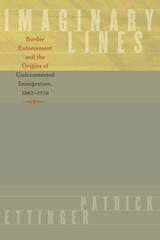 Imaginary Lines: Border Enforcement and the Origins of Undocumented Immigration, 1882-1930
By Patrick Ettinger
University of Texas Press, 2009 Southwest Book Award, Border Regional Library Association, 2011 Although popularly conceived as a relatively recent phenomenon, patterns of immigrant smuggling and undocumented entry across American land borders first emerged in the late nineteenth century. Ingenious smugglers and immigrants, long and remote boundary lines, and strong push-and-pull factors created porous borders then, much as they do now. Historian Patrick Ettinger offers the first comprehensive historical study of evolving border enforcement efforts on American land borders at the turn of the twentieth century. He traces the origins of widespread immigrant smuggling and illicit entry on the northern and southern United States borders at a time when English, Irish, Chinese, Italian, Russian, Lebanese, Japanese, Greek, and, later, Mexican migrants created various "backdoors" into the United States. No other work looks so closely at the sweeping, if often ineffectual, innovations in federal border enforcement practices designed to stem these flows. From upstate Maine to Puget Sound, from San Diego to the Lower Rio Grande Valley in Texas, federal officials struggled to adapt national immigration policies to challenging local conditions, all the while battling wits with resourceful smugglers and determined immigrants. In effect, the period saw the simultaneous "drawing" and "erasing" of the official border, and its gradual articulation and elaboration in the midst of consistently successful efforts to undermine it.
The Imaginary Lover
Alicia Suskin Ostriker
University of Pittsburgh Press, 1986 • Winner of the 1987 William Carlos Williams Award presented by the Poetry Society of America
With The Imaginary Lover, Alicia Suskin Ostriker takes her place among the most striking and original poets whose work is informed by feminist consciousness. Her characterization of the best poetry by women, in the New York Times Book Review, aptly describes this book: “intimate rather than remote, passionate rather than distant, defying divisions between emotion and intellect, private and public, life and art, writer and reader.” To read her poems is to “discover not only more of what it means to be a woman but more of what it means to be human.”
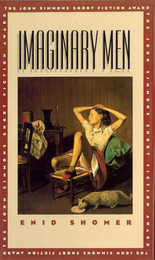 Imaginary Men
Enid Shomer
University of Iowa Press, 1993 Even the tamest characters in Imaginary Men test the rules to see where they can be broken and where they hold true. In Enid Shomer's world, endless misunderstandings sprout from goodwill, women and men burn with a desire that forces them to create themselves as they evolve, people grasp their relatedness to others only fleetingly, goodness is as great a mystery as evil. For the unappreciated Harry Goldring, tormented by his unshakable label of familymensch, wildness is expressed first in panic attacks, then in daydreams. At the other end of Shomer's highly colored spectrum is killer Elvis Thornberry, a “man you wouldn't notice unless he held a gun to your head or saved your life.” Balancing these more troubled characters are Shomer's many improbable lovers and friends: Lavell, who sees something of herself in the untrainable hunting dog owned by her younger lover; Diane, who takes back her unfaithful husband only after inventing a lie that puts her on an equal footing; Leila Pinkerton and Fontane Walker, who were "as close to friendship as they could get, given that Leila was white, Fontane was black, and they lived in a world full of people who claimed to know what that meant." In all of Shomer's powerful stories, family is the mold we break out of as well as the lap we seek comfort in; family myths create mysterious emblems of freedom. Listening to her resonant voice, we witness the wild, raw moments when people lose control, when the wildness—submerged or not—that they both avoid and rush toward bleeds through.
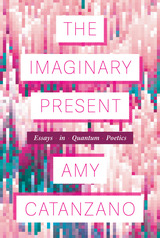 The Imaginary Present: Essays in Quantum Poetics
Amy Catanzano
University of Michigan Press, 2025 The Imaginary Present by award-winning poet and professor Amy Catanzano explores cutting-edge scientific fields such as particle physics and astrophysics, and branches of physics such as quantum theory and relativity, through a poetic vision equally loyal to the imagination and rationality. Drawing upon her groundbreaking research and artist residencies at major scientific research centers like CERN and the U.S. National Science Foundation’s NOIRLab, as well as talks and poetry readings at esteemed institutions, Catanzano invites enthusiasts of poetry and science to consider what can be achieved through greater collaboration between these fields.
In linked chapters that fluidly blend lyric essay, literary and scientific analysis, poetry, theory, and memoir, The Imaginary Present offers refreshing new insights on a wide range of thinkers over the past 100 years, including poets Rae Armantrout and M. NourbeSe Philip, novelists Alfred Jarry and Virginia Woolf, comic book writer Grant Morrison, and physicists Albert Einstein and Werner Heisenberg. The introduction explores why poetry and physics are capable of jointly investigating our most fundamental questions about the universe and discusses the history of the art-science connection in addition to the author’s own journey. In searching for the groundbreaking ways that artists and scientists can collaborate, The Imaginary Present offers readers both reasoned grounding and poetic framing for an interdisciplinary poetics and praxis based on science.
Imaginary Royalty
Miranda Field
Four Way Books, 2017 The sisters in this collection live and breathe as one. We witness the devastating impact of loss on this unit while also following the isolate self’s ongoing navigation of an ever-changing world.
 Imagination and Logos: Essays on C. P. Cavafy
Panagiotis Roilos
Harvard University Press, 2010 This book explores diverse but complementary interdisciplinary approaches to the poetics, intertexts, and influence of the work of C. P. Cavafy (Konstantinos Kavafis), one of the most important twentieth-century European poets. Written by leading international scholars in a number of disciplines (critical theory, gender studies, comparative literature, English studies, Greek studies, anthropology, classics), the essays of this volume situate Cavafy’s poetry within the broader contexts of modernism and aestheticism and investigate its complex and innovative responses to European literary traditions (from Greek antiquity to modernity) as well as its multifaceted impact on major figures of world literature—from North America to South Africa.
Contributors include Eve Sedgwick, Helen Vendler, Dimitrios Yatromanolakis, Richard Dellamora, Mark Doty, James Faubion, Diana Haas, John Chioles, Albert Henrichs, Kathleen Coleman, Michael Paschalis, Peter Jeffreys, and Panagiotis Roilos.
Imagination and Interpretation in Kant: The Hermeneutical Import of the Critique of Judgment
Rudolf A. Makkreel
University of Chicago Press, 1990 In this illuminating study of Kant's theory of imagination and its role in interpretation, Rudolf A. Makkreel argues against the commonly held notion that Kant's transcendental philosophy is incompatible with hermeneutics. The charge that Kant's foundational philosophy is inadequate to the task of interpretation can be rebutted, explains Makkreel, if we fully understand the role of imagination in his work. In identifying this role, Makkreel also reevaluates the relationship among Kant's discussions of the feeling of life, common sense, and the purposiveness of history.
 Imagination and Invention
Gilbert Simondon
University of Minnesota Press, 2023 A radical rethinking of the theory and the experience of mental images
Here, in English translation for the first time, is Gilbert Simondon’s fundamental reconception of the mental image and the theory of imagination and invention. Drawing on a vast range of mid-twentieth-century theoretical resources—from experimental psychology, cybernetics, and ethology to the phenomenological reflections of Sartre and Merleau-Ponty—Imagination and Invention provides a comprehensive account of the mental image and adds a vital new dimension to the theory of psychical individuation in Simondon’s earlier, highly influential work. Simondon traces the development of the mental image through four phases: first a bundle of motor anticipations, the image becomes a cognitive system that mediates the organism’s relation to its milieu, then a symbolic and abstract integration of motor and affective experience to, finally, invention, a solution to a problem of life that requires the externalization of the mental image and the creation of a technical object. An image cannot be understood from the perspective of one phase alone, he argues, but only within the trajectory of its progressive metamorphosis.
Imagination and Play in the Electronic Age
Dorothy G. Singer and Jerome L. Singer
Harvard University Press, 2005 Television, video games, and computers are easily accessible to twenty-first-century children, but what impact do they have on creativity and imagination? In this book, two wise and long-admired observers of children's make-believe look at the cognitive and moral potential--and concern--created by electronic media.
As Dorothy and Jerome Singer show, violent images in games and TV are as toxic as many observers have feared by stimulating destructive ideas and troubling aggression. But should all electronic media be banned from children's lives? Calmly and authoritatively, the Singers argue that in fact some screen time can enrich children's creativity and play, and can even promote school readiness. With guidance from parents and teachers, empathy, creativity, and imagination can expand and intensify in the electronic age.
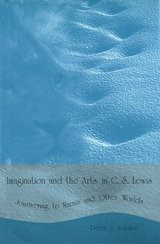 Imagination and the Arts in C.S. Lewis: Journeying to Narnia and Other Worlds
Peter J. Schakel
University of Missouri Press, 2002 Imagination has long been regarded as central to C. S. Lewis's life and to his creative and critical works, but this is the first study to provide a thorough analysis of his theory of imagination, including the different ways he used the word and how those uses relate to each other. Peter Schakel begins by concentrating on the way reading or engaging with the other arts is an imaginative activity. He focuses on three books in which imagination is the central theme—Surprised by Joy, An Experiment in Criticism, and The Discarded Image—and shows the important role of imagination in Lewis's theory of education. He then examines imagination and reading in Lewis's fiction, concentrating specifically on the Chronicles of Narnia, the most imaginative of his works. He looks at how the imaginative experience of reading the Chronicles is affected by the physical texture of the books, the illustrations, revisions of the texts, the order in which the books are read, and their narrative "voice," the "storyteller" who becomes almost a character in the stories. Imagination and the Arts in C. S. Lewis also explores Lewis's ideas about imagination in the nonliterary arts. Although Lewis regarded engagement with the arts as essential to a well- rounded and satisfying life, critics of his work and even biographers have given little attention to this aspect of his life. Schakel reviews the place of music, dance, art, and architecture in Lewis's life, the ways in which he uses them as content in his poems and stories, and how he develops some of the deepest, most significant themes of his stories through them. Schakel concludes by analyzing the uses and abuses of imagination. He looks first at "moral imagination." Although Lewis did not use this term, Schakel shows how Lewis developed the concept in That Hideous Strength and The Abolition of Man long before it became popularized in the 1980s and 1990s. While readers often concentrate on the Christian dimension of Lewis's works, equally or more important to him was their moral dimension. Imagination and the Arts in C. S. Lewis will appeal to students and teachers of both children's literature and twentieth-century British writers. It will also be of value to readers who wish to compare Lewis's creations with more recent imaginative works such as the Harry Potter series.
Imagination Beyond Nation: Latin American Popular Culture
Eva Bueno
University of Pittsburgh Press, 1999 Can scholarly pursuit of soap operas and folk art actually reveal a national imagination? This innovative collection features studies of iconography in Mexico, telenovelas in Venezuela, drama in Chile, cinema in Brazil, comic strips and tango in Argentina, and ceramics in Peru. In examining these popular arts, the scholars gathered here ask the same broad questions: what precisely is a national culture at the level of the popular? The national idea in Latin America emerges from these pages as a problematic, divided one, worth sustained attention in the field of culture studies. Many different arts come forth in all their richness and vitality, compelling us to look, listen, and understand.
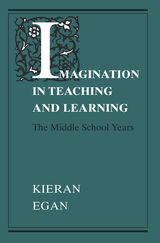 Imagination in Teaching and Learning: The Middle School Years
Kieran Egan
University of Chicago Press, 1992 It is widely believed that a child's imagination ought to be
stimulated and developed in education. Yet, few teachers
understand what imagination is or how it lends itself to
practical methods and techniques that can be used easily in
classroom instruction. In this book, Kieran Egan—winner of
the prestigious Grawemeyer Award for his work on
imagination—takes up where his Teaching as Story Telling
left off, offering practical help for teachers who want to
engage, stimulate, and develop the imaginative and learning
processes of children between the ages of eight to fifteen.
This book is not about unusually imaginative students and
teachers. Rather, it is about the typical student's
imaginative life and how it can be stimulated in learning,
how the average teacher can plan to achieve this aim, and how
the curriculum can be structured to help achieve this aim.
Slim and determinedly practical, this book contains a wealth
of concrete examples of curriculum design and teaching
techniques structured to appeal specifically to children in
their middle school years.
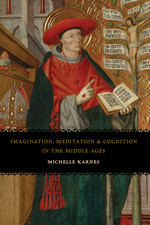 Imagination, Meditation, and Cognition in the Middle Ages
Michelle Karnes
University of Chicago Press, 2011 In Imagination, Meditation, and Cognition in the Middle Ages, Michelle Karnes revises the history of medieval imagination with a detailed analysis of its role in the period’s meditations and theories of cognition. Karnes here understands imagination in its technical, philosophical sense, taking her cue from Bonaventure, the thirteenth-century scholastic theologian and philosopher who provided the first sustained account of how the philosophical imagination could be transformed into a devotional one. Karnes examines Bonaventure’s meditational works, the Meditationes vitae Christi, the Stimulis amoris, Piers Plowman, and Nicholas Love’s Myrrour, among others, and argues that the cognitive importance that imagination enjoyed in scholastic philosophy informed its importance in medieval meditations on the life of Christ. Emphasizing the cognitive significance of both imagination and the meditations that relied on it, she revises a long-standing association of imagination with the Middle Ages. In her account, imagination was not simply an object of suspicion but also a crucial intellectual, spiritual, and literary resource that exercised considerable authority.
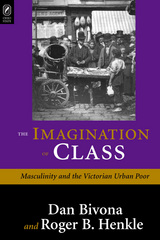 THE IMAGINATION OF CLASS: MASCULINITY AND THE VICTORIAN URBAN POOR
Dan Bivona and Roger B. Henkle
Ohio State University Press, 2006 A fascinating meld of two scholars’ research and conclusions, The Imagination of Class is a synthetic journey through middle-class Victorian discourse posed by poverty in the midst of plenty—but not that alone. Rather Dan Bivona and Roger B. Henkle argue that the representation of abject poverty in the nineteenth century also displaced anxieties aroused by a variety of challenges to Victorian middle class masculinity. The book’s main argument, in fact, is that the male middle class imagery of urban poverty in the Victorian age presents a complex picture, one in which anxieties about competition, violence, class-based resentment, individuality, and the need to differentiate oneself from the scions of inherited wealth influence mightily the ways in which the urban poor are represented. In the representations themselves, the urban poor are alternately envisioned as sentimentalized (and feminized) victims who stimulate middle class affective response, as the objects of the professionalized discourses of the social sciences (and social services), and as an often hostile social force resistant to the “culturalizing,” taming processes of a maternalist social science.
Through carefully nuanced discussions of a variety of Victorian novelists, journalists, and sociological investigators (some well known, like Dickens, and others less well known, like Masterman and Greenwood), the book offers new insight into the role played by the imagination of the urban poor in the construction of Victorian middle class masculinity. Whereas many scholars have discussed the feminization of the poor, virtually no one has addressed how the poor have served as a site at which middle class men fashioned their own class and gender identity.
 Imagination Transformed: The Evolution of the Female Character in Keat's Poetry
Karla Alwes
Southern Illinois University Press, 1993 From the mortal maidens of 1817 to the omnipotent goddesses of 1819, Keats uses successive female characters as symbols portraying the salvation and destruction, the passion and fear that the imagination elicits. Karla Alwes traces the change in these female figures—multidimensional and mysteriously protean—and shows that they do more than comprise a symbol of the female as a romantic lover. They are the gauge of Keats’s search for identity. As Keats’s poetry changes with experience, from celebration to denial of the earth, the females change from meek to threatening to a final maternal and conciliatory figure. Keats consistently maintained a strict dichotomy between the flesh-and-blood women he referred to in his letters and the created females of his poetry, in the same way that he rigorously sought to abandon the real for the ideal in his poetry. In her study of Keats’s poetry, Alwes dramatizes the poet’s struggle to come to terms with his two consummate ideals—women and poetry. She demonstrates how his female characters, serving as lovers, guides, and nemeses to the male heroes of the poems, embody not only the hope but also the disappointment that the poet discovers as he strives to reconcile feminine and masculine creativity. Alwes also shows how the myths of Apollo, which Keats integrated into his poetry as early as February 1815, point up his contradictory need for, yet fear of, the feminine. She argues that Keats’s attempt to overcome this fear, impossible to do by concentrating solely on Apollo as a metaphor for the imagination, resulted in his eventual use of maternal goddesses as poetic symbols. The goddess Moneta in "The Fall of Hyperion" reclaims the power of the maternal earth to represent the final stage in the development of the female. In combining the wisdom of the Apollonian realm with the compassion of the feminine earth, Moneta is more powerful than Apollo and able to show the poet who does not recognize both realms that he is only a "dreamer," one who "venoms all his days, / Bearing more woe than all his sins deserve." Because of Moneta’s admonishment, Keats becomes the poet capable of creating "To Autumn." In this final ode, Keats taps the transcendent power inherent in the temporal beauty of the earth. His imagination, once attempting to leave the earth, now goes beyond the Apollonian ideal into the realm of salvation—the human heart—that connects him to the earth. And because of his poetic reconciliation between heaven and earth, Keats is ultimately able to portray an earthly timelessness in which "summer has o’er-brimmed" the bees’ "clammy cells," making for "warm days [that] will never cease."
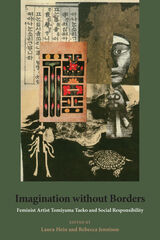 Imagination without Borders: Feminist Artist Tomiyama Taeko and Social Responsibility
Laura Hein and Rebecca Jennison, Editors
University of Michigan Press, 2010 Tomiyama Taeko, a Japanese visual artist born in 1921, is changing the way World War II is remembered in Japan, Asia, and the world. Her work deals with complicated moral and emotional issues of empire and war responsibility that cannot be summed up in simple slogans, which makes it compelling for more than just its considerable beauty. Japanese today are still grappling with the effects of World War II, and, largely because of the inconsistent and ambivalent actions of the government, they are widely seen as resistant to accepting responsibility for their nation’s violent actions against others during the decades of colonialism and war. Yet some individuals, such as Tomiyama, have produced nuanced and reflective commentaries on those experiences, and on the difficulty of disentangling herself from the priorities of the nation despite her lifelong political dissent. Tomiyama’s sophisticated visual commentary on Japan’s history—and on the global history in which Asia is embedded—provides a compelling guide through the difficult terrain of modern historical remembrance, in a distinctively Japanese voice.
Imaginative Horizons: An Essay in Literary-Philosophical Anthropology
Vincent Crapanzano
University of Chicago Press, 2003 How do people make sense of their experiences? How do they understand possibility? How do they limit possibility? These questions are central to all the human sciences. Here, Vincent Crapanzano offers a powerfully creative new way to think about human experience: the notion of imaginative horizons. For Crapanzano, imaginative horizons are the blurry boundaries that separate the here and now from what lies beyond, in time and space. These horizons, he argues, deeply influence both how we experience our lives and how we interpret those experiences, and here sets himself the task of exploring the roles that creativity and imagination play in our experience of the world.
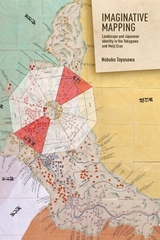 Imaginative Mapping: Landscape and Japanese Identity in the Tokugawa and Meiji Eras
Nobuko Toyosawa
Harvard University Press, 2019 Landscape has always played a vital role in shaping Japan’s cultural identity. Imaginative Mapping analyzes how intellectuals of the Tokugawa and Meiji eras used specific features and aspects of the landscape to represent their idea of Japan and produce a narrative of Japan as a cultural community. These scholars saw landscapes as repositories of local history and identity, stressing Japan’s differences from the models of China and the West.
By detailing the continuities and ruptures between a sense of shared cultural community that emerged in the seventeenth century and the modern nation state of the late nineteenth century, this study sheds new light on the significance of early modernity, one defined not by temporal order but rather by spatial diffusion of the concept of Japan. More precisely, Nobuko Toyosawa argues that the circulation of guidebooks and other spatial narratives not only promoted further movement but also contributed to the formation of subjectivity by allowing readers to imagine the broader conceptual space of Japan. The recurring claims to the landscape are evidence that it was the medium for the construction of Japan as a unified cultural body.
Imaginative Possibilities: Conversations with Twenty-First-Century Latinx Writers
Maceo Montoya
University of Pittsburgh Press, 2024 Two decades into the twenty-first century, contemporary Latinx writers have established themselves within an evolving literary tradition. Imaginative Possibilities collects interviews with some of these authors to explores the writers’ processes, aesthetics, creative trajectories, and places within the larger body of Latinx literature. The interviews address artistic, professional, and cultural issues including the building of intellectual communities, the writing and publication process, and the practical economics of making a living. US Latinx writers discuss how they navigate the overwhelmingly white publishing industry, the academic book market, higher education, and MFA culture while exploring questions of representation, hybridity, and mestizaje. Through these conversations, a truth emerges: Latinx literature speaks not with one voice, but many.
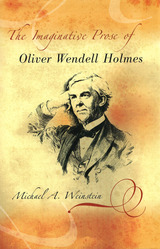 The Imaginative Prose of Oliver Wendell Holmes
Michael A. Weinstein
University of Missouri Press, 2006
One of the most popular serious writers of the mid-nineteenth century, Oliver Wendell Holmes, Sr., was a major figure of the New England Renaissance and wrote seven volumes of imaginative prose that were hybrids of essay and fiction. His four table-talk books initiated the form of the dramatized essay, and his three novels—styled as romances “medicated” by intellectual discourse—were among the first examples of ideologically didactic fiction.
Michael A. Weinstein now traces Holmes’s intellectual trajectory across these works to show how his thought evolved over the course of his life and in response to America’s transition from an agrarian to an industrial society. Through close readings of this eclectic ouevre—including such lesser-known late works as A Mortal Antipathy and Over the Teacups—he offers a comprehensive interpretation of Holmes’s thought concerning the American national character, showing him to have had a far richer understanding of human experience than other scholars have previously supposed.
This is the first book to consider Holmes’s imaginative prose as a whole and to defend its systematic structure against critics who have branded him a dilettante lacking system or seriousness. Through a careful explication of characters and themes, Weinstein finds at the core of these works a high regard for self-determination as a quintessential American value: an affirmation of the freedom of individuals to decide for themselves how to respond to a human condition that can be as perilous as it is promising. In the course of his analysis, Weinstein engages the spectrum of Holmes criticism and also shows how Holmes anticipated the cultural problems of modernity, pluralism, psychoanalysis, and existentialism, as well as postmodern literary expression.
Through his insightful assessment, Weinstein gives us an author whose respect for individual judgment is as relevant in today’s society, torn by cultural politics, as it was in his own time. His book restores Holmes to his place in the canon while introducing a wider readership to a perceptive writer who offers not only insight into the moral possibilities of American identity but also genuine wit and wisdom about the art of living.
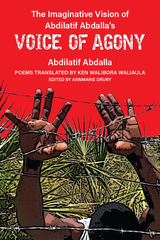 The Imaginative Vision of Abdilatif Abdalla’s Voice of Agony
Abdilatif Abdalla, edited by Annmarie Drury
University of Michigan Press, 2024 The extraordinary Swahili poetry collection Sauti ya Dhiki (Voice of Agony), is a collection of prison poems composed by Abdilatif Abdalla between 1969 and 1972. He originally wrote the poems while incarcerated by the government of Jomo Kenyatta for sedition as a result of his political activism and smuggled them out of prison on scraps of paper. Imaginative Vision is the first complete literary translation into English—translated by the late Kenyan novelist and scholar Ken Walibora Waliaula and edited by Annmarie Drury—of one of the most esteemed and influential collections of Swahili poetry of the twentieth century.
Yet, Imaginative Vision is also something more. Even as it centers on a literary translation of a singularly beautiful and influential book of poetry, it tells English-language readers the story of that book. Supporting materials illuminate the circumstances of its inception when Abdilatif, aged 22, was arrested and tried. They explore what the volume meant to its first readers and its affiliations with subsequent extraordinary works of prison literature by Alamin Mazrui and Ngũgĩ wa Thiong’o. They trace its links to literary art of the past, including the nineteenth-century poet Muyaka bin Haji, and to writing that followed. And they explain social and historical aspects of the Swahili coastal world that nurtured Abdilatif’s political engagement and stunning verbal art. Under the editorship of scholar, translator, and poet Annmarie Drury, contributors bring insights from their diverse backgrounds to present contextualizing material that illuminates the poems at the heart of this book.
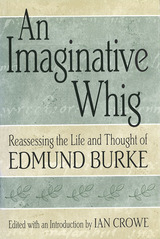 An Imaginative Whig: Reassessing the Life and Thought of Edmund Burke
Edited & Intro by Ian Crowe
University of Missouri Press, 2005
This collection of essays shifts the focus of scholarly debate away from the themes that have traditionally dominated the study of Edmund Burke. In the past, largely ideology-based or highly textual studies have tended to paint Burke as a “prophet” or “precursor” of movements as diverse as conservatism, political pragmatism, and romanticism. In contrast, these essays address prominent issues in contemporary society—multiculturalism, the impact of postmodern and relativist methodologies, the boundaries of state-church relationships, and religious tolerance in modern societies—by emphasizing Burke’s earlier career and writings and focusing on his position on historiography, moral philosophy, jurisprudence, aesthetics, and philosophical skepticism.
The essays in this collection, written by some of today’s most renowned Burke scholars, will radically challenge our deeply rooted assumptions about Burke, his thought, and his place in the history of Western political philosophy.
 Imagine Lagos: Mapping History, Place, and Politics in a Nineteenth-Century African City
Ademide Adelusi-Adeluyi
Ohio University Press, 2024 Written from a digital humanities perspective, this book combines historical sources, maps, and a walking cartography to create new perspectives on the nineteenth-century history of Lagos, West Africa’s most populous city. What traces do people leave in the places where they live, and even where they die? This book addresses the spatial history of nineteenth-century Lagos, rebuilding its past as a series of encounters: between men and women, between past and present, between enslaved and free, between living and dead, and finally between land and lagoon. In Imagine Lagos, Ademide Adelusi-Adeluyi argues that the invention, destruction, and reinvention of spatial markers in Lagos—the streets, markets, roads, squares, palaces, and lagoons where these encounters occurred—was crucial to negotiations over identity, power, and freedom. Research for this book combines oral and archival sources from three countries with the experience of three summers of walking the streets of Lagos. Contrary to historical interpretations that render the physical city as a blank, featureless space in desperate need of constant repair, this book offers a variety of visual and textual narratives to push readers to imagine the old city. Throughout Imagine Lagos, historical maps join other texts—including colonial correspondence and reports, missionary letters, oríkì (Yoruba praise poetry), and newspaper articles—to create a complex collage of urban life in Lagos. Streets emerge as sites of historical memories, and Adelusi-Adeluyi’s maps of the mid-nineteenth-century city reveal and catalog layers of change. A focus on the city as a whole—as both a physical and social landscape—brings us closer than ever to understanding the lives of Lagosians between 1845 and 1872. In old Lagos, the streets keep their histories. The story maps and full-resolution maps for this book are available at https://newmapsoldlagos.com.
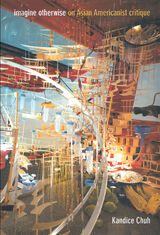 Imagine Otherwise: On Asian Americanist Critique
Kandice Chuh
Duke University Press, 2003 Imagine Otherwise is an incisive critique of the field of Asian American studies. Recognizing that the rubric "Asian American" elides crucial differences, Kandice Chuh argues for reframing Asian American studies as a study defined not by its subjects and objects, but by its critique. Toward that end, she urges the foregrounding of the constructedness of "Asian American" formations and shows how this understanding of the field provides the basis for continuing to use the term "Asian American" in light of—and in spite of—contemporary critiques about its limitations. Drawing on the insights of poststructuralist theory, postcolonial studies, and investigations of transnationalism, Imagine Otherwise conceives of Asian American literature and U.S. legal discourse as theoretical texts to be examined for the normative claims about race, gender, and sexuality that they put forth. Reading government and legal documents, novels including Carlos Bulosan's America Is in the Heart, John Okada's No-No Boy, Chang-rae Lee's A Gesture Life, Ronyoung Kim's Clay Walls, and Lois Ann Yamanaka's Blu's Hanging, and the short stories "Immigration Blues" by Bienvenido Santos and "High-Heeled Shoes" by Hisaye Yamamoto, Chuh works through Filipino American and Korean American identity formation and Japanese American internment during World War II as she negotiates the complex and sometimes tense differences that constitute 'Asian America' and Asian American studies.
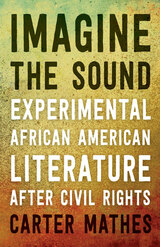 Imagine the Sound: Experimental African American Literature after Civil Rights
Carter Mathes
University of Minnesota Press, 2014 The post–Civil Rights era was marked by an explosion of black political thought and aesthetics. Reflecting a shifting horizon of expectations around race relations, the unconventional sounds of free jazz coupled with experimental literary creation nuanced the push toward racial equality and enriched the possibilities for aesthetic innovation within the Black Arts Movement. In Imagine the Sound, Carter Mathes demonstrates how African American writers used sound to further artistic resistance within a rapidly transforming political and racial landscape. While many have noted the oral and musical qualities of African American poetry from the post–Civil Rights period, Mathes points out how the political implications of dissonance, vibration, and resonance produced in essays, short stories, and novels animated the ongoing struggle for equality. Situating literary works by Henry Dumas, Larry Neal, and Toni Cade Bambara in relation to the expansive ideas of sound proposed by free jazz musicians such as Marion Brown and Sun Ra, not only does this book illustrate how the presence of sound can be heard and read as political, but it recuperates critically neglected, yet important, writers and musicians. Ultimately, Mathes details how attempts to capture and render sound through the medium of writing enable writers to envision alternate realities and resistance outside of the linear frameworks offered by the Civil Rights and Black Power movements. In precise and elegant prose, Mathes shows how in conceptualizing sound, African American writers opened up the political imaginations of their readers. By exploring this intellectual convergence of literary artistry, experimental music, and sound theory, Imagine the Sound reveals how taking up radically new forms of expression allows us to speak to the complexities of race and political resistance.
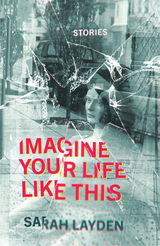 Imagine Your Life Like This
Sarah Layden
University of Wisconsin Press, 2023 The characters who inhabit Sarah Layden's short story collection are on the verge of change—if only they could see themselves and their situations with greater clarity. Caught in the midst of crises, they stumble toward the future without fully understanding their past. Layden’s deft, spare prose sketches worlds and lives with telling details, juggling disparate strands of identity and often revealing the deeper truths in unexpected moments of epiphany.
A bride-to-be puts on her detective hat when her groom goes missing. A woman returns to college after escaping an abusive marriage, only to discover her professor is a fraud. Reunited at a high school reunion, two former classmates completely misinterpret a critical incident from a decade prior. These and other characters find themselves lonely and in limbo, their self-identity as blurry as the old photographs they cling to with stubborn intensity.
Set mostly in the Midwest and upstate New York, Imagine Your Life Like This captures everyday Americans in all their discontent, misunderstandings, and dogged determination for a better world.
Imagined Communities on the Baltic Rim, from the Eleventh to Fifteenth Centuries
Edited by Wojtek Jezierski and Lars Hermanson
Amsterdam University Press, 2016 Prior to the high Middle Ages, the Baltic Rim was largely terra incognita-but by the late Middle Ages, it was home to diverse small and large communities. But the Baltic Rim was not simply the place those people lived-it was also an imagined space through which they defined themselves and their identities. This book traces the transformation of the Baltic Rim in this period through a focus on the self-image of a number of communities: urban and regional, cultic, missionary, legal, and political. Contributors look at the ways these communities defined themselves in relationship to other groups, how they constructed their identities and customs, and what held them together or tore them apart.
Imagined Dialogues: Eastern European Literature in Conversation with American and English Literature
Gordana Crnkovic
Northwestern University Press, 1999 By conducting "imagined dialogues" between selected literary works--Eastern Europeans like Kiš and Borowski on one hand, American and English writers like Cage and Ishiguro on the other--this book proposes an effective new way of reading literature, one that goes beyond the narrowing categories of contemporary critical trends. A new perspective on each of the works emerges, as well as a heightened sense of the liberating power of literature.
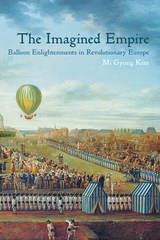 The Imagined Empire: Balloon Enlightenments in Revolutionary Europe
Mi Gyung Kim
University of Pittsburgh Press, 2016 The hot-air balloon, invented by the Montgolfier brothers in 1783, launched for the second time just days before the Treaty of Paris would end the American Revolutionary War. The ascent in Paris—a technological marvel witnessed by a diverse crowd that included Benjamin Franklin—highlighted celebrations of French military victory against Britain and ignited a balloon mania that swept across Europe at the end of the Enlightenment. This popular frenzy for balloon experiments, which attracted hundreds of thousands of spectators, fundamentally altered the once elite audience for science by bringing aristocrats and commoners together.
The Imagined Empire explores how this material artifact, the flying machine, not only expanded the public for science and spectacle but also inspired utopian dreams of a republican monarchy that would obliterate social boundaries. The balloon, Mi Gyung Kim argues, was a people-machine, a cultural performance that unified and mobilized the people of France, who imagined an aerial empire that would bring glory to the French nation. This critical history of ballooning considers how a relatively simple mechanical gadget became an explosive cultural and political phenomenon on the eve of the French Revolution.
 Imagined Empires: Tracing Imperial Nationalism in Eastern and Southeastern Europe
Dimitris Stamatopoulos
Central European University Press, 2021 The Balkans offer classic examples of how empires imagine they can transform themselves into national states (Ottomanism) and how nation-states project themselves into future empires (as with the Greek “Great Idea” and the Serbian “Načertaniye”). By examining the interaction between these two aspirations this volume sheds light on the ideological prerequisites for the emergence of Balkan nationalisms. With a balance between historical and literary contributions, the focus is on the ideological hybridity of the new national identities and on the effects of “imperial nationalisms” on the emerging Balkan nationalisms. The authors of the twelve essays reveal the relation between empire and nation-state, proceeding from the observation that many of the new nation-states acquired some imperial features and behaved as empires. This original and stimulating approach reveals the imperialistic nature of so-called ethnic or cultural nationalism.
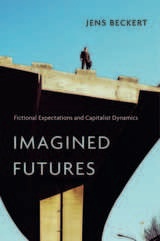 Imagined Futures: Fictional Expectations and Capitalist Dynamics
Jens Beckert
Harvard University Press, 2016 In a capitalist system, consumers, investors, and corporations orient their activities toward a future that contains opportunities and risks. How actors assess uncertainty is a problem that economists have tried to solve through general equilibrium and rational expectations theory. Powerful as these analytical tools are, they underestimate the future’s unknowability by assuming that markets, in the aggregate, correctly forecast what is to come.
Jens Beckert adds a new chapter to the theory of capitalism by demonstrating how fictional expectations drive modern economies—or throw them into crisis when the imagined futures fail to materialize. Collectively held images of how the future will unfold are critical because they free economic actors from paralyzing doubt, enabling them to commit resources and coordinate decisions even if those expectations prove inaccurate. Beckert distinguishes fictional expectations from performativity theory, which holds that predictions tend to become self-fulfilling prophecies. Economic forecasts are important not because they produce the futures they envision but because they create the expectations that generate economic activity in the first place. Actors pursue money, investments, innovations, and consumption only if they believe the objects obtained through market exchanges will retain value. We accept money because we believe in its future purchasing power. We accept the risk of capital investments and innovation because we expect profit. And we purchase consumer goods based on dreams of satisfaction.
As Imagined Futures shows, those who ignore the role of real uncertainty and fictional expectations in market dynamics misunderstand the nature of capitalism.
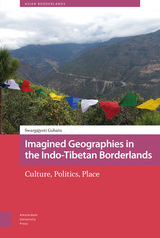 Imagined Geographies in the Indo-Tibetan Borderlands: Culture, Politics, Place
Swargajyoti Gohain
Amsterdam University Press, 2020 Imagined Geographies in the Indo-Tibetan Borderlands: Culture, Politics, Place is an ethnography of culture and politics in Monyul, a Tibetan Buddhist cultural region in west Arunachal Pradesh, Northeast India. For nearly three centuries, Monyul was part of the Tibetan state, and the Monpas — as the communities inhabiting this region are collectively known — participated in trans-Himalayan trade and pilgrimage. Following the colonial demarcation of the Indo-Tibetan boundary in 1914, the fall of the Tibetan state in 1951, and the India-China boundary war in 1962, Monyul was gradually integrated into India and the Monpas became a Scheduled Tribe. In 2003, the Monpas began a demand for autonomy under the leadership of Tsona Gontse Rinpoche. This book examines the narratives and politics of the autonomy movement regarding language, place-names, and trans-border kinship against the backdrop of the India-China border dispute. It explores how the Monpas negotiate multiple identities to imagine new forms of community that transcend regional and national borders.
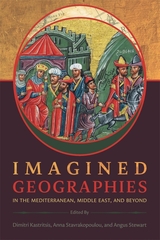 Imagined Geographies in the Mediterranean, Middle East, and Beyond
Dimitri Kastritsis
Harvard University Press, 2023 This collaborative volume focuses on imagined geography and the relationships among power, knowledge, and space. A sequel to Imperial Geographies in Byzantine and Ottoman Space, Imagined Geographies in the Mediterranean, Middle East, and Beyond shares with its predecessor a strong focus on the role of empire and ideas of space viewed in inter-regional and interdisciplinary terms.
Both volumes bring together specialists on history, art history, literature, and theater studies, but the present volume covers an even wider geography than the first. In addition to the core provinces of Byzantium and the Ottoman Empire in the eastern Mediterranean and Middle East, it also includes connections between these regions and others further away—notably Iran, Inner Asia, and the Indian Ocean. The essays collected here suggest that the phenomenon of imagined geographies is essentially discursive in nature, since Self and Other may only be defined relative to one another.
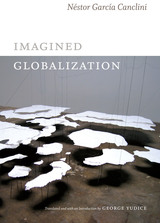 Imagined Globalization
Néstor García Canclini
Duke University Press, 2014 A leading figure in cultural studies worldwide, Néstor García Canclini is a Latin American thinker who has consistently sought to understand the impact of globalization on the relations between Latin America, Europe, and the United States, and among Latin American countries. In this book, newly available in English, he considers how globalization is imagined by artists, academics, migrants, and entrepreneurs, all of whom traverse boundaries and, at times, engage in conflicted or negotiated multicultural interactions. García Canclini contrasts the imaginaries of previous migrants to the Americas with those who live in transnational circuits today. He integrates metaphor and narrative, working through philosophical, anthropological, and socioeconomically grounded interpretations of art, literature, crafts, media, and other forms of expression toward his conclusion that globalization is, in important ways, a collection of heterogeneous narratives. García Canclini advocates global imaginaries that generate new strategies for dealing with contingency and produce new forms of citizenship oriented toward multiple social configurations rather than homogenization. This edition of Imagined Globalization includes a significant new introduction by George Yúdice and an interview in which the cultural theorist Toby Miller and García Canclini touch on events including the Arab Spring and Occupy Wall Street.
 Imagined Homes: Soviet German Immigrants in Two Cities
Hans Werner
University of Manitoba Press, 2007 Imagined Homes: Soviet German Immigrants in Two Cities is a study of the social and cultural integration of two migrations of German speakers from Eastern Europe and the Soviet Union to Winnipeg, Canada in the late 1940s, and Bielefeld, Germany in the 1970s. Employing a cross-national comparative framework, Hans Werner reveals that the imagined trajectory of immigrant lives influenced the process of integration into a new urban environment. Winnipeg’s migrants chose a receiving society where they knew they would again be a minority group in a foreign country, while Bielefeld’s newcomers believed they were “going home” and were unprepared for the conflict between their imagined homeland and the realities of post-war Germany. Werner also shows that differences in the way the two receiving societies perceived immigrants, and the degree to which secularization and the sexual and media revolutions influenced these perceptions in the two cities, were crucially important in the immigrant experience.
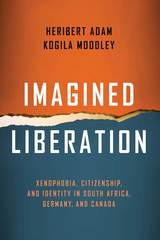 Imagined Liberation: Xenophobia, Citizenship, and Identity in South Africa, Germany, and Canada
Heribert Adam
Temple University Press, 2015 On a spectrum of hostility towards migrants, South Africa ranks at the top, Germany in the middle and Canada at the bottom. South African xenophobic violence by impoverished slum dwellers is directed against fellow Africans. “Foreign” Africans are blamed for a high crime rate and most other maladies of an imagined liberation.
Why would a society that liberated itself in the name of human rights turn against people who escaped human rights violations or unlivable conditions at home? What happened to the expected African solidarity? Why do former victims become victimizers?
With porous borders, South Africa is incapable of upholding the blurred distinction between endangered refugees and economic migrants. Imagined Liberation asks what xenophobic societies can learn from other immigrant societies, such as Canada, that avoided the backlash against multiculturalism in Europe. Heribert Adam and Kogila Moodley stress an innovative teaching of political literacy that makes citizens aware as to why they hate.
 Imagined Museums: Art and Modernity in Postcolonial Morocco
Katarzyna Pieprzak
University of Minnesota Press, 2010 Imagined Museums examines the intertwined politics surrounding art and modernization in Morocco from 1912 to the present by considering the structure of the museum not only as a modern institution but also as a national monument to modernity, asking what happens when museum monuments start to crumble. In an analysis of museum history, exhibition policy, the lack of national museum space for modern art, and postmodern exhibit spaces in Morocco, Katarzyna Pieprzak focuses on the role that art plays in the social fabric of a modernizing Morocco. She argues that the decay of colonial and national institutions of culture has invited the rethinking of the museum and generated countermuseums to stage new narratives of art, memory, and modernity. Through these spaces she explores a range of questions: How is modernity imagined locally? How are claims to modernity articulated? How is Moroccan modernity challenged globally? In this first cultural history of modern Moroccan art and its museums, Pieprzak goes beyond the investigation of national institutions to treat the history and evolution of multiple museums—from official state and corporate exhibition spaces to informal, popular, street-level art and performance spaces—as cultural architectures that both enshrine the past and look to the future.
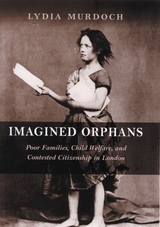 Imagined Orphans: Poor Families, Child Welfare, and Contested Citizenship in London
Murdoch, Lydia
Rutgers University Press, 2006 With his dirty, tattered clothes and hollowed-out face, Oliver Twist is the enduring symbol of the young indigent spilling out of orphanages and haunting the streets of late-nineteenth-century London. Although poor children were often portrayed as real-life Oliver Twists—either orphaned or abandoned by unworthy parents—they in fact frequently maintained contact and were eventually reunited with their families.
In Imagined Orphans, Lydia Murdoch focuses on this discrepancy between the representation and the reality of children’s experiences within welfare institutions—a discrepancy that she argues stems from conflicts over middle- and working-class notions of citizenship that arose in the 1870s and persisted until the First World War. Reformers’ efforts to depict poor children as either orphaned or endangered by abusive or “no-good” parents fed upon the poor’s increasing exclusion from the Victorian social body. Reformers used the public’s growing distrust and pitiless attitude toward poor adults to increase charity and state aid to the children.
With a critical eye to social issues of the period, Murdoch urges readers to reconsider the complex situations of families living in poverty. While reformers’ motivations seem well intentioned, she shows how their methods solidified the public’s antipoor sentiment and justified a minimalist welfare state that engendered a cycle of poverty. As they worked to fashion model citizens, reformers’ efforts to protect and care for children took on an increasingly imperial cast that would continue into the twentieth century.
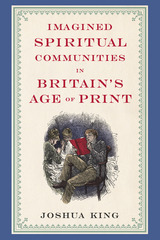 Imagined Spiritual Communities in Britain's Age of Print
Joshua King
Ohio State University Press, 2015 In Imagined Spiritual Communities in Britain’s Age of Print, Joshua King demonstrates how nineteenth-century Britons turned to the printed page to imagine themselves in Christian communities spanning their nation. In contrast with traditional views of the nineteenth century, which regard the period as a turning point for religion from a public life to a privatized decline, Imagined Spiritual Communities argues that the rapid growth of print culture and a voluntary religious market inspired vigorous efforts to form virtual national congregations of readers.
Focusing primarily on the work of Anglicans between the 1820s and 1890s, this study begins by freshly interpreting reading and educational programs promoted by Samuel Taylor Coleridge, Frederick Denison Maurice, and Matthew Arnold. King then traces the emergence of John Keble’s Christian Year as a catalyst for competing visions of a Christian nation united by private reading. He argues that this phenomenon illuminates the structure and reception of best-selling poetic cycles as diverse as Alfred Tennyson’s In Memoriam and Christina Rossetti’s late Verses. Ultimately, Imagined Spiritual Communities reveals how dreams of print-mediated spiritual communion generated new poetic genres and rhetorical strategies, theories and theologies of media and reading, and ambitious schemes of education and church reform.
Imagined States: Nationalism, Utopia, and Longing in Oral Cultures
edited by Luisa Del Giudice & Gerald Porter
Utah State University Press, 2003 An international ensemble of folklore scholars looks at varied ways in which national and ethnic groups have traditionally and creatively used imagined states of existence-some idealizations, some demonizations-in the construction of identities for themselves and for others. Drawing on oral traditions, especially as represented in traditional ballads, broadsides, and tale collections, the contributors consider fertile landscapes of the mind where utopias overflow with bliss and abundance, stereotyped national and ethnic caricatures define the lives of "others," nostalgia glorifies home and occupation, and idealized and mythological animals serve as cultural icons and guideposts to harmonious social life.
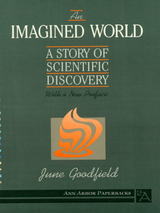 Imagined World: A Story of Scientific Discovery
June Goodfield
University of Michigan Press, 1991 An Imagined World is a drama of scientific discovery, with all its pitfalls, frustrations, tedium, cliff-hangers, and eventual breakthroughs. Goodfield accompanied for five years the team of Anna Brito, a young immunologist striving to solve the riddles posed by certain cancers and the immune system's response to them. Her narrative of their quest traces the close collaboration of the six ardently committed women and men working with Brito to confirm and develop her ideas. As the pieces of the research and the theory fall into place, her thoughts and feelings about her role in science come together in a complex and revealing pattern. An Imagined World succeeds in communicating to the reader the wonders of creativity in process. The author uncovers for us, through the acute observation of the daily life of the scientist, the basic humanity of science. Goodfield's compelling account, with its broad humanistic approach, continues to appeal not only to scientists and those involved in the field of science, but also to those involved in women's studies, anthropology, and sociology.
 Imagined Worlds
Freeman Dyson
Harvard University Press, 1997 Imagine a world where whole epochs will pass, cultures rise and fall, between a telephone call and the reply. Think of the human race multiplying 500-million fold, or evolving new, distinct species. Consider the technology of space colonization, computer-assisted reproduction, the “Martian potato.” One hundred years after H. G. Wells visited the future in The Time Machine, Freeman Dyson marshals his uncommon gifts as a scientist and storyteller to take us once more to that ever-closer, ever-receding time to come.
Since Disturbing the Universe, the book that first brought him international renown, Freeman Dyson has been helping us see ourselves and our world from a scientist’s point of view. In Imagined Worlds he brings this perspective to a speculative future to show us where science and technology, real and imagined, may be taking us. The stories he tells—about “Napoleonic” versus “Tolstoyan” styles of doing science; the coming era of radioneurology and radiotelepathy; the works of writers from Aldous Huxley to Michael Crichton to William Blake; Samuel Gompers and the American labor movement—come from science, science fiction, and history. Sharing in the joy and gloom of these sources, Dyson seeks out the lessons we must learn from all three if we are to understand our future and guide it in hopeful directions.
Whether looking at the Gaia theory or the future of nuclear weapons, science fiction or the dangers of “science worship,” seagoing kayaks or the Pluto Express, Dyson is concerned with ethics, with how we might mitigate the evil consequences of technology and enhance the good. At the heart of it all is the belief once expressed by the biologist J. B. S. Haldane, that progress in science will bring enormous confusion and misery to humankind unless it is accompanied by progress in ethics.
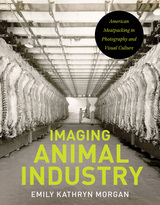 Imaging Animal Industry: American Meatpacking in Photography and Visual Culture
Emily Kathryn Morgan
University of Iowa Press, 2024 Imaging Animal Industry focuses on the visual culture of the American meat industry between 1890 and 1960. It describes how, during that period, photographs and other images helped to shape public perceptions of industrial-scale meat production. Although the meat industry today bans most photography at its facilities, in the past this was not always the case: the meat industry not only tolerated but welcomed cameras. Meatpacking companies and industry organizations regarded photographs as useful tools for creating and managing a vision of their activities, their innovations, and their contributions to the march of American economic and industrial progress.
Drawing on archival collections across the American Midwest, this book relates a history of the meatpacking industry’s use of images in the early to mid-twentieth century. In the process, it reveals the key role that images, particularly photographs, have played in assisting with the rise of industrial meat production.
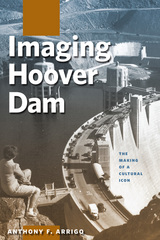 Imaging Hoover Dam: The Making of a Cultural Icon
Anthony F. Arrigo
University of Nevada Press, 2014 The mighty Hoover Dam, starting as a dream of land developers and farmers, became the most ambitious civil engineering project of the Great Depression. This landmark in the middle of the Mojave Desert, holding back the largest man-made lake in America, also became, like Mount Rushmore or the Empire State Building, a visual and cultural icon. The power and meanings of this icon came not through a single image but via myriad visual representations, in government propaganda, advertising, journalism, and art. Even before it was built, these images were used to shape the public’s perception of the project and frame the dam as the linchpin to an expanding American economic empire in the desert Southwest.
Anthony F. Arrigo has researched a wide array of primary sources and archival materials to trace the project from its earliest representations in illustrations to the documentary photography of its construction and later depictions of the structure in commercial promotions, fine art photography, and paintings. Analyzing Hoover Dam through the trajectory of imagery across several decades, rather than the narrative of its construction, illuminates the underlying cultural and ecological imperatives in the drive to build it, including the influence of religious doctrine and the American agrarian movement. Arrigo also discusses various portrayals of laborers, women, minority groups, nature, and technology in this imagery. In time, the visual icon of power and domination was commercialized to sell cars, vacations, and more.
Imaging Hoover Dam is an important work in both visual rhetoric and cultural studies. It will also intrigue readers interested in such varied topics as the history of the American Southwest, the Great Depression and the New Deal, social and environmental issues, and American popular culture.
Imaging Sensor Technologies and Applications
Wuqiang Yang
The Institution of Engineering and Technology, 2020 Imaging sensors are crucial for electronic imaging systems, including digital cameras, camera modules, medical imaging equipment, night vision equipment, radar and sonar, drones, and many others. This contributed book covers a wide range of frequency, sensing modalities and applications, including x-ray beam imaging sensors, optical scattering sensors, smart visual sensors in robotic systems, tuneable diode Laser absorption spectroscopy (TDLAS) sensors, light detection and ranging (LiDAR) sensors, microwave imaging sensors, electro-magnetic imaging with ultra-wideband (UWB) sensors, synthetic aperture radar (SAR), electrical resistance tomography (ERT) sensors, electrical tomography for medical applications, electro-magnetic tomography (EMT) sensors, micro sensors for cell and blood imaging, and ultrasound imaging sensors.
 Imaging Sound: An Ethnomusicological Study of Music, Art, and Culture in Mughal India
Bonnie C. Wade
University of Chicago Press, 1998 The rulers of the Mughal Empire of India, who reigned from 1526 to 1858, spared no expense as patrons of the arts. They left as their legacy an extraordinarily rich body of commissioned artistic projects, including illustrated manuscripts and paintings that represent music-making in numerous spheres of Mughal court life, particularly that of women. These images form the basis of Bonnie C. Wade's study of how musicians of Hindustan encountered and Indianized music from the Persian cultural sphere.
Combining ethnomusicological and art historical methods with history and lore, Wade focuses first on paintings for Akbar, showing how political and cultural agendas intertwined in the portrayal of his life and that of his grandfather Babur and father, Humayun. Wade then follows the depictions of music-making through paintings for Akbar's successors, Jahangir and Shah Jahan, to trace the gradual synthesis of Persian and Indian culture. Richly illustrated with reproductions of rare Mughal paintings, this work will appeal broadly to anyone interested in Indian history, ethnomusicology, and art history.
Imaging the City: Art, Creative Practices and Media Speculations
Edited by Steve Hawley, Edward Clift, and Kevin O'Brien
Intellect Books, 2016 Imaging the City brings together the work of designers, artists, dancers, and media specialists who cross the borders of design and artistic practices to investigate how we perceive the city; how we imagine it; how we experience it; and how we might better design it. Breaking disciplinary boundaries, editors Steve Hawley, Edward Clift, and Kevin O’Brien provocatively open up the field of urban analysis and thought to the perspectives of creative professionals from non-urban disciplines. With a cast of contributors from across the globe, Imaging the City offers international insight for engaging with—and forecasting the future for—our cities.
Imaging the Role: Makeup as a Stage in Characterization
Jenny Egan
Southern Illinois University Press, 1992 Concerned as much with acting as it is with makeup, this work illuminates every actor’s quest for character—starting with a search for clues concealed in the script. Yet few actors fully understand the bond between a character’s psyche and physical appearance, and makeup classes seldom give the subject the attention it deserves. Jenny Egan draws on her extensive experience to provide detailed instructions supported by clear illustrations for sculpting the face with paint, putty, and prostheses. She enlivens her instruction with personal anecdotes from her work on Broadway, television, and films with notables George C. Scott, Rip Torn, Maureen Stapleton, and Joseph Papp.
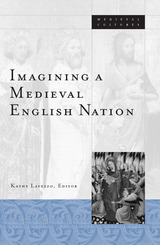 Imagining A Medieval English Nation
Kathy Lavezzo
University of Minnesota Press, 2003 The first comprehensive analysis of English national identity in the late Middle Ages During the late Middle Ages, the increasing expansion of administrative, legal, and military systems by a central government, together with the greater involvement of the commons in national life, brought England closer than ever to political nationhood. Examining a diverse array of texts—ranging from Latin and vernacular historiography to Lollard tracts, Ricardian poetry, and chivalric treatises—this volume reveals the variety of forms “England” assumed when it was imagined in the medieval West. These essays disrupt conventional thinking about the relationship between premodernity and modernity, challenge traditional preconceptions regarding the origins of the nation, and complicate theories about the workings of nationalism. Imagining a Medieval English Nation is not only a collection of new readings of major canonical works by leading medievalists, it is among the first book-length analyses on the subject and of critical interest. Contributors: Kathleen Davis, Bucknell U; L. O. Aranye Fradenburg, U of California, Santa Barbara; Andrew Galloway, Cornell U; Jill C. Havens, Baylor U; Peggy A. Knapp, Carnegie Mellon U; Larry Scanlon, Rutgers U; D. Vance Smith, Princeton U; Claire Sponsler, U of Iowa; Lynn Staley, Colgate U; Thorlac Turville-Petre, U of Nottingham.
Imagining Adoption: Essays on Literature and Culture
Marianne Novy, Editor
University of Michigan Press, 2003 Imagining Adoption looks at representations of adoption in an array of literary genres by diverse authors including George Eliot, Edward Albee, and Barbara Kingsolver as well as ordinary adoptive mothers and adoptee activists, exploring what these writings share and what they debate. Marianne Novy is Professor of English and Women's Studies, University of Pittsburgh.
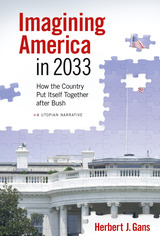 Imagining America in 2033: How the Country Put Itself Together after Bush
Herbert J. Gans
University of Michigan Press, 2008 In the spirit of great utopian writing that dares to hope for a better world, Imagining America in 2033 takes place in a fictional yet achievable future America—a time when progressive, liberal ideals inform politics and citizens alike. At the heart of Herbert J. Gans's utopian narrative is the vision of progress with fairness on which the best of American idealism has been built. Part utopia, part realism, Imagining America in 2033 is also a liberal's dream of life after Bush and a set of progressive yet practical guidelines for restoring sanity and intelligence to nearly every aspect of public and political life post-Bush. Herbert J. Gans, one of the most influential and prolific sociologists and social commentators of our time, achieves a realistic utopia set mostly in the second and third decades of the century. In Gans's imagined future, elected officials, policymakers, activists, and citizens have transformed America into a much more humane and effective democracy. The book features three Democratic presidents; the major new domestic, foreign, and social policies their administrations pursue; and the political battles they fight. Gans provides chapters on an exhaustive list of social, political, and economic policy issues: jobs; war; tax reform; global warming; economic, racial, gender, and religious equality; family policies; the creation of affordable housing and energy saving communities; education reform; and more. While hopeful and idealistic, many of Gans's proposals---such as the concept of the nurse-doctor, in which nurses increasingly take on tasks previously handled only by medical doctors within a framework of national health care---are ideas innovative enough that they should be taken seriously by actual policymakers. Imagining America in 2033 is lively and accessible, with an appeal for general readers, policy hounds, and the politically savvy alike.
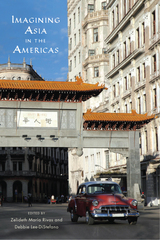 Imagining Asia in the Americas
Zelideth María Rivas and Debbie Lee-DiStefano
Rutgers University Press, 2016 For centuries, Asian immigrants have been making vital contributions to the cultures of North and South America. Yet in many of these countries, Asians are commonly viewed as undifferentiated racial “others,” lumped together as chinos regardless of whether they have Chinese ancestry. How might this struggle for recognition in their adopted homelands affect the ways that Asians in the Americas imagine community and cultural identity? The essays in Imagining Asia in the Americas investigate the myriad ways that Asians throughout the Americas use language, literature, religion, commerce, and other cultural practices to establish a sense of community, commemorate their countries of origin, and anticipate the possibilities presented by life in a new land. Focusing on a variety of locations across South America, Central America, the Caribbean, and the United States, the book’s contributors reveal the rich diversity of Asian American identities. Yet taken together, they provide an illuminating portrait of how immigrants negotiate between their native and adopted cultures. Drawing from a rich array of source materials, including texts in Spanish, Portuguese, Korean, Japanese, Chinese, and Gujarati that have never before been translated into English, this collection represents a groundbreaking work of scholarship. Through its unique comparative approach, Imagining Asia in the Americas opens up a conversation between various Asian communities within the Americas and beyond.
 Imagining Australia: Literature and Culture in the New New World
Judith Ryan
Harvard University Press Beginning in the last third of the twentieth century, Australian literary and cultural studies underwent a profound transformation to become an important testing ground of new ideas and theories. How do Australian cultural products project a sense of the nation today? How do Australian writers, artists, and film directors imagine the Australian heritage and configure its place in a larger world that extends beyond Australia's shores?
Ranging from the country's colonial beginnings to its more globally oriented present, the nineteen essays by distinguished scholars working on the cutting edge of the field present a multi-faceted view of the vast land down under. A central theme is the relation of cultural products to nature and history. Issues explored include problems of race and gender, colonialism and postcolonialism, individual and national identity, subjective experience and international connections. Among others, the essays treat major authors such as Peter Carey, David Malouf, and Judith Wright.
 Imagining Central America: Short Histories
Serena Cosgrove and Isabeau J. Belisle Dempsey
University of Minnesota Press, 2022 A concise review of the major events, social movements, politics, and economics of the seven countries that comprise Central America.
Given the strategic location of Central America, its importance to US foreign policy, and the migration from the region to other parts of the world, this succinct summary of the countries of Central America is an essential resource for those working in, studying, writing about, or traveling to the region. Promoting increased understanding of the region’s governance, economics, and structures of power, Imagining Central America highlights the many ways that Central American countries are connected to the United States through resettling, economic investment, culture flows, and foreign policy.
Each of the seven chapters focuses on a different country within Central America—Belize, Costa Rica, El Salvador, Guatemala, Honduras, Nicaragua, and Panama—and includes a map, regional introduction, timeline, and history of each country from the pre-Columbian era to the present day. Each chapter also provides a substantial recommended reading list of novels and academic sources for readers who want to learn more about the key events and themes within individual countries. A QR code within each chapter links to online resources that walk readers through each country in full color.
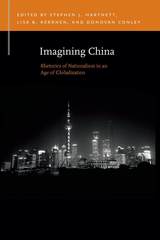 Imagining China: Rhetorics of Nationalism in an Age of Globalization
Stephen J. Hartnett
Michigan State University Press, 2017 Standing as the world’s two largest economies, marshaling the most imposing armies on earth, holding enormous stockpiles of nuclear weapons, consuming a majority share of the planet’s natural resources, and serving as the media generators and health care providers for billions of consumers around the globe, the United States and China are positioned to influence notions of democracy, nationalism, citizenship, human rights, environmental priorities, and public health for the foreseeable future. These broad issues are addressed as questions about communication—about how our two nations envision each other and how our interlinked imaginaries create both opportunities and obstacles for greater understanding and strengthened relations. Accordingly, this book provides in-depth communication-based analyses of how U.S. and Chinese officials, scholars, and activists configure each other, portray the relations between the two nations, and depict their shared and competing interests. As a first step toward building a new understanding between one another, Imagining China tackles the complicated question of how Americans, Chinese, and their respective allies imagine themselves enmeshed in nations, old rivalries, and emerging partnerships, while simultaneously meditating on the powers and limits of nationalism in our age of globalization.
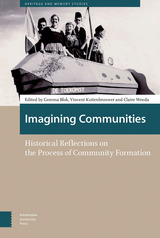 Imagining Communities: Historical Reflections on the Process of Community Formation
Edited by Gemma Blok, Vincent Kuitenbrouwer, and Claire Weeda
Amsterdam University Press, 2018 In his groundbreaking Imagined Communities, first published in 1983, Benedict Anderson argued that members of a community experience a Ÿdeep, horizontal camaraderie.Œ Despite being strangers, members feel connected in a web of imagined experiences.
Yet while Anderson’s insights have been hugely influential, they remain abstract: it is difficult to imagine imagined communities. How do they evolve and how is membership constructed cognitively, socially and culturally? How do individuals and communities contribute to group formation through the act of imagining? And what is the glue that holds communities together?
Imagining Communities examines actual processes of experiencing the imagined community, exploring its emotive force in a number of case studies. Communal bonding is analysed, offering concrete insights on where and by whom the nation (or social group) is imagined and the role of individuals therein. Offering eleven empirical case studies, ranging from the premodern to the modern age, this volume looks at and beyond the nation and includes regional as well as transnational communities as well.
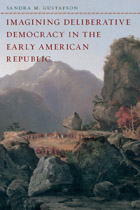 Imagining Deliberative Democracy in the Early American Republic
Sandra M. Gustafson
University of Chicago Press, 2011 Deliberation, in recent years, has emerged as a form of civic engagement worth reclaiming. In this persuasive book, Sandra M. Gustafson combines historical literary analysis and political theory in order to demonstrate that current democratic practices of deliberation are rooted in the civic rhetoric that flourished in the early American republic. Though the U.S. Constitution made deliberation central to republican self-governance, the ethical emphasis on group deliberation often conflicted with the rhetorical focus on persuasive speech. From Alexis de Tocqueville’s ideas about the deliberative basis of American democracy through the works of Walt Whitman, John Dewey, John F. Kennedy, and Martin Luther King Jr., Gustafson shows how writers and speakers have made the aesthetic and political possibilities of deliberation central to their autobiographies, manifestos, novels, and orations. Examining seven key writers from the early American republic—including James Fenimore Cooper, David Crockett, and Daniel Webster—whose works of deliberative imagination explored the intersections of style and democratic substance, Gustafson offers a mode of historical and textual analysis that displays the wide range of resources imaginative language can contribute to political life.
Imagining Ethiopia: Struggles for History and Identity in the Horn of Africa
John Sorenson
Rutgers University Press, 1993 In Imagining Ethiopia, Sorenson examines Western mass media images of Ethiopia, placing them in the context of a larger discourse on the Third World. Sorenson shows how our image of Ethiopia has been developed by reporters and photographers who blamed the famine on African backwardness and ignored its historical and political causes, which include a colonial history, militarization, and the circumstances of Africa's integration into the world market.
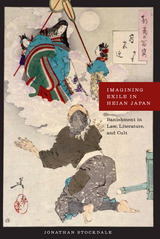 Imagining Exile in Heian Japan: Banishment in Law, Literature, and Cult
Jonathan Stockdale
University of Hawaii Press, 2015 For over three hundred years during the Heian period (794–1185), execution was customarily abolished in favor of banishment. During the same period, exile emerged widely as a concern within literature and legend, in poetry and diaries, and in the cultic imagination, as expressed in oracles and revelations. While exile was thus one sanction available to the state, it was also something more: a powerful trope through which members of court society imagined the banishment of gods and heavenly beings, of legendary and literary characters, and of historical figures, some transformed into spirits. This compelling and well-researched volume is the first in English to explore the rich resonance of exile in the cultural life of the Japanese court. Rejecting the notion that such narratives merely reflect a timeless literary archetype, Jonathan Stockdale shows instead that in every case exile emerged from particular historical circumstances—moments in which elites in the capital sought to reveal and to re-imagine their world and the circulation of power within it. By exploring the relationship of banishment to the structures of inclusion and exclusion upon which Heian court society rested, Stockdale moves beyond the historiographical discussion of “center and margin” to offer instead a theory of exile itself. Stockdale’s arguments are situated in astute and careful readings of Heian sources. His analysis of a literary narrative, the Tale of the Bamboo Cutter, for example, shows how Kaguyahime’s exile from the “Capital of the Moon” to earth implicitly portrays the world of the Heian court as a polluted periphery. His exploration of one of the most well-known historical instances of banishment, that of Sugawara Michizane, illustrates how the political sanction of exile could be met with a religious rejoinder through which an exiled noble is reinstated in divine form, first as a vengeful spirit and then as a deity worshipped at the highest levels of court society. Imagining Exile in Heian Japan is a model of interdisciplinary scholarship that will appeal to anyone interested in the interwoven connections of early and classical Japan.
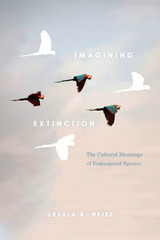 Imagining Extinction: The Cultural Meanings of Endangered Species
Ursula K. Heise
University of Chicago Press, 2016 We are currently facing the sixth mass extinction of species in the history of life on Earth, biologists claim—the first one caused by humans. Activists, filmmakers, writers, and artists are seeking to bring the crisis to the public’s attention through stories and images that use the strategies of elegy, tragedy, epic, and even comedy. Imagining Extinction is the first book to examine the cultural frameworks shaping these narratives and images.
Ursula K. Heise argues that understanding these stories and symbols is indispensable for any effective advocacy on behalf of endangered species. More than that, she shows how biodiversity conservation, even and especially in its scientific and legal dimensions, is shaped by cultural assumptions about what is valuable in nature and what is not. These assumptions are hardwired into even seemingly neutral tools such as biodiversity databases and laws for the protection of endangered species. Heise shows that the conflicts and convergences of biodiversity conservation with animal welfare advocacy, environmental justice, and discussions about the Anthropocene open up a new vision of multispecies justice. Ultimately, Imagining Extinction demonstrates that biodiversity, endangered species, and extinction are not only scientific questions but issues of histories, cultures, and values.
Imagining Global Amsterdam: History, Culture, and Geography in a World City
Edited by Marco de Waard
Amsterdam University Press, 2012 Imagining Global Amsterdambrings together new essays on the image of Amsterdam as articulated in film, literature, art, and urban discourse, considered within the context of globalization and its impact on urban culture. Subjects include: Amsterdam’s place in global cultural memory; expressions of global consciousness in Amsterdam in the ‘Golden Age’; articulations of Amsterdam as a tolerant, multicultural, and permissive ‘global village’; and globalization’s impact ‘on the ground’ through city branding, the cultural heritage industry, and cultural production in the city.
Written by an interdisciplinary team of scholars, and united by a broad humanities approach, this collection forms a multifaceted inquiry into the dynamic relationship between Amsterdam, globalization, and the urban imaginary.
 Imagining Grace: Liberating Theologies in the Slave Narrative Tradition
Kimberly Rae Connor
University of Illinois Press, 2000 In this subtle and illuminating study, Kimberly Rae Connor surveys examples of contemporary literature, drama, art, and music that extend the literary tradition of African-American slave narratives. Revealing the powerful creative links between this tradition and liberation theology's search for grace, she shows how these artworks profess a liberating theology of racial empathy and reconciliation, even if not in traditionally Christian or sacred language.
From Frederick Douglass's autobiographical writings through Richard Wright's imaginative reconstruction of slavery to Ernest Gaines's Autobiography of Miss Jane Pittman and the candescent novels of Toni Morrison, slave narratives exhort the reader to step into the experience of the dispossessed. Connor underscores the broad influence of the slave narrative by considering nonliterary as well as literary works, including Glenn Ligon's introspective art, Anna Deavere Smith's one-woman performance pieces, and Charlie Haden's politically engaged Liberation Music Orchestra. Through these works, readers, listeners, and viewers imagine grace on two levels: as the liberation of the enslaved from oppression and as their own liberation from prejudice and "willed innocence."
Calling to task a complacent white society that turns a blind eye to deep-seated and continuing racial inequalities, Imagining Grace shows how these creative endeavors embody the search for grace, seeking to expose racism in all its guises and lay claim to political, intellectual, and spiritual freedom.
 Imagining Health: Medicine, Social Protest, and Modern American Literature
Ira Halpern
University of Massachusetts Press, 2026 A surprising look at how American writers envision a more equitable healthcare system
In the United States, a deep suspicion of professional medical expertise is becoming increasingly prominent. Meanwhile, many arguments for health justice take a highly critical view of medical authority, even rejecting it entirely. In the early to mid-twentieth century, alternatively, as medicine rapidly professionalized, Americans came to hold the medical establishment in a particularly high regard, while many saw how it could play a crucial role in progressive politics. In this period, technologies developed, specializations grew, and medical education became standardized. With this process came inequities, as marginalized populations struggled to access the highest levels of care. Literary writers confronting social ills through their work included critiques of this new system in their writing, Ira Halpern argues. Without abandoning professional medicine, they called for alternative systems of care that could better serve diverse populations.
Halpern examines the work of several writers—including Robert Herrick, Wallace Thurman, Frank Slaughter, Charles Chesnutt, Walter White, Ralph Ellison, Charlotte Perkins Gilman, Upton Sinclair, Stephen Crane, and Edith Wharton—to demonstrate how American writing from this period embedded a critical look at healthcare within other elements of progressive politics, from racial protest and women’s rights to disability justice and counter-capitalist viewpoints. Placing this writing into historical context, in terms of medical and scientific developments as well as traditions of social protest, Halpern reveals the efforts of these writers to envision better alternative trajectories for a quickly evolving medical establishment that left too many Americans without reliable care.
 Imagining Health: Medicine, Social Protest, and Modern American Literature
Ira Halpern
University of Massachusetts Press, 2026 A surprising look at how American writers envision a more equitable healthcare system
In the United States, a deep suspicion of professional medical expertise is becoming increasingly prominent. Meanwhile, many arguments for health justice take a highly critical view of medical authority, even rejecting it entirely. In the early to mid-twentieth century, alternatively, as medicine rapidly professionalized, Americans came to hold the medical establishment in a particularly high regard, while many saw how it could play a crucial role in progressive politics. In this period, technologies developed, specializations grew, and medical education became standardized. With this process came inequities, as marginalized populations struggled to access the highest levels of care. Literary writers confronting social ills through their work included critiques of this new system in their writing, Ira Halpern argues. Without abandoning professional medicine, they called for alternative systems of care that could better serve diverse populations.
Halpern examines the work of several writers—including Robert Herrick, Wallace Thurman, Frank Slaughter, Charles Chesnutt, Walter White, Ralph Ellison, Charlotte Perkins Gilman, Upton Sinclair, Stephen Crane, and Edith Wharton—to demonstrate how American writing from this period embedded a critical look at healthcare within other elements of progressive politics, from racial protest and women’s rights to disability justice and counter-capitalist viewpoints. Placing this writing into historical context, in terms of medical and scientific developments as well as traditions of social protest, Halpern reveals the efforts of these writers to envision better alternative trajectories for a quickly evolving medical establishment that left too many Americans without reliable care.
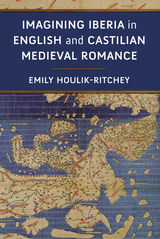 Imagining Iberia in English and Castilian Medieval Romance
Emily Houlik-Ritchey
University of Michigan Press, 2023 Imagining Iberia in English and Castilian Medieval Romance offers a broad disciplinary, linguistic, and national focus by analyzing the literary depiction of Iberia in two European vernaculars that have rarely been studied together. Emily Houlik-Ritchey employs an innovative comparative methodology that integrates the understudied Castilian literary tradition with English literature. Intentionally departing from the standard “influence and transmission” approach, Imagining Iberia challenges that standard discourse with modes drawn from Neighbor Theory to reveal and navigate the relationships among three selected medieval romance traditions. This welcome volume uncovers an overemphasis in prior scholarship on the relevance of “crusading” agendas in medieval romance, and highlights the shared investments of Christians and Muslims in Iberia’s political, creedal, cultural, and mercantile networks in the Mediterranean world.
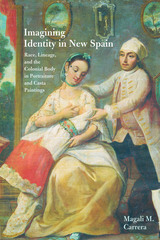 Imagining Identity in New Spain: Race, Lineage, and the Colonial Body in Portraiture and Casta Paintings
By Magali M. Carrera
University of Texas Press, 2003 Using an interdisciplinary approach that also considers legal, literary, and religious documents of the period, Magali Carrera focuses on eighteenth-century portraiture and casta paintings to understand how the people and spaces of New Spain were conceptualized and visualized.
Winner, Book Award, Association of Latin American Art, 2004 Reacting to the rising numbers of mixed-blood (Spanish-Indian-Black African) people in its New Spain colony, the eighteenth-century Bourbon government of Spain attempted to categorize and control its colonial subjects through increasing social regulation of their bodies and the spaces they inhabited. The discourse of calidad (status) and raza (lineage) on which the regulations were based also found expression in the visual culture of New Spain, particularly in the unique genre of casta paintings, which purported to portray discrete categories of mixed-blood plebeians. Using an interdisciplinary approach that also considers legal, literary, and religious documents of the period, Magali Carrera focuses on eighteenth-century portraiture and casta paintings to understand how the people and spaces of New Spain were conceptualized and visualized. She explains how these visual practices emphasized a seeming realism that constructed colonial bodies—elite and non-elite—as knowable and visible. At the same time, however, she argues that the chaotic specificity of the lives and lived conditions in eighteenth-century New Spain belied the illusion of social orderliness and totality narrated in its visual art. Ultimately, she concludes, the inherent ambiguity of the colonial body and its spaces brought chaos to all dreams of order.
 Imagining Illness: Public Health and Visual Culture
David Serlin
University of Minnesota Press, 2010 From seventeenth-century broadsides about the handling of dead bodies, printed during London's plague years, to YouTube videos about preventing the transmission of STDs, public health advocacy and education has always had a powerful visual component. Imagining Illness explores the diverse visual culture of public health, broadly defined, from the nineteenth century to the present.
Contributors to this volume examine historical and contemporary visual practices-Chinese health fairs, documentary films produced by the World Health Organization, illness maps, fashions for nurses, and live surgery on the Internet-in order to delve into the political and epidemiological contexts underlying their creation and dissemination.
Contributors: Liping Bu, Alma College; Lisa Cartwright, U of California, San Diego; Roger Cooter, U College London; William H. Helfand; Lenore Manderson, Monash U, Australia; Emily Martin, New York U; Gregg Mitman, U of Wisconsin, Madison; Mark Monmonier, Syracuse U; Kirsten Ostherr, Rice U; Katherine Ott, National Museum of American History, Smithsonian; Shawn Michelle Smith, Art Institute of Chicago; Claudia Stein, Warwick U.
Imagining Indonesia: Cultural Politics and Political Culture
Jim Schiller
Ohio University Press, 1997 Increased interest in Indonesian culture and politics is reflected in this work's effort to advance and reject various notions of what it means to be Indonesian. It also addresses perceptions of how Indonesia's citizens and state officials should interact. Because, in recent times, the Indonesian state has been so strong, much of the book is about state-sanctioned and state-supported notions of Indonesian identity and culture and efforts to come to terms with—or sometimes to challenge these official or dominant notions.
The contributions presented here represent a wide range of disciplines, points of view, and ideological orientations. Taken together they convey the notion that much might be gained if the idea were abandoned that a single understanding of what constitutes Indonesian culture is possible or desirable.
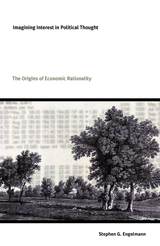 Imagining Interest in Political Thought: Origins of Economic Rationality
Stephen G. Engelmann
Duke University Press, 2003 Imagining Interest in Political Thought argues that monistic interest—or the shaping and coordination of different pursuits through imagined economies of self and public interest—constitutes the end and means of contemporary liberal government. The paradigmatic theorist of monistic interest is the English political philosopher Jeremy Bentham (1748–1832), whose concept of utilitarianism calls for maximization of pleasure by both individuals and the state. Stephen G. Engelmann contends that commentators have too quickly dismissed Bentham’s philosophy as a crude materialism with antiliberal tendencies. He places Benthamite utilitarianism at the center of his account and, in so doing, reclaims Bentham for liberal political theory. Tracing the development of monistic interest from its origins in Reformation political theory and theology through late-twentieth-century neoliberalism, Engelmann reconceptualizes the history of liberalism as consisting of phases in the history of monistic interest or economic government. He describes how monistic interest, as formulated by Bentham, is made up of the individual’s imagined expectations, which are constructed by the very regime that maximizes them. He asserts that this construction of interests is not the work of a self-serving manipulative state. Rather, the state, which is itself subject to strict economic regulation, is only one cluster of myriad "public" and "private" agencies that produce and coordinate expectations. In place of a liberal vision in which government appears only as a protector of the free pursuit of interest, Engelmann posits that the free pursuit of interest is itself a mode of government, one that deploys individual imagination and choice as its agents.
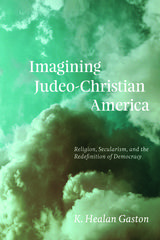 Imagining Judeo-Christian America: Religion, Secularism, and the Redefinition of Democracy
K. Healan Gaston
University of Chicago Press, 2019 “Judeo-Christian” is a remarkably easy term to look right through. Judaism and Christianity obviously share tenets, texts, and beliefs that have strongly influenced American democracy. In this ambitious book, however, K. Healan Gaston challenges the myth of a monolithic Judeo-Christian America. She demonstrates that the idea is not only a recent and deliberate construct, but also a potentially dangerous one. From the time of its widespread adoption in the 1930s, the ostensible inclusiveness of Judeo-Christian terminology concealed efforts to promote particular conceptions of religion, secularism, and politics. Gaston also shows that this new language, originally rooted in arguments over the nature of democracy that intensified in the early Cold War years, later became a marker in the culture wars that continue today. She argues that the debate on what constituted Judeo-Christian—and American—identity has shaped the country’s religious and political culture much more extensively than previously recognized.
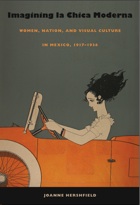 Imagining la Chica Moderna: Women, Nation, and Visual Culture in Mexico, 1917–1936
Joanne Hershfield
Duke University Press, 2008 In the years following the Mexican Revolution, visual images of la chica moderna, the modern woman, au courant in appearance and attitude, popped up in mass media across the country. Some of the images were addressed directly to women through advertisements, as illustrations accompanying articles in women’s magazines, and on the “women’s pages” in daily newspapers. Others illustrated domestic and international news stories, promoted tourism, or publicized the latest Mexican and Hollywood films. In Imagining la Chica Moderna, Joanne Hershfield examines these images, exploring how the modern woman was envisioned in Mexican popular culture and how she figured into postrevolutionary contestations over Mexican national identity. Through her detailed interpretations of visual representations of la chica moderna, Hershfield demonstrates how the images embodied popular ideas and anxieties about sexuality, work, motherhood, and feminine beauty, as well as class and ethnicity. Her analysis takes into account the influence of mexicanidad, the vision of Mexican national identity promoted by successive postrevolutionary administrations, and the fashions that arrived in Mexico from abroad, particularly from Paris, New York, and Hollywood. She considers how ideals of the modern housewife were promoted to Mexican women through visual culture; how working women were represented in illustrated periodicals and in the Mexican cinema; and how images of traditional “types” of Mexican women, such as la china poblana (the rural woman), came to define a “domestic exotic” form of modern femininity. Scrutinizing photographs of Mexican women that accompanied articles in the Mexican press during the 1920s and 1930s, Hershfield reflects on the ways that the real and the imagined came together in the production of la chica moderna.
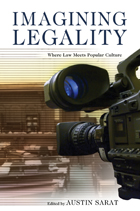 Imagining Legality: Where Law Meets Popular Culture
Austin Sarat
University of Alabama Press, 2011 Imagining Legality: Where Law Meets Popular Culture is collection of essays on the relationship between law and popular culture that posits, in addition to the concepts of law in the books and law in action, a third concept of law in the image—that is, of law as it is perceived by the public through the lens of public media. Imagining Legality argues that images of law suggested by television and film are as numerous as they are various, and that they give rise to a potent and pervasive imaginative life of the law. The media’s projections of the legal system remind us not only of the way law lives in our imagination but also of the contingencies of our own legal and social arrangements. Contributors to Imagining Legality are less interested in the accuracy of the portrayals of law in film and television than in exploring the conditions of law’s representation, circulation, and consumption in those media. In the same way that legal scholars have taken on the disciplinary perspectives of history, economics, sociology, anthropology, and psychology in relation to the law, these writers bring historical, sociological, and cultural analysis, as well as legal theory, to aid in the understanding of law and popular culture.
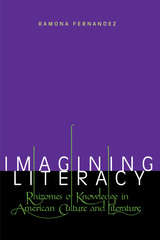 Imagining Literacy: Rhizomes of Knowledge in American Culture and Literature
By Ramona Fernandez
University of Texas Press, 2001 Defining the "common knowledge" a "literate" person should possess has provoked intense debate ever since the publication of E. D. Hirsch's controversial book Cultural Literacy: What Every American Needs to Know. Yet the basic concept of "common knowledge," Ramona Fernandez argues, is a Eurocentric model ill-suited to a society composed of many distinct cultures and many local knowledges. In this book, Fernandez decodes the ideological assumptions that underlie prevailing models of cultural literacy as she offers new ways of imagining and modeling mixed cultural and non-print literacies. In particular, she challenges the biases inherent in the "encyclopedias" of knowledge promulgated by E. D. Hirsch and others, by Disney World's EPCOT Center, and by the Smithsonian Institution. In contrast to these, she places the writings of Zora Neale Hurston, Maxine Hong Kingston, Gloria Anzaldúa, and Leslie Marmon Silko, whose works model a cultural literacy that weaves connections across many local knowledges and many ways of knowing.
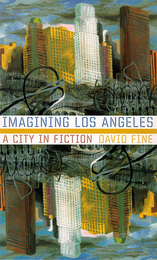 Imagining Los Angeles: A City In Fiction
David Fine
University of Nevada Press, 2004 The literary image of Los Angeles has evolved since the 1880s from promotional literature that hyped the region as a New Eden to contemporary visions of the city as a perplexing, sometimes corrupt, even apocalyptic place that reflects all that is wrong with America. In Imagining Los Angeles, the first literary history of the city in more than fifty years, critic David Fine traces the history and mood of the place through the work of writers as diverse as Helen Hunt Jackson, Mary Austin, Norman Mailer, Raymond Chandler, Joan Didion, Carolyn See, and many others. His lively and engaging text focuses on the way these writers saw Los Angeles and used the image of the city as an element in their work, and on how that image has changed as the city itself became ever larger, more complex, and more socially and ethnically diverse. This is essential reading for anyone interested in the literature and changing image of Southern California.
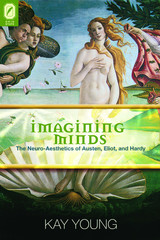 Imagining Minds: The Neuro-Aesthetics of Austen, Eliot, and Hardy
Kay Young
Ohio State University Press, 2010 Jane Austen, George Eliot, and Thomas Hardy—three great masters of the English novel—are three remarkable imagining minds. As readers of their novels, we feel ourselves to be in contact with their authorial minds and conjure the minds they create spread across the pages of their narrative worlds. In the way that we believe in and hold in mind the idea that other human beings have minds of their own do we as readers of the novel believe we are in the presence of these other minds. But how? Imagining Minds explores how the novels of Austen, Eliot, and Hardy create the felt-quality of their authoring minds and of the minds they author by bringing their writing in relation to cognitive neuroscience accounts of the mind-brain, especially of William James and Antonio Damasio. It is in that relational space between the novels and theories of mind-brain that Kay Young works through her fundamental claim: the novel writes about the nature of mind, narrates it at work, and stimulates us to know deepened experiences of consciousness in its touching of our reading minds. While, in addition to James and Damasio, Young draws on a range of theories of mind-brain generated by current research in philosophy, neuroscience, cognitive science, psychology, psychiatry, and psychoanalysis to help her understand the novel’s imagining of mind, her claim is that those disciplines cannot themselves perform the more fully integrated because embodied and emotionally stimulating mind work of thenovel—mind work that prompts us as their readers to better know our own minds.
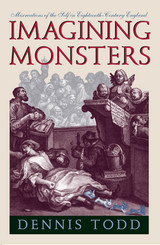 Imagining Monsters: Miscreations of the Self in Eighteenth-Century England
Dennis Todd
University of Chicago Press, 1995 In 1726, an illiterate woman from Surrey named Mary Toft announced that she had given birth to seventeen rabbits. Deceiving respected physicians and citizens alike, she created a hoax that held England spellbound for months. In Imagining Monsters, Dennis Todd tells the story of this bizarre incident and shows how it illuminates eighteenth-century beliefs about the power of imagination and the problems of personal identity.
Mary Toft's outrageous claim was accepted because of a common belief that the imagination of a pregnant woman could deform her fetus, creating a monster within her. Drawing on largely unexamined material from medicine, embryology, philosophy, and popular "monster" exhibitions, Todd shows that such ideas about monstrous births expressed a fear central to scientific, literary, and philosophical thinking: that the imagination could transgress the barrier between mind and body.
In his analysis of the Toft case, Todd exposes deep anxieties about the threat this transgressive imagination posed to the idea of the self as stable, coherent, and autonomous. Major works of Pope and Swift reveal that they, too, were concerned with these issues, and Imagining Monsters provides detailed discussions of Gulliver's Travels and The Dunciad illustrating how these writers used images of monstrosity to explore the problematic nature of human identity. It also includes a provocative analysis of Pope's later work that takes into account his physical deformity and his need to defend himself in a society that linked a deformed body with a deformed character.
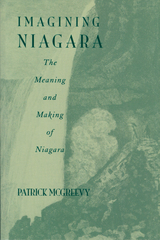 Imagining Niagara: The Meaning and Making of Niagara Falls
Patrick McGreevy
University of Massachusetts Press, 2009 Niagara Falls was a lightning rod for nineteenth-century enthusiasms. Although travelers came to the falls to experience a place they considered outside the world of their ordinary lives, they brought with them their contemporary concerns. Many tourists were obsessed with the mysteries of death, others with scientific or religious speculation. The way they imagined Niagara Falls found expression in a torrent of writings and images that took a variety of forms.
Patrick McGreevy begins with the question, What can these visions of Niagara tell us about the place itself? The landscape surrounding the falls contains not only parks and religious shrines but also circuses, horror museums, and factories. People travel to Niagara not only to experience nature but also to celebrate marriages or commit suicide.
One way to make sense of these bizarre "human accumulations," as H. G. Wells called them, is to take seriously the Niagaras people have imagined. This book focuses on four interlocking themes that recur time and again in descriptions of the falls: Niagara as a thing imagined from afar, as a metaphor for death, as an embodiment of nature, and as a focus of future events. Using the skills of a cultural geographer, McGreevy discovers some surprising connections between the Niagara people have imagined and the one they made, between its natural grandeur and its industrial exploitation, between Frederick Law Olmsted's Reservation and the Love Canal.
Imagining Otherwise: Metapsychology and the Analytic A Posteriori
Andrew Cutrofello
Northwestern University Press, 1997 Andrew Cutrofello's book performs a psychoanalytic inversion of transcendental philosophy, taking Kant's synthetic a prior judgments and reading them in terms of a foreclosed Kantian category—that of the analytic a posteriori. Working primarily out of Freudian and Lacanian problematics, Cutrofello not only subjects Kantian thought to psychoanalytic questioning, but also develops a systematic critique of metapsychology itself, disclosing and assessing its own paralogisms, antinomies, ideal, and ethics. This is a provocative reflection on the tensions between the Enlightenment project of critique and psychoanalytic theory.
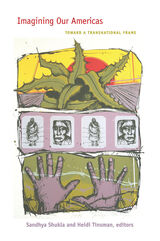 Imagining Our Americas: Toward a Transnational Frame
Sandhya Shukla and Heidi Tinsman, eds.
Duke University Press, 2007 This rich interdisciplinary collection of essays advocates and models a hemispheric approach to the study of the Americas. Taken together, the essays examine North and South America, the Caribbean, and the Pacific as a broad region transcending both national boundaries and the dichotomy between North and South. In the volume’s substantial introduction, the editors, an anthropologist and a historian, explain the need to move beyond the paradigm of U.S. American Studies and Latin American Studies as two distinct fields. They point out the Cold War origins of area studies, and they note how many of the Americas’ most significant social formations have spanned borders if not continents: diverse and complex indigenous societies, European conquest and colonization, African slavery, Enlightenment-based independence movements, mass immigrations, and neoliberal economies. Scholars of literature, ethnic studies, and regional studies as well as of anthropology and history, the contributors focus on the Americas as a broadly conceived geographic, political, and cultural formation. Among the essays are explorations of the varied histories of African Americans’ presence in Mexican and Chicano communities, the different racial and class meanings that the Colombian musical genre cumbia assumes as it is absorbed across national borders, and the contrasting visions of anticolonial struggle embodied in the writings of two literary giants and national heroes: José Martí of Cuba and José Rizal of the Philippines. One contributor shows how a pidgin-language mixture of Japanese, Hawaiian, and English allowed second-generation Japanese immigrants to critique Hawaii’s plantation labor system as well as Japanese hierarchies of gender, generation, and race. Another examines the troubled history of U.S. gay and lesbian solidarity with the Cuban Revolution. Building on and moving beyond previous scholarship, this collection illuminates the productive intellectual and political lines of inquiry opened by a focus on the Americas. Contributors. Rachel Adams, Victor Bascara, John D. Blanco, Alyosha Goldstein, Héctor Fernández L’Hoeste, Ian Lekus, Caroline F. Levander, Susan Y. Najita, Rebecca Schreiber, Sandhya Shukla, Harilaos Stecopoulos, Michelle Stephens, Heidi Tinsman, Nick Turse, Rob Wilson
 Imagining Persecution: Why American Christians Believe There Is a Global War against Their Faith
Jason Bruner
Rutgers University Press, 2021 Many American Christians have come to understand their relationship to other Christian denominations and traditions through the lens of religious persecution. This book provides a historical account of these developments, showing the global, theological, and political changes that made it possible for contemporary Christians to claim that there is a global war on Christians. This book, however, does not advocate on behalf of particular repressed Christian communities, nor does it argue for the genuineness (or lack thereof) of certain Christians’ claims of persecution. Instead, this book is the first to examine the idea that there is a “global war on Christians” and its analytical implications. It does so by giving a concise history of the categories (like “martyrs”), evidence (statistics and metrics), and theologies that have come together to produce a global Christian imagination premised upon the notion of shared suffering for one’s faith. The purpose in doing so is not to deny certain instances of suffering or death; rather, it is to reflect upon the consequences for thinking about religious violence and Christianity worldwide using terms such as a “global war on Christians.”
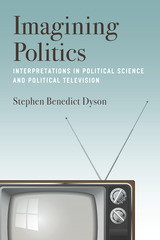 Imagining Politics: Interpretations in Political Science and Political Television
Stephen Benedict Dyson
University of Michigan Press, 2019 Imagining Politics critically examines two interpretations of government. The first comes from pop culture fictions about politics, the second from academic political science. Stephen Benedict Dyson argues that televised political fictions and political science theories are attempts at meaning-making, reflecting and shaping how a society thinks about its politics.
By taking fiction seriously, and by arguing that political science theory is homologous to fiction, the book offers a fresh perspective on both, using fictions such as The West Wing, House of Cards, Borgen, Black Mirror, and Scandal to challenge the assumptions that construct the discipline of political science itself.
Imagining Politics is also about a political moment in the West. Two great political shocks—Brexit and the election of Donald Trump—are set in a new context here. Dyson traces how Brexit and Trump campaigned against our image of politics as usual, and won.
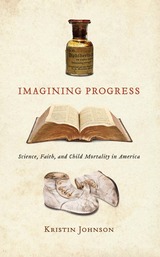 Imagining Progress: Science, Faith, and Child Mortality in America
Kristin Johnson
University of Alabama Press, 2024 Explores the intellectual history of Americans’ divergent assumptions about God, nature, and science
Offering fascinating examples from the works of diverse writers and thinkers such as Benjamin Franklin, Frederick Douglass, Mark Twain, W. E. B. Du Bois, Elizabeth Cady Stanton, and Harriet Shelton Dover, Kristin Johnson traces the history of Americans’ complicated faith in science and the various triumphs and tragedies that faith has inspired. Imagining Progress reveals many of the complex factors involved in the polarized state of contemporary American attitudes toward science, scientists, public health, medicine, and science policy.
Humankind has always wrestled with the existence of suffering, how to respond to suffering, whom to care for, and in what ways. For two centuries, many American ministers, physicians, and scientists believed that an omnipotent and omniscient God created the world such that people might relieve suffering through ingenuity and learning. Others responded to the new worldview introduced by the scientific revolution as a threat to the divine order. In Imagining Progress, Johnson traces the history of Americans’ evolving relationship with science and religion at “one of its most dramatic places”—the bedsides of dying children. It’s here, in the crucible of parental despair, that she illuminates diverging assumptions about God, nature, and history.
From Cotton Mather’s campaign for smallpox inoculation to battles over teaching evolution in the 1920s, Johnson adroitly weaves an interdisciplinary history of medicine, science, theology, and activism. She follows a wide cast of characters from across theological, scientific, and political spectrums. What emerges is a kaleidoscopic portrait of diverse, often contradictory hopes and anxieties inspired by new theories of nature and human existence. Johnson also discerns a problematic pattern of invoking science both to ameliorate the suffering of some children while ignoring the suffering of others.
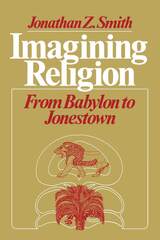 Imagining Religion: From Babylon to Jonestown
Jonathan Z. Smith
University of Chicago Press, 1982 With this influential book of essays, Jonathan Z. Smith has pointed the academic study of religion in a new theoretical direction, one neither theological nor willfully ideological.
Making use of examples as apparently diverse and exotic as the Maori cults in nineteenth-century New Zealand and the events of Jonestown, Smith shows that religion must be construed as conventional, anthropological, historical, and as an exercise of imagination. In his analyses, religion emerges as the product of historically and geographically situated human ingenuity, cognition, and curiosity—simply put, as the result of human labor, one of the decisive but wholly ordinary ways human beings create the worlds in which they live and make sense of them.
"These seven essays . . . display the critical intelligence, creativity, and sheer common sense that make Smith one of the most methodologically sophisticated and suggestive historians of religion writing today. . . . Smith scrutinizes the fundamental problems of taxonomy and comparison in religious studies, suggestively redescribes such basic categories as canon and ritual, and shows how frequently studied myths may more likely reflect situational incongruities than vaunted mimetic congruities. His final essay, on Jonestown, demonstrates the interpretive power of the historian of religion to render intelligible that in our own day which seems most bizarre."—Richard S. Sarason, Religious Studies Review
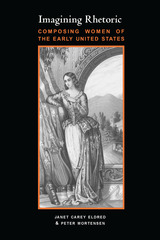 Imagining Rhetoric: Composing Women of the Early United States
Janet Carey Eldred
University of Pittsburgh Press, 2002
Imagining Rhetoric examines how women’s writing developed in the decades between the American Revolution and the Civil War, and how women imagined using their education to further the civic aims of an idealistic new nation.
In the late eighteenth century, proponents of female education in the United States appropriated the language of the Revolution to advance the cause of women’s literacy. Schooling for women—along with abolition, suffrage, and temperance—became one of the four primary arenas of nineteenth-century women’s activism. Following the Revolution, textbooks and fictions about schooling materialized that revealed ideal curricula for women covering subjects from botany and chemistry to rhetoric and composition. A few short decades later, such curricula and hopes for female civic rhetoric changed under the pressure of threatened disunion.
Using a variety of texts, including novels, textbooks, letters, diaries, and memoirs, Janet Carey Eldred and Peter Mortensen chart the shifting ideas about how women should learn and use writing, from the early days of the republic through the antebellum years. They also reveal how these models shaped women’s awareness of female civic rhetoric—both its possibilities and limitations.
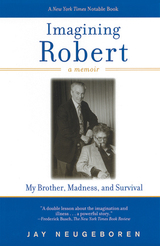 Imagining Robert: My Brother, Madness, and Survival, A Memoir
Neugeboren, Jay
Rutgers University Press, 2003 Jay Neugeboren and his brother, Robert, grew up in Brooklyn in the years following World War II. Both brothers—smart, talented, and popular—seemed well on the way to successful lives when, for reasons that remain ultimately mysterious to this day, Robert had a mental breakdown at age nineteen. For the past forty years Jay has been not only his brother’s friend and confidant, but his sole advocate, as Robert continues to suffer from the ravages of the illness that has kept him institutionalized for most of his adult life. Imagining Robert tells the story of these two brothers and how their love for one another has enabled both to survive, and to thrive in miraculous, surprising ways. It is the most honest book yet on what it is like for the millions of families that must cope, day-by-day and year-by-year over the course of a lifetime, with a condition for which, in most cases, there is no cure. By never giving up hope and by valuing his brother’s uniqueness and humanity, Jay Neugeboren reveals how even the grimmest of lives can be sustained by the power of love. A film based on Imagining Robert aired on PBS nationally in 2003. With a new afterword that brings readers up to date on Robert’s life, Rutgers University Press is pleased make this highly praised book with its inspiring story available once more to the public.
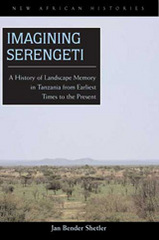 Imagining Serengeti: A History of Landscape Memory in Tanzania from Earliest Times to the Present
Jan Bender Shetler
Ohio University Press, 2007 Many students come to African history with a host of stereotypes that are not always easy to dislodge. One of the most common is that of Africa as safari grounds—as the land of expansive, unpopulated game reserves untouched by civilization and preserved in their original pristine state by the tireless efforts of contemporary conservationists. With prose that is elegant in its simplicity and analysis that is forceful and compelling, Jan Bender Shetler brings the landscape memory of the Serengeti to life. She demonstrates how the social identities of western Serengeti peoples are embedded in specific spaces and in their collective memories of those spaces. Using a new methodology to analyze precolonial oral traditions, Shetler identifies core spatial images and reevaluates them in their historical context through the use of archaeological, linguistic, ethnographic, ecological, and archival evidence. Imagining Serengeti is a lively environmental history that will ensure that we never look at images of the African landscape in quite the same way.
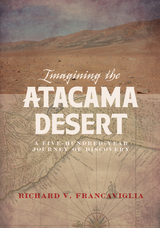 Imagining the Atacama Desert: A Five-Hundred-Year Journey of Discovery
Richard V. Francaviglia
University of Utah Press, 2018 Widely regarded as the driest place on earth, the seemingly desolate Atacama Desert of Chile is a place steeped in intrigue and haunted by collective memories. This book, based on archival research and the author's personal field experiences, brings together the works of geographers, historians, anthropologists, botanists, geologists, astronomers, novelists, and others to offer a nuanced understanding of this complex desert landscape.
Beginning with the indigenous Atacameño peoples at the southern edge of the Incan empire, the volume moves through five hundred years of history, sharing accounts written by Spanish, French, German, Dutch, British, American, and other travelers—pirates, scientists, explorers, and entrepreneurs among them. The Atacama’s austere landscape hides many secrets, including vast mineral wealth, the world's oldest mummies, and the more recent remains of dissidents murdered by the regime of former Chilean dictator Augusto Pinochet in the early 1970s. Today numerous observatories operate under the Atacama’s clear night skies, astronauts train on the rugged desert floor, and tourists flock there for inspiration.
In addition to a rich set of narratives, the book features 115 images—historical maps, photographs, and natural history illustrations, most in full color—to tell a more complete and compelling story. Imagining the Atacama Desert shows how what was once a wilderness at the edges of empire became one of South America's most iconic regions, one that continues to lure those seeking adventure and the unknown.
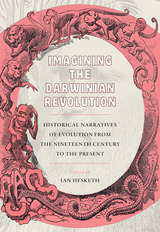 Imagining the Darwinian Revolution: Historical Narratives of Evolution from the Nineteenth Century to the Present
Ian Hesketh
University of Pittsburgh Press, 2022 This volume considers the relationship between the development of evolution and its historical representations by focusing on the so-called Darwinian Revolution. The very idea of the Darwinian Revolution is a historical construct devised to help explain the changing scientific and cultural landscape that was ushered in by Charles Darwin’s singular contribution to natural science. And yet, since at least the 1980s, science historians have moved away from traditional “great man” narratives to focus on the collective role that previously neglected figures have played in formative debates of evolutionary theory. Darwin, they argue, was not the driving force behind the popularization of evolution in the nineteenth century. This volume moves the conversation forward by bringing Darwin back into the frame, recognizing that while he was not the only important evolutionist, his name and image came to signify evolution itself, both in the popular imagination as well as in the work and writings of other evolutionists. Together, contributors explore how the history of evolution has been interpreted, deployed, and exploited to fashion the science behind our changing understandings of evolution from the nineteenth century to the present.
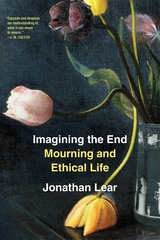 Imagining the End: Mourning and Ethical Life
Jonathan Lear
Harvard University Press, 2022 A Washington Post Notable Work of Nonfiction
A Chronicle of Higher Education Best Scholarly Book
“A deeply insightful and thought-enriching work by one of the most original philosophers writing today. Imagining the End is acutely aware of the danger we stand in of finding ourselves on an uninhabitable planet. But Lear is also aware of how the consciousness of impending loss can bring out the illumination inherent in meaningful life, often occluded in day-to-day living.”
–Charles Taylor, author of A Secular Age
“Lear is a lovely and subtle writer, someone who has a rare capacity to introduce ways of seeing and interrogating the world that dignify our confusion and pain while also opening up new possibilities for moving forward.”–Daniel Oppenheimer, Washington Post
The range of Jonathan Lear’s abilities—as a philosopher and psychoanalyst who draws from ancient and modern thought, personal history, and everyday experience to help us think about how we can flourish in a world of flux and finitude—is on full display in Imagining the End. Lear masterfully explores how we respond to loss, crisis, and hope, considering our bewilderment in the face of planetary catastrophe. He examines the role of the humanities in expanding our imaginative and emotional repertoire.
How might we live, he asks, when we realize just how vulnerable the cultures to which we traditionally turn for solace might be? He addresses how mourning can help us thrive, the role of moral exemplars in shaping our sense of the good, and the place of gratitude in human life. Along the way, he touches on figures as diverse as Aristotle, Abraham Lincoln, Sigmund Freud, and the British royals Harry and Meghan. Written with Lear’s characteristic elegance, philosophical depth, and psychological perceptiveness, Imagining the End is a powerful meditation on persistence in an age of turbulence and anxiety.
|
|





